Technology Use in Teaching Beliefs and Practices
VerifiedAdded on 2020/03/23
|42
|10350
|39
AI Summary
This assignment examines the relationship between teachers' beliefs about technology in education, their satisfaction with traditional teaching methods, and their actual technology usage in the classroom. It presents data on these factors across different user levels (standard, average, expert) and analyzes the correlations using statistical models. The findings shed light on how teachers' attitudes and experiences influence their integration of technology into their teaching practices.
Contribute Materials
Your contribution can guide someone’s learning journey. Share your
documents today.
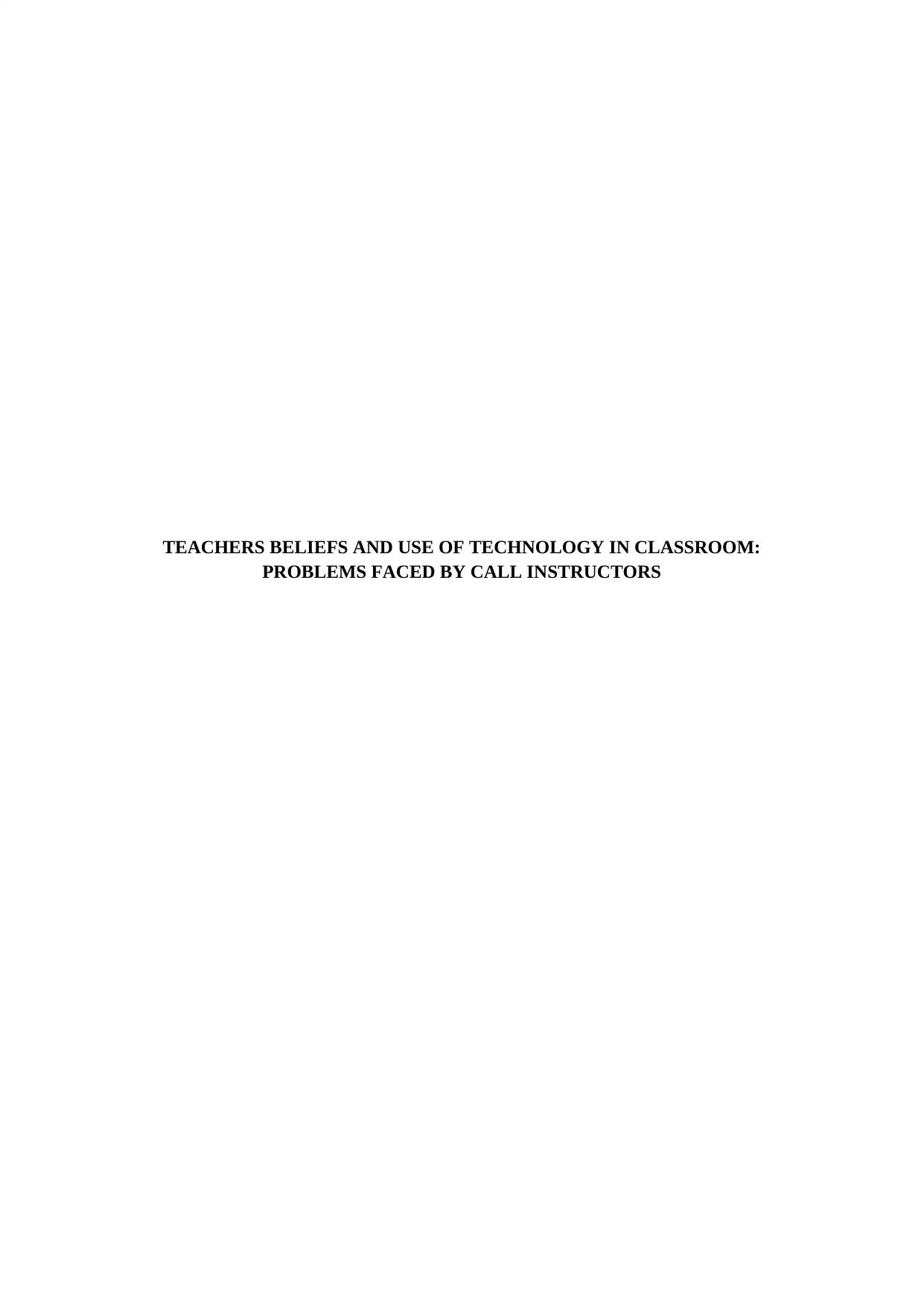
TEACHERS BELIEFS AND USE OF TECHNOLOGY IN CLASSROOM:
PROBLEMS FACED BY CALL INSTRUCTORS
PROBLEMS FACED BY CALL INSTRUCTORS
Secure Best Marks with AI Grader
Need help grading? Try our AI Grader for instant feedback on your assignments.
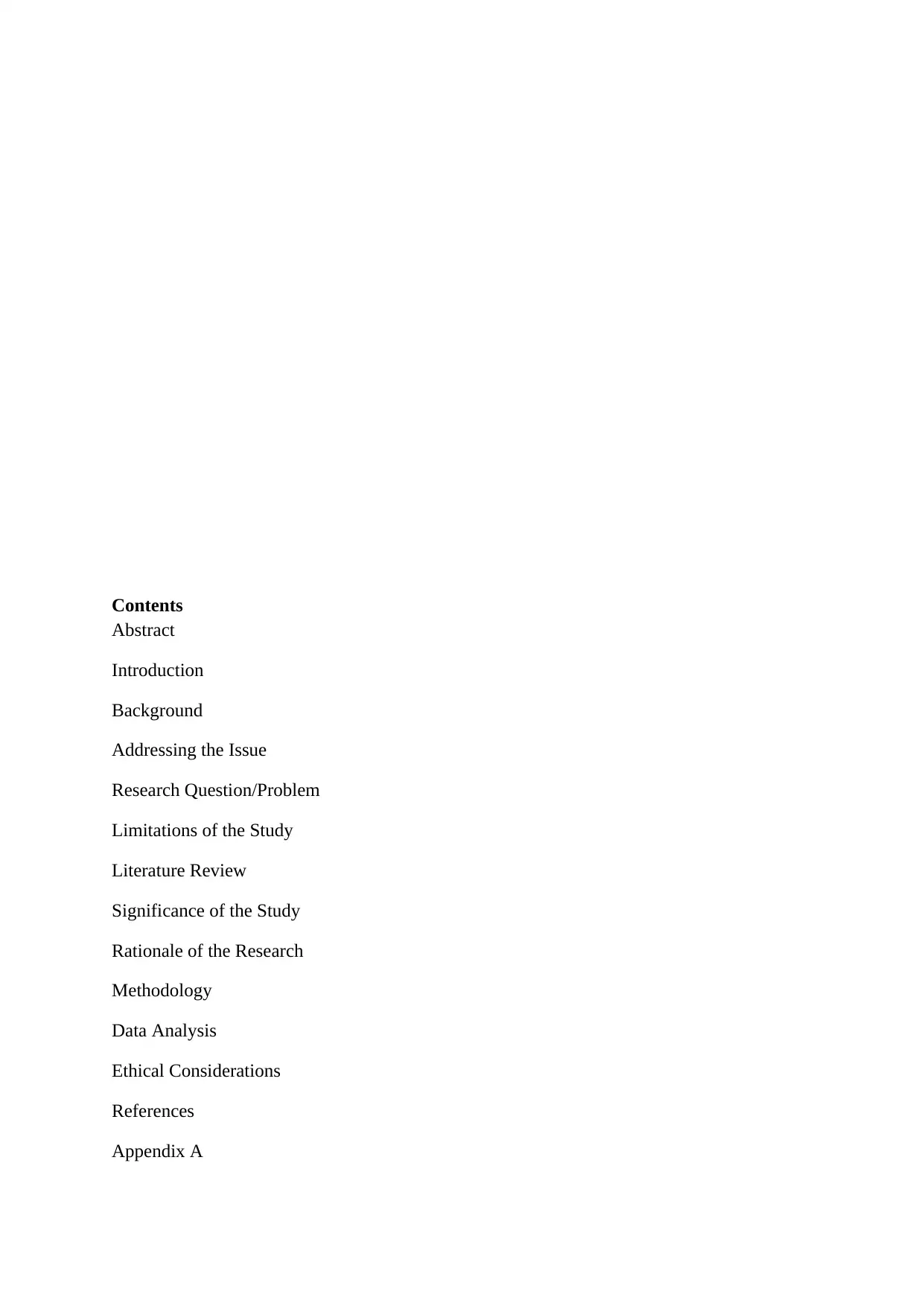
Contents
Abstract
Introduction
Background
Addressing the Issue
Research Question/Problem
Limitations of the Study
Literature Review
Significance of the Study
Rationale of the Research
Methodology
Data Analysis
Ethical Considerations
References
Appendix A
Abstract
Introduction
Background
Addressing the Issue
Research Question/Problem
Limitations of the Study
Literature Review
Significance of the Study
Rationale of the Research
Methodology
Data Analysis
Ethical Considerations
References
Appendix A
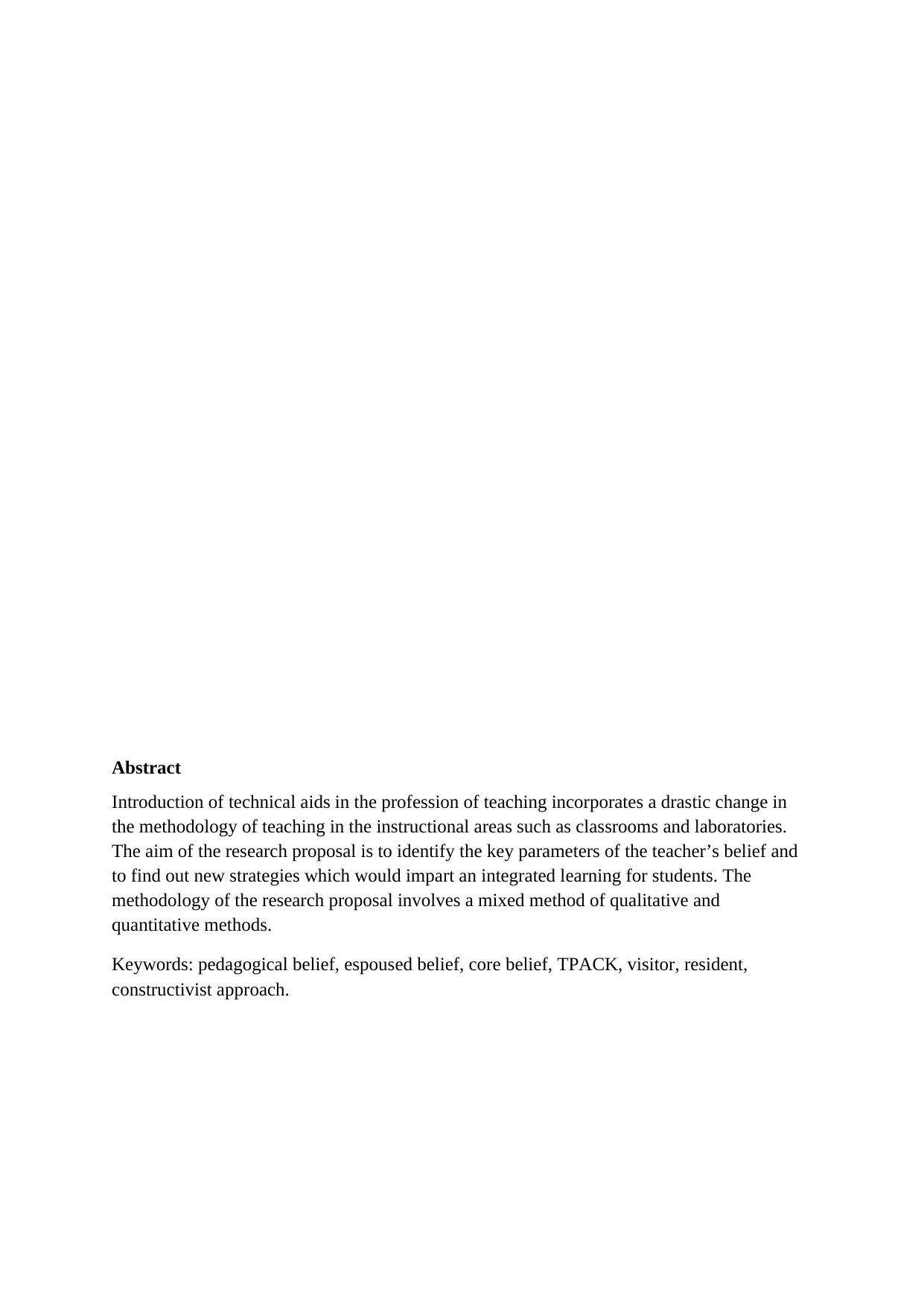
Abstract
Introduction of technical aids in the profession of teaching incorporates a drastic change in
the methodology of teaching in the instructional areas such as classrooms and laboratories.
The aim of the research proposal is to identify the key parameters of the teacher’s belief and
to find out new strategies which would impart an integrated learning for students. The
methodology of the research proposal involves a mixed method of qualitative and
quantitative methods.
Keywords: pedagogical belief, espoused belief, core belief, TPACK, visitor, resident,
constructivist approach.
Introduction of technical aids in the profession of teaching incorporates a drastic change in
the methodology of teaching in the instructional areas such as classrooms and laboratories.
The aim of the research proposal is to identify the key parameters of the teacher’s belief and
to find out new strategies which would impart an integrated learning for students. The
methodology of the research proposal involves a mixed method of qualitative and
quantitative methods.
Keywords: pedagogical belief, espoused belief, core belief, TPACK, visitor, resident,
constructivist approach.
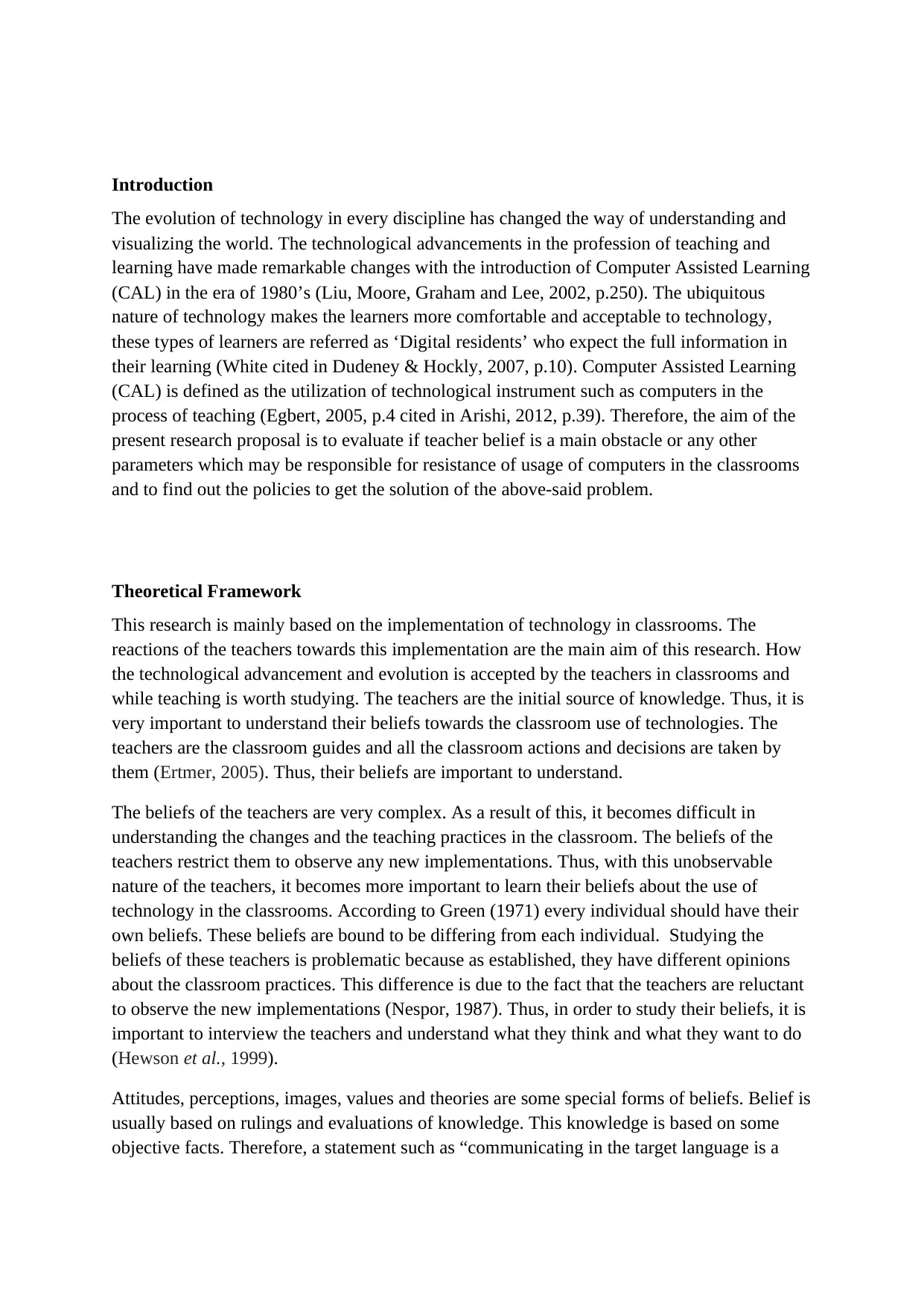
Introduction
The evolution of technology in every discipline has changed the way of understanding and
visualizing the world. The technological advancements in the profession of teaching and
learning have made remarkable changes with the introduction of Computer Assisted Learning
(CAL) in the era of 1980’s (Liu, Moore, Graham and Lee, 2002, p.250). The ubiquitous
nature of technology makes the learners more comfortable and acceptable to technology,
these types of learners are referred as ‘Digital residents’ who expect the full information in
their learning (White cited in Dudeney & Hockly, 2007, p.10). Computer Assisted Learning
(CAL) is defined as the utilization of technological instrument such as computers in the
process of teaching (Egbert, 2005, p.4 cited in Arishi, 2012, p.39). Therefore, the aim of the
present research proposal is to evaluate if teacher belief is a main obstacle or any other
parameters which may be responsible for resistance of usage of computers in the classrooms
and to find out the policies to get the solution of the above-said problem.
Theoretical Framework
This research is mainly based on the implementation of technology in classrooms. The
reactions of the teachers towards this implementation are the main aim of this research. How
the technological advancement and evolution is accepted by the teachers in classrooms and
while teaching is worth studying. The teachers are the initial source of knowledge. Thus, it is
very important to understand their beliefs towards the classroom use of technologies. The
teachers are the classroom guides and all the classroom actions and decisions are taken by
them (Ertmer, 2005). Thus, their beliefs are important to understand.
The beliefs of the teachers are very complex. As a result of this, it becomes difficult in
understanding the changes and the teaching practices in the classroom. The beliefs of the
teachers restrict them to observe any new implementations. Thus, with this unobservable
nature of the teachers, it becomes more important to learn their beliefs about the use of
technology in the classrooms. According to Green (1971) every individual should have their
own beliefs. These beliefs are bound to be differing from each individual. Studying the
beliefs of these teachers is problematic because as established, they have different opinions
about the classroom practices. This difference is due to the fact that the teachers are reluctant
to observe the new implementations (Nespor, 1987). Thus, in order to study their beliefs, it is
important to interview the teachers and understand what they think and what they want to do
(Hewson et al., 1999).
Attitudes, perceptions, images, values and theories are some special forms of beliefs. Belief is
usually based on rulings and evaluations of knowledge. This knowledge is based on some
objective facts. Therefore, a statement such as “communicating in the target language is a
The evolution of technology in every discipline has changed the way of understanding and
visualizing the world. The technological advancements in the profession of teaching and
learning have made remarkable changes with the introduction of Computer Assisted Learning
(CAL) in the era of 1980’s (Liu, Moore, Graham and Lee, 2002, p.250). The ubiquitous
nature of technology makes the learners more comfortable and acceptable to technology,
these types of learners are referred as ‘Digital residents’ who expect the full information in
their learning (White cited in Dudeney & Hockly, 2007, p.10). Computer Assisted Learning
(CAL) is defined as the utilization of technological instrument such as computers in the
process of teaching (Egbert, 2005, p.4 cited in Arishi, 2012, p.39). Therefore, the aim of the
present research proposal is to evaluate if teacher belief is a main obstacle or any other
parameters which may be responsible for resistance of usage of computers in the classrooms
and to find out the policies to get the solution of the above-said problem.
Theoretical Framework
This research is mainly based on the implementation of technology in classrooms. The
reactions of the teachers towards this implementation are the main aim of this research. How
the technological advancement and evolution is accepted by the teachers in classrooms and
while teaching is worth studying. The teachers are the initial source of knowledge. Thus, it is
very important to understand their beliefs towards the classroom use of technologies. The
teachers are the classroom guides and all the classroom actions and decisions are taken by
them (Ertmer, 2005). Thus, their beliefs are important to understand.
The beliefs of the teachers are very complex. As a result of this, it becomes difficult in
understanding the changes and the teaching practices in the classroom. The beliefs of the
teachers restrict them to observe any new implementations. Thus, with this unobservable
nature of the teachers, it becomes more important to learn their beliefs about the use of
technology in the classrooms. According to Green (1971) every individual should have their
own beliefs. These beliefs are bound to be differing from each individual. Studying the
beliefs of these teachers is problematic because as established, they have different opinions
about the classroom practices. This difference is due to the fact that the teachers are reluctant
to observe the new implementations (Nespor, 1987). Thus, in order to study their beliefs, it is
important to interview the teachers and understand what they think and what they want to do
(Hewson et al., 1999).
Attitudes, perceptions, images, values and theories are some special forms of beliefs. Belief is
usually based on rulings and evaluations of knowledge. This knowledge is based on some
objective facts. Therefore, a statement such as “communicating in the target language is a
Secure Best Marks with AI Grader
Need help grading? Try our AI Grader for instant feedback on your assignments.
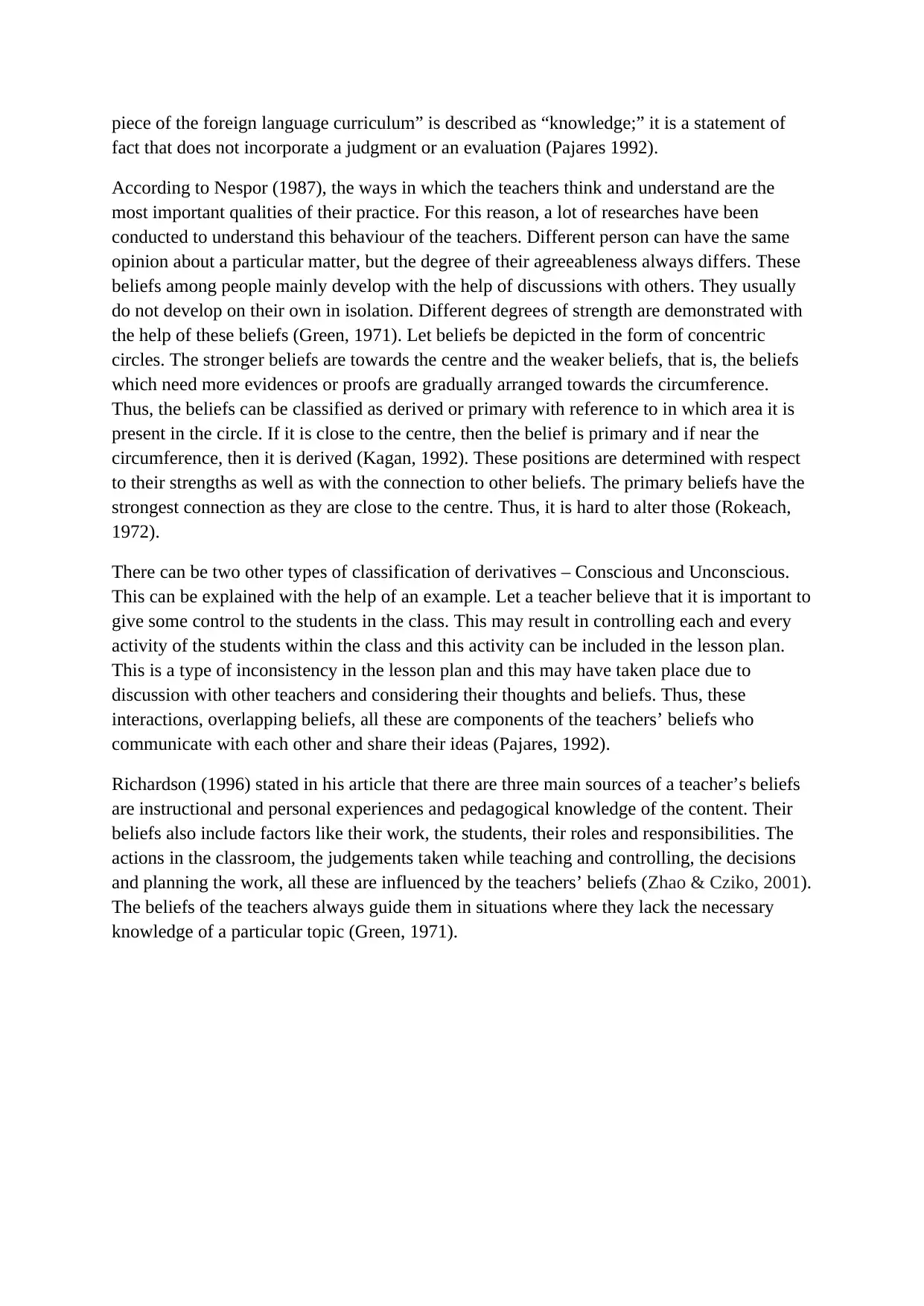
piece of the foreign language curriculum” is described as “knowledge;” it is a statement of
fact that does not incorporate a judgment or an evaluation (Pajares 1992).
According to Nespor (1987), the ways in which the teachers think and understand are the
most important qualities of their practice. For this reason, a lot of researches have been
conducted to understand this behaviour of the teachers. Different person can have the same
opinion about a particular matter, but the degree of their agreeableness always differs. These
beliefs among people mainly develop with the help of discussions with others. They usually
do not develop on their own in isolation. Different degrees of strength are demonstrated with
the help of these beliefs (Green, 1971). Let beliefs be depicted in the form of concentric
circles. The stronger beliefs are towards the centre and the weaker beliefs, that is, the beliefs
which need more evidences or proofs are gradually arranged towards the circumference.
Thus, the beliefs can be classified as derived or primary with reference to in which area it is
present in the circle. If it is close to the centre, then the belief is primary and if near the
circumference, then it is derived (Kagan, 1992). These positions are determined with respect
to their strengths as well as with the connection to other beliefs. The primary beliefs have the
strongest connection as they are close to the centre. Thus, it is hard to alter those (Rokeach,
1972).
There can be two other types of classification of derivatives – Conscious and Unconscious.
This can be explained with the help of an example. Let a teacher believe that it is important to
give some control to the students in the class. This may result in controlling each and every
activity of the students within the class and this activity can be included in the lesson plan.
This is a type of inconsistency in the lesson plan and this may have taken place due to
discussion with other teachers and considering their thoughts and beliefs. Thus, these
interactions, overlapping beliefs, all these are components of the teachers’ beliefs who
communicate with each other and share their ideas (Pajares, 1992).
Richardson (1996) stated in his article that there are three main sources of a teacher’s beliefs
are instructional and personal experiences and pedagogical knowledge of the content. Their
beliefs also include factors like their work, the students, their roles and responsibilities. The
actions in the classroom, the judgements taken while teaching and controlling, the decisions
and planning the work, all these are influenced by the teachers’ beliefs (Zhao & Cziko, 2001).
The beliefs of the teachers always guide them in situations where they lack the necessary
knowledge of a particular topic (Green, 1971).
fact that does not incorporate a judgment or an evaluation (Pajares 1992).
According to Nespor (1987), the ways in which the teachers think and understand are the
most important qualities of their practice. For this reason, a lot of researches have been
conducted to understand this behaviour of the teachers. Different person can have the same
opinion about a particular matter, but the degree of their agreeableness always differs. These
beliefs among people mainly develop with the help of discussions with others. They usually
do not develop on their own in isolation. Different degrees of strength are demonstrated with
the help of these beliefs (Green, 1971). Let beliefs be depicted in the form of concentric
circles. The stronger beliefs are towards the centre and the weaker beliefs, that is, the beliefs
which need more evidences or proofs are gradually arranged towards the circumference.
Thus, the beliefs can be classified as derived or primary with reference to in which area it is
present in the circle. If it is close to the centre, then the belief is primary and if near the
circumference, then it is derived (Kagan, 1992). These positions are determined with respect
to their strengths as well as with the connection to other beliefs. The primary beliefs have the
strongest connection as they are close to the centre. Thus, it is hard to alter those (Rokeach,
1972).
There can be two other types of classification of derivatives – Conscious and Unconscious.
This can be explained with the help of an example. Let a teacher believe that it is important to
give some control to the students in the class. This may result in controlling each and every
activity of the students within the class and this activity can be included in the lesson plan.
This is a type of inconsistency in the lesson plan and this may have taken place due to
discussion with other teachers and considering their thoughts and beliefs. Thus, these
interactions, overlapping beliefs, all these are components of the teachers’ beliefs who
communicate with each other and share their ideas (Pajares, 1992).
Richardson (1996) stated in his article that there are three main sources of a teacher’s beliefs
are instructional and personal experiences and pedagogical knowledge of the content. Their
beliefs also include factors like their work, the students, their roles and responsibilities. The
actions in the classroom, the judgements taken while teaching and controlling, the decisions
and planning the work, all these are influenced by the teachers’ beliefs (Zhao & Cziko, 2001).
The beliefs of the teachers always guide them in situations where they lack the necessary
knowledge of a particular topic (Green, 1971).

Background
Technology has become the centre piece of educational reform owing to its unparalleled
capabilities which offer methods to improve students’ learning abilities, which has caused
several types of technological resources to be equipped in schools (ISTE, 2000; Sivin-
Kachala&Bialo, 2000). However, mere inclusion of technology by the authorities is not
sufficient to induce technologically aided learning, and it is necessary to provide training to
the teachers in order to enable them to utilize training in the classrooms. A close analysis of
the integration paradigm in the field of teaching reveals that the beliefs of teachers had a
significant impact on how they viewed and utilized technology in their classrooms.
Subsequently, another dimension which is of significance is the integration of these
technologies in the classroom which has been outlined hereon.
In the general and historical context, teachers’ primary response to external influences – such
as technological developments – have varied greatly with some accepting the changes, while
others strive to ignore or bypass them altogether (Ottenbreit-Leftwich, et al, 2010). Several
studies carried out by scholars, such as Andrew (2007) reveal the fact that teachers with
constructivist beliefs held a more positive approach to technology based teaching and utilized
computers and other technologies to teach syllabi content which is student centric. Hermans
and his peers (2008) built upon this sentiment by stating that apart from constructivist beliefs,
teachers with traditional beliefs are also able to inculcate technology in the classroom, albeit,
with the limitation of only being able to focus on a teacher focused curriculum. However, the
above disambiguation is not absolute as revealed by Ertmer and his peers’ (2001) study
which detailed that teachers enacted and espoused beliefs also differed with a major example
being constructivist belief holder teachers often used technology in a very traditional manner,
which was limited to computer based tests and practices. This lack of absoluteness in beliefs
and their impact on the usage of technology reveals the fact that there exists some leeway
which can allow for the alteration of teachers’ inherent beliefs and how they utilize them in
the classroom.
The above review reveals the fact that beliefs and technology both have a significant role to
play in the classroom, but, when viewed from the teacher’s point of view, the belief held by
the teacher shall always trump external developments. However, simultaneously, these
beliefs are not set in concrete and can be altered with the right tools, such as training
programs (Ertmer, et al, 2012). These measures shall allow teachers to retain their espoused
beliefs while also changing their enacted beliefs to inculcate technology in the classroom,
essentially creating a balanced trade-off.
The above review makes it evident that beliefs and technology play a significant role in
determining the outlook of the constituents of a classroom, necessitating that these two
attributes integrate well into each other in order to make the classroom a cohesive centre of
learning. While beliefs shall always be important to the teacher, it is imperative for the
authorities to push the inclusion of technology in the classroom and cultivate a training
program which provides the teachers with necessary faculties to inculcate technologies into
Technology has become the centre piece of educational reform owing to its unparalleled
capabilities which offer methods to improve students’ learning abilities, which has caused
several types of technological resources to be equipped in schools (ISTE, 2000; Sivin-
Kachala&Bialo, 2000). However, mere inclusion of technology by the authorities is not
sufficient to induce technologically aided learning, and it is necessary to provide training to
the teachers in order to enable them to utilize training in the classrooms. A close analysis of
the integration paradigm in the field of teaching reveals that the beliefs of teachers had a
significant impact on how they viewed and utilized technology in their classrooms.
Subsequently, another dimension which is of significance is the integration of these
technologies in the classroom which has been outlined hereon.
In the general and historical context, teachers’ primary response to external influences – such
as technological developments – have varied greatly with some accepting the changes, while
others strive to ignore or bypass them altogether (Ottenbreit-Leftwich, et al, 2010). Several
studies carried out by scholars, such as Andrew (2007) reveal the fact that teachers with
constructivist beliefs held a more positive approach to technology based teaching and utilized
computers and other technologies to teach syllabi content which is student centric. Hermans
and his peers (2008) built upon this sentiment by stating that apart from constructivist beliefs,
teachers with traditional beliefs are also able to inculcate technology in the classroom, albeit,
with the limitation of only being able to focus on a teacher focused curriculum. However, the
above disambiguation is not absolute as revealed by Ertmer and his peers’ (2001) study
which detailed that teachers enacted and espoused beliefs also differed with a major example
being constructivist belief holder teachers often used technology in a very traditional manner,
which was limited to computer based tests and practices. This lack of absoluteness in beliefs
and their impact on the usage of technology reveals the fact that there exists some leeway
which can allow for the alteration of teachers’ inherent beliefs and how they utilize them in
the classroom.
The above review reveals the fact that beliefs and technology both have a significant role to
play in the classroom, but, when viewed from the teacher’s point of view, the belief held by
the teacher shall always trump external developments. However, simultaneously, these
beliefs are not set in concrete and can be altered with the right tools, such as training
programs (Ertmer, et al, 2012). These measures shall allow teachers to retain their espoused
beliefs while also changing their enacted beliefs to inculcate technology in the classroom,
essentially creating a balanced trade-off.
The above review makes it evident that beliefs and technology play a significant role in
determining the outlook of the constituents of a classroom, necessitating that these two
attributes integrate well into each other in order to make the classroom a cohesive centre of
learning. While beliefs shall always be important to the teacher, it is imperative for the
authorities to push the inclusion of technology in the classroom and cultivate a training
program which provides the teachers with necessary faculties to inculcate technologies into
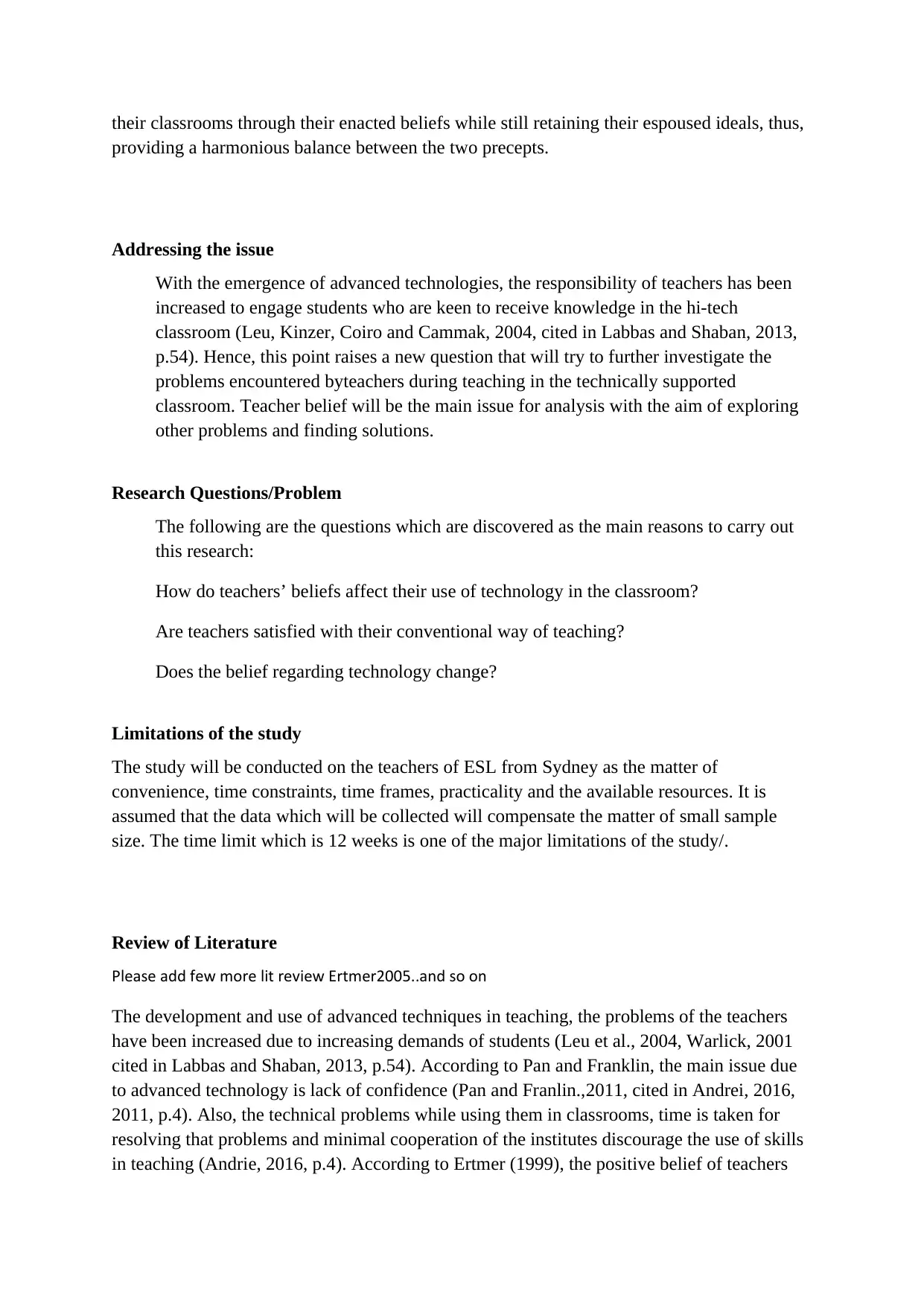
their classrooms through their enacted beliefs while still retaining their espoused ideals, thus,
providing a harmonious balance between the two precepts.
Addressing the issue
With the emergence of advanced technologies, the responsibility of teachers has been
increased to engage students who are keen to receive knowledge in the hi-tech
classroom (Leu, Kinzer, Coiro and Cammak, 2004, cited in Labbas and Shaban, 2013,
p.54). Hence, this point raises a new question that will try to further investigate the
problems encountered byteachers during teaching in the technically supported
classroom. Teacher belief will be the main issue for analysis with the aim of exploring
other problems and finding solutions.
Research Questions/Problem
The following are the questions which are discovered as the main reasons to carry out
this research:
How do teachers’ beliefs affect their use of technology in the classroom?
Are teachers satisfied with their conventional way of teaching?
Does the belief regarding technology change?
Limitations of the study
The study will be conducted on the teachers of ESL from Sydney as the matter of
convenience, time constraints, time frames, practicality and the available resources. It is
assumed that the data which will be collected will compensate the matter of small sample
size. The time limit which is 12 weeks is one of the major limitations of the study/.
Review of Literature
Please add few more lit review Ertmer2005..and so on
The development and use of advanced techniques in teaching, the problems of the teachers
have been increased due to increasing demands of students (Leu et al., 2004, Warlick, 2001
cited in Labbas and Shaban, 2013, p.54). According to Pan and Franklin, the main issue due
to advanced technology is lack of confidence (Pan and Franlin.,2011, cited in Andrei, 2016,
2011, p.4). Also, the technical problems while using them in classrooms, time is taken for
resolving that problems and minimal cooperation of the institutes discourage the use of skills
in teaching (Andrie, 2016, p.4). According to Ertmer (1999), the positive belief of teachers
providing a harmonious balance between the two precepts.
Addressing the issue
With the emergence of advanced technologies, the responsibility of teachers has been
increased to engage students who are keen to receive knowledge in the hi-tech
classroom (Leu, Kinzer, Coiro and Cammak, 2004, cited in Labbas and Shaban, 2013,
p.54). Hence, this point raises a new question that will try to further investigate the
problems encountered byteachers during teaching in the technically supported
classroom. Teacher belief will be the main issue for analysis with the aim of exploring
other problems and finding solutions.
Research Questions/Problem
The following are the questions which are discovered as the main reasons to carry out
this research:
How do teachers’ beliefs affect their use of technology in the classroom?
Are teachers satisfied with their conventional way of teaching?
Does the belief regarding technology change?
Limitations of the study
The study will be conducted on the teachers of ESL from Sydney as the matter of
convenience, time constraints, time frames, practicality and the available resources. It is
assumed that the data which will be collected will compensate the matter of small sample
size. The time limit which is 12 weeks is one of the major limitations of the study/.
Review of Literature
Please add few more lit review Ertmer2005..and so on
The development and use of advanced techniques in teaching, the problems of the teachers
have been increased due to increasing demands of students (Leu et al., 2004, Warlick, 2001
cited in Labbas and Shaban, 2013, p.54). According to Pan and Franklin, the main issue due
to advanced technology is lack of confidence (Pan and Franlin.,2011, cited in Andrei, 2016,
2011, p.4). Also, the technical problems while using them in classrooms, time is taken for
resolving that problems and minimal cooperation of the institutes discourage the use of skills
in teaching (Andrie, 2016, p.4). According to Ertmer (1999), the positive belief of teachers
Paraphrase This Document
Need a fresh take? Get an instant paraphrase of this document with our AI Paraphraser
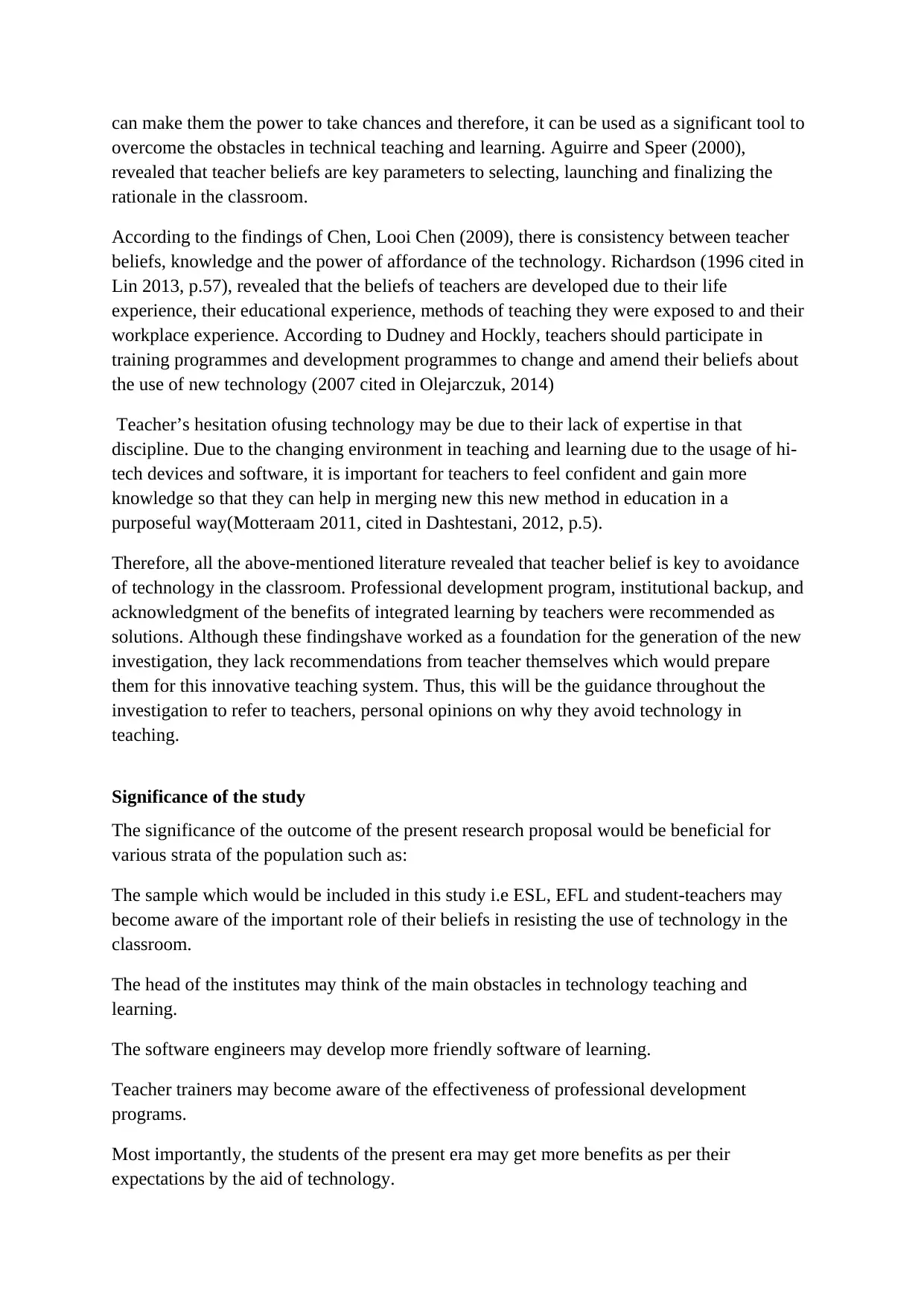
can make them the power to take chances and therefore, it can be used as a significant tool to
overcome the obstacles in technical teaching and learning. Aguirre and Speer (2000),
revealed that teacher beliefs are key parameters to selecting, launching and finalizing the
rationale in the classroom.
According to the findings of Chen, Looi Chen (2009), there is consistency between teacher
beliefs, knowledge and the power of affordance of the technology. Richardson (1996 cited in
Lin 2013, p.57), revealed that the beliefs of teachers are developed due to their life
experience, their educational experience, methods of teaching they were exposed to and their
workplace experience. According to Dudney and Hockly, teachers should participate in
training programmes and development programmes to change and amend their beliefs about
the use of new technology (2007 cited in Olejarczuk, 2014)
Teacher’s hesitation ofusing technology may be due to their lack of expertise in that
discipline. Due to the changing environment in teaching and learning due to the usage of hi-
tech devices and software, it is important for teachers to feel confident and gain more
knowledge so that they can help in merging new this new method in education in a
purposeful way(Motteraam 2011, cited in Dashtestani, 2012, p.5).
Therefore, all the above-mentioned literature revealed that teacher belief is key to avoidance
of technology in the classroom. Professional development program, institutional backup, and
acknowledgment of the benefits of integrated learning by teachers were recommended as
solutions. Although these findingshave worked as a foundation for the generation of the new
investigation, they lack recommendations from teacher themselves which would prepare
them for this innovative teaching system. Thus, this will be the guidance throughout the
investigation to refer to teachers, personal opinions on why they avoid technology in
teaching.
Significance of the study
The significance of the outcome of the present research proposal would be beneficial for
various strata of the population such as:
The sample which would be included in this study i.e ESL, EFL and student-teachers may
become aware of the important role of their beliefs in resisting the use of technology in the
classroom.
The head of the institutes may think of the main obstacles in technology teaching and
learning.
The software engineers may develop more friendly software of learning.
Teacher trainers may become aware of the effectiveness of professional development
programs.
Most importantly, the students of the present era may get more benefits as per their
expectations by the aid of technology.
overcome the obstacles in technical teaching and learning. Aguirre and Speer (2000),
revealed that teacher beliefs are key parameters to selecting, launching and finalizing the
rationale in the classroom.
According to the findings of Chen, Looi Chen (2009), there is consistency between teacher
beliefs, knowledge and the power of affordance of the technology. Richardson (1996 cited in
Lin 2013, p.57), revealed that the beliefs of teachers are developed due to their life
experience, their educational experience, methods of teaching they were exposed to and their
workplace experience. According to Dudney and Hockly, teachers should participate in
training programmes and development programmes to change and amend their beliefs about
the use of new technology (2007 cited in Olejarczuk, 2014)
Teacher’s hesitation ofusing technology may be due to their lack of expertise in that
discipline. Due to the changing environment in teaching and learning due to the usage of hi-
tech devices and software, it is important for teachers to feel confident and gain more
knowledge so that they can help in merging new this new method in education in a
purposeful way(Motteraam 2011, cited in Dashtestani, 2012, p.5).
Therefore, all the above-mentioned literature revealed that teacher belief is key to avoidance
of technology in the classroom. Professional development program, institutional backup, and
acknowledgment of the benefits of integrated learning by teachers were recommended as
solutions. Although these findingshave worked as a foundation for the generation of the new
investigation, they lack recommendations from teacher themselves which would prepare
them for this innovative teaching system. Thus, this will be the guidance throughout the
investigation to refer to teachers, personal opinions on why they avoid technology in
teaching.
Significance of the study
The significance of the outcome of the present research proposal would be beneficial for
various strata of the population such as:
The sample which would be included in this study i.e ESL, EFL and student-teachers may
become aware of the important role of their beliefs in resisting the use of technology in the
classroom.
The head of the institutes may think of the main obstacles in technology teaching and
learning.
The software engineers may develop more friendly software of learning.
Teacher trainers may become aware of the effectiveness of professional development
programs.
Most importantly, the students of the present era may get more benefits as per their
expectations by the aid of technology.
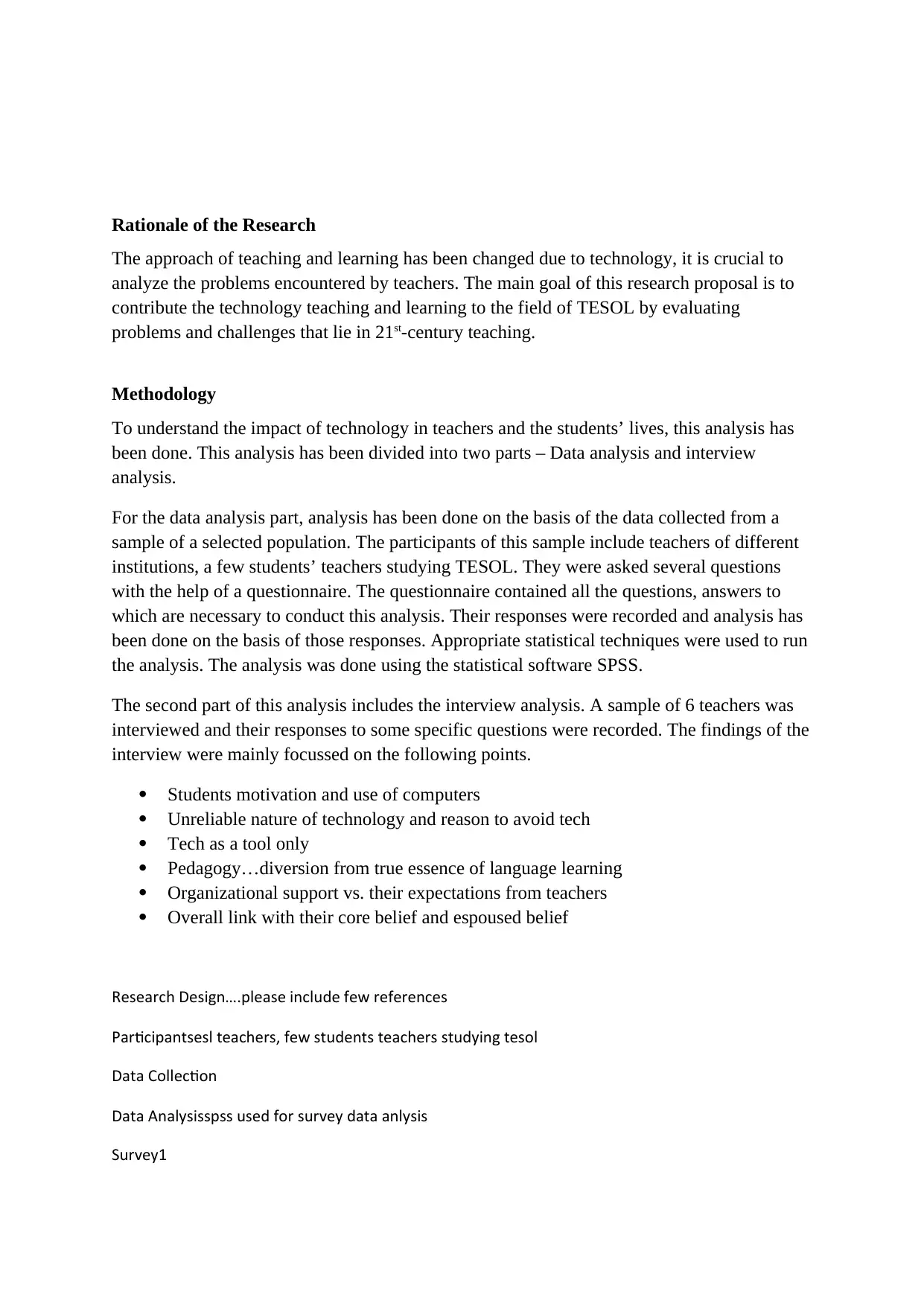
Rationale of the Research
The approach of teaching and learning has been changed due to technology, it is crucial to
analyze the problems encountered by teachers. The main goal of this research proposal is to
contribute the technology teaching and learning to the field of TESOL by evaluating
problems and challenges that lie in 21st-century teaching.
Methodology
To understand the impact of technology in teachers and the students’ lives, this analysis has
been done. This analysis has been divided into two parts – Data analysis and interview
analysis.
For the data analysis part, analysis has been done on the basis of the data collected from a
sample of a selected population. The participants of this sample include teachers of different
institutions, a few students’ teachers studying TESOL. They were asked several questions
with the help of a questionnaire. The questionnaire contained all the questions, answers to
which are necessary to conduct this analysis. Their responses were recorded and analysis has
been done on the basis of those responses. Appropriate statistical techniques were used to run
the analysis. The analysis was done using the statistical software SPSS.
The second part of this analysis includes the interview analysis. A sample of 6 teachers was
interviewed and their responses to some specific questions were recorded. The findings of the
interview were mainly focussed on the following points.
Students motivation and use of computers
Unreliable nature of technology and reason to avoid tech
Tech as a tool only
Pedagogy…diversion from true essence of language learning
Organizational support vs. their expectations from teachers
Overall link with their core belief and espoused belief
Research Design….please include few references
Participantsesl teachers, few students teachers studying tesol
Data Collection
Data Analysisspss used for survey data anlysis
Survey1
The approach of teaching and learning has been changed due to technology, it is crucial to
analyze the problems encountered by teachers. The main goal of this research proposal is to
contribute the technology teaching and learning to the field of TESOL by evaluating
problems and challenges that lie in 21st-century teaching.
Methodology
To understand the impact of technology in teachers and the students’ lives, this analysis has
been done. This analysis has been divided into two parts – Data analysis and interview
analysis.
For the data analysis part, analysis has been done on the basis of the data collected from a
sample of a selected population. The participants of this sample include teachers of different
institutions, a few students’ teachers studying TESOL. They were asked several questions
with the help of a questionnaire. The questionnaire contained all the questions, answers to
which are necessary to conduct this analysis. Their responses were recorded and analysis has
been done on the basis of those responses. Appropriate statistical techniques were used to run
the analysis. The analysis was done using the statistical software SPSS.
The second part of this analysis includes the interview analysis. A sample of 6 teachers was
interviewed and their responses to some specific questions were recorded. The findings of the
interview were mainly focussed on the following points.
Students motivation and use of computers
Unreliable nature of technology and reason to avoid tech
Tech as a tool only
Pedagogy…diversion from true essence of language learning
Organizational support vs. their expectations from teachers
Overall link with their core belief and espoused belief
Research Design….please include few references
Participantsesl teachers, few students teachers studying tesol
Data Collection
Data Analysisspss used for survey data anlysis
Survey1
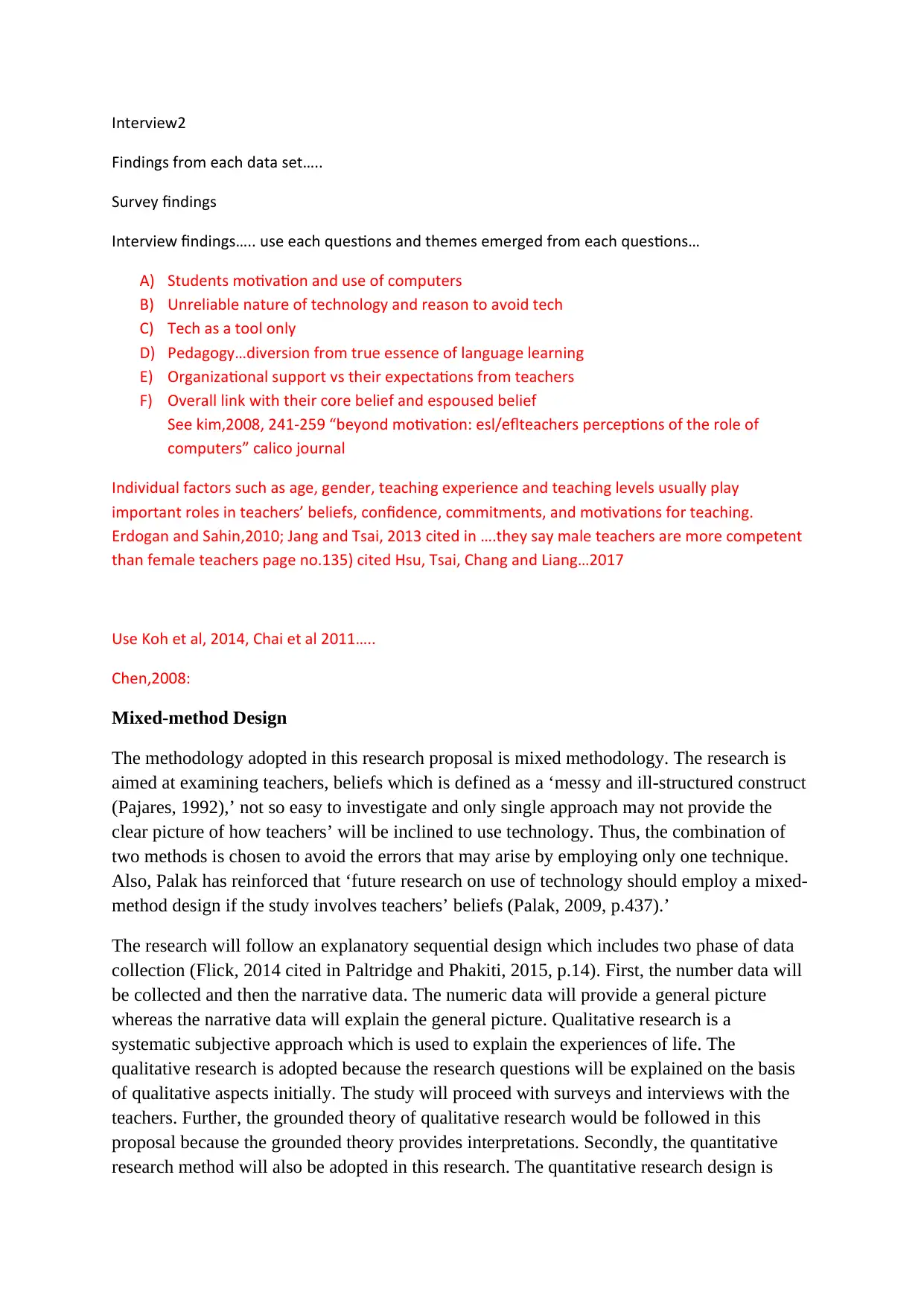
Interview2
Findings from each data set…..
Survey findings
Interview findings….. use each questions and themes emerged from each questions…
A) Students motivation and use of computers
B) Unreliable nature of technology and reason to avoid tech
C) Tech as a tool only
D) Pedagogy…diversion from true essence of language learning
E) Organizational support vs their expectations from teachers
F) Overall link with their core belief and espoused belief
See kim,2008, 241-259 “beyond motivation: esl/eflteachers perceptions of the role of
computers” calico journal
Individual factors such as age, gender, teaching experience and teaching levels usually play
important roles in teachers’ beliefs, confidence, commitments, and motivations for teaching.
Erdogan and Sahin,2010; Jang and Tsai, 2013 cited in ….they say male teachers are more competent
than female teachers page no.135) cited Hsu, Tsai, Chang and Liang…2017
Use Koh et al, 2014, Chai et al 2011…..
Chen,2008:
Mixed-method Design
The methodology adopted in this research proposal is mixed methodology. The research is
aimed at examining teachers, beliefs which is defined as a ‘messy and ill-structured construct
(Pajares, 1992),’ not so easy to investigate and only single approach may not provide the
clear picture of how teachers’ will be inclined to use technology. Thus, the combination of
two methods is chosen to avoid the errors that may arise by employing only one technique.
Also, Palak has reinforced that ‘future research on use of technology should employ a mixed-
method design if the study involves teachers’ beliefs (Palak, 2009, p.437).’
The research will follow an explanatory sequential design which includes two phase of data
collection (Flick, 2014 cited in Paltridge and Phakiti, 2015, p.14). First, the number data will
be collected and then the narrative data. The numeric data will provide a general picture
whereas the narrative data will explain the general picture. Qualitative research is a
systematic subjective approach which is used to explain the experiences of life. The
qualitative research is adopted because the research questions will be explained on the basis
of qualitative aspects initially. The study will proceed with surveys and interviews with the
teachers. Further, the grounded theory of qualitative research would be followed in this
proposal because the grounded theory provides interpretations. Secondly, the quantitative
research method will also be adopted in this research. The quantitative research design is
Findings from each data set…..
Survey findings
Interview findings….. use each questions and themes emerged from each questions…
A) Students motivation and use of computers
B) Unreliable nature of technology and reason to avoid tech
C) Tech as a tool only
D) Pedagogy…diversion from true essence of language learning
E) Organizational support vs their expectations from teachers
F) Overall link with their core belief and espoused belief
See kim,2008, 241-259 “beyond motivation: esl/eflteachers perceptions of the role of
computers” calico journal
Individual factors such as age, gender, teaching experience and teaching levels usually play
important roles in teachers’ beliefs, confidence, commitments, and motivations for teaching.
Erdogan and Sahin,2010; Jang and Tsai, 2013 cited in ….they say male teachers are more competent
than female teachers page no.135) cited Hsu, Tsai, Chang and Liang…2017
Use Koh et al, 2014, Chai et al 2011…..
Chen,2008:
Mixed-method Design
The methodology adopted in this research proposal is mixed methodology. The research is
aimed at examining teachers, beliefs which is defined as a ‘messy and ill-structured construct
(Pajares, 1992),’ not so easy to investigate and only single approach may not provide the
clear picture of how teachers’ will be inclined to use technology. Thus, the combination of
two methods is chosen to avoid the errors that may arise by employing only one technique.
Also, Palak has reinforced that ‘future research on use of technology should employ a mixed-
method design if the study involves teachers’ beliefs (Palak, 2009, p.437).’
The research will follow an explanatory sequential design which includes two phase of data
collection (Flick, 2014 cited in Paltridge and Phakiti, 2015, p.14). First, the number data will
be collected and then the narrative data. The numeric data will provide a general picture
whereas the narrative data will explain the general picture. Qualitative research is a
systematic subjective approach which is used to explain the experiences of life. The
qualitative research is adopted because the research questions will be explained on the basis
of qualitative aspects initially. The study will proceed with surveys and interviews with the
teachers. Further, the grounded theory of qualitative research would be followed in this
proposal because the grounded theory provides interpretations. Secondly, the quantitative
research method will also be adopted in this research. The quantitative research design is
Secure Best Marks with AI Grader
Need help grading? Try our AI Grader for instant feedback on your assignments.

useful in describing the relationships and examine the cause and effect relationship between
two variables. Further, to maximize the quality of data and to avoid subjective centralization
of the findings qualitative and quantitative research methods will be merged together.
two variables. Further, to maximize the quality of data and to avoid subjective centralization
of the findings qualitative and quantitative research methods will be merged together.
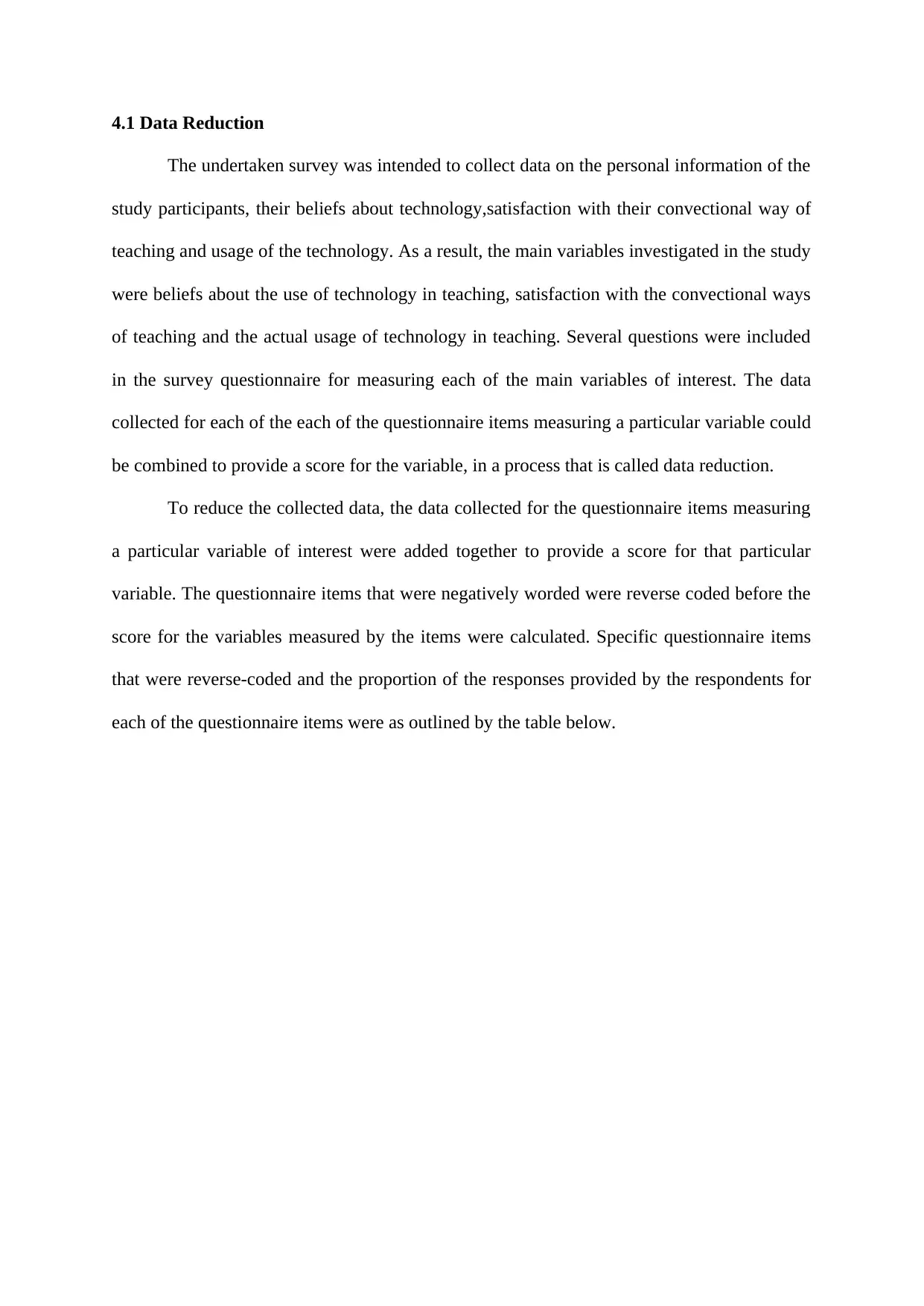
4.1 Data Reduction
The undertaken survey was intended to collect data on the personal information of the
study participants, their beliefs about technology,satisfaction with their convectional way of
teaching and usage of the technology. As a result, the main variables investigated in the study
were beliefs about the use of technology in teaching, satisfaction with the convectional ways
of teaching and the actual usage of technology in teaching. Several questions were included
in the survey questionnaire for measuring each of the main variables of interest. The data
collected for each of the each of the questionnaire items measuring a particular variable could
be combined to provide a score for the variable, in a process that is called data reduction.
To reduce the collected data, the data collected for the questionnaire items measuring
a particular variable of interest were added together to provide a score for that particular
variable. The questionnaire items that were negatively worded were reverse coded before the
score for the variables measured by the items were calculated. Specific questionnaire items
that were reverse-coded and the proportion of the responses provided by the respondents for
each of the questionnaire items were as outlined by the table below.
The undertaken survey was intended to collect data on the personal information of the
study participants, their beliefs about technology,satisfaction with their convectional way of
teaching and usage of the technology. As a result, the main variables investigated in the study
were beliefs about the use of technology in teaching, satisfaction with the convectional ways
of teaching and the actual usage of technology in teaching. Several questions were included
in the survey questionnaire for measuring each of the main variables of interest. The data
collected for each of the each of the questionnaire items measuring a particular variable could
be combined to provide a score for the variable, in a process that is called data reduction.
To reduce the collected data, the data collected for the questionnaire items measuring
a particular variable of interest were added together to provide a score for that particular
variable. The questionnaire items that were negatively worded were reverse coded before the
score for the variables measured by the items were calculated. Specific questionnaire items
that were reverse-coded and the proportion of the responses provided by the respondents for
each of the questionnaire items were as outlined by the table below.
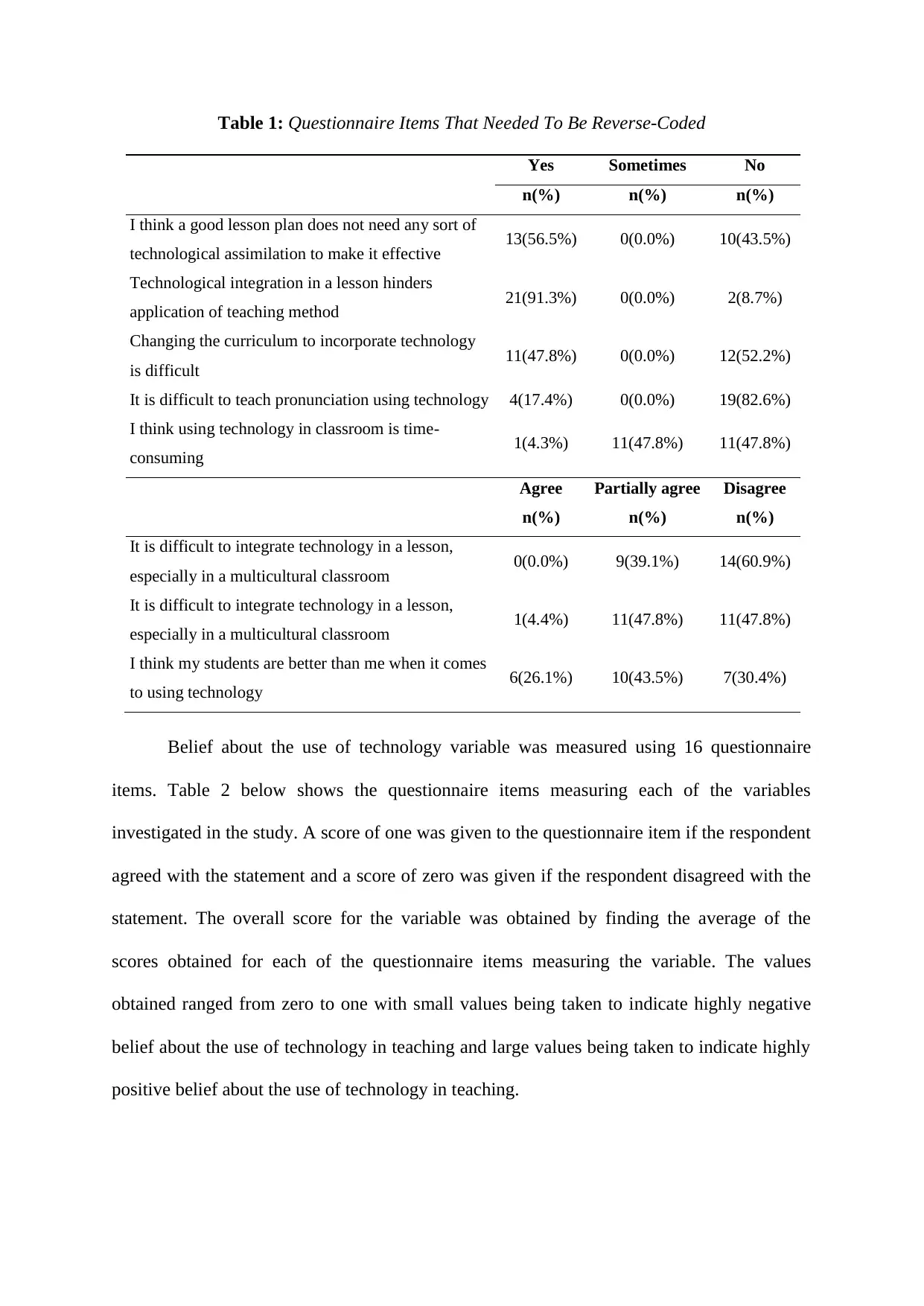
Table 1: Questionnaire Items That Needed To Be Reverse-Coded
Yes Sometimes No
n(%) n(%) n(%)
I think a good lesson plan does not need any sort of
technological assimilation to make it effective 13(56.5%) 0(0.0%) 10(43.5%)
Technological integration in a lesson hinders
application of teaching method 21(91.3%) 0(0.0%) 2(8.7%)
Changing the curriculum to incorporate technology
is difficult 11(47.8%) 0(0.0%) 12(52.2%)
It is difficult to teach pronunciation using technology 4(17.4%) 0(0.0%) 19(82.6%)
I think using technology in classroom is time-
consuming 1(4.3%) 11(47.8%) 11(47.8%)
Agree Partially agree Disagree
n(%) n(%) n(%)
It is difficult to integrate technology in a lesson,
especially in a multicultural classroom 0(0.0%) 9(39.1%) 14(60.9%)
It is difficult to integrate technology in a lesson,
especially in a multicultural classroom 1(4.4%) 11(47.8%) 11(47.8%)
I think my students are better than me when it comes
to using technology 6(26.1%) 10(43.5%) 7(30.4%)
Belief about the use of technology variable was measured using 16 questionnaire
items. Table 2 below shows the questionnaire items measuring each of the variables
investigated in the study. A score of one was given to the questionnaire item if the respondent
agreed with the statement and a score of zero was given if the respondent disagreed with the
statement. The overall score for the variable was obtained by finding the average of the
scores obtained for each of the questionnaire items measuring the variable. The values
obtained ranged from zero to one with small values being taken to indicate highly negative
belief about the use of technology in teaching and large values being taken to indicate highly
positive belief about the use of technology in teaching.
Yes Sometimes No
n(%) n(%) n(%)
I think a good lesson plan does not need any sort of
technological assimilation to make it effective 13(56.5%) 0(0.0%) 10(43.5%)
Technological integration in a lesson hinders
application of teaching method 21(91.3%) 0(0.0%) 2(8.7%)
Changing the curriculum to incorporate technology
is difficult 11(47.8%) 0(0.0%) 12(52.2%)
It is difficult to teach pronunciation using technology 4(17.4%) 0(0.0%) 19(82.6%)
I think using technology in classroom is time-
consuming 1(4.3%) 11(47.8%) 11(47.8%)
Agree Partially agree Disagree
n(%) n(%) n(%)
It is difficult to integrate technology in a lesson,
especially in a multicultural classroom 0(0.0%) 9(39.1%) 14(60.9%)
It is difficult to integrate technology in a lesson,
especially in a multicultural classroom 1(4.4%) 11(47.8%) 11(47.8%)
I think my students are better than me when it comes
to using technology 6(26.1%) 10(43.5%) 7(30.4%)
Belief about the use of technology variable was measured using 16 questionnaire
items. Table 2 below shows the questionnaire items measuring each of the variables
investigated in the study. A score of one was given to the questionnaire item if the respondent
agreed with the statement and a score of zero was given if the respondent disagreed with the
statement. The overall score for the variable was obtained by finding the average of the
scores obtained for each of the questionnaire items measuring the variable. The values
obtained ranged from zero to one with small values being taken to indicate highly negative
belief about the use of technology in teaching and large values being taken to indicate highly
positive belief about the use of technology in teaching.
Paraphrase This Document
Need a fresh take? Get an instant paraphrase of this document with our AI Paraphraser
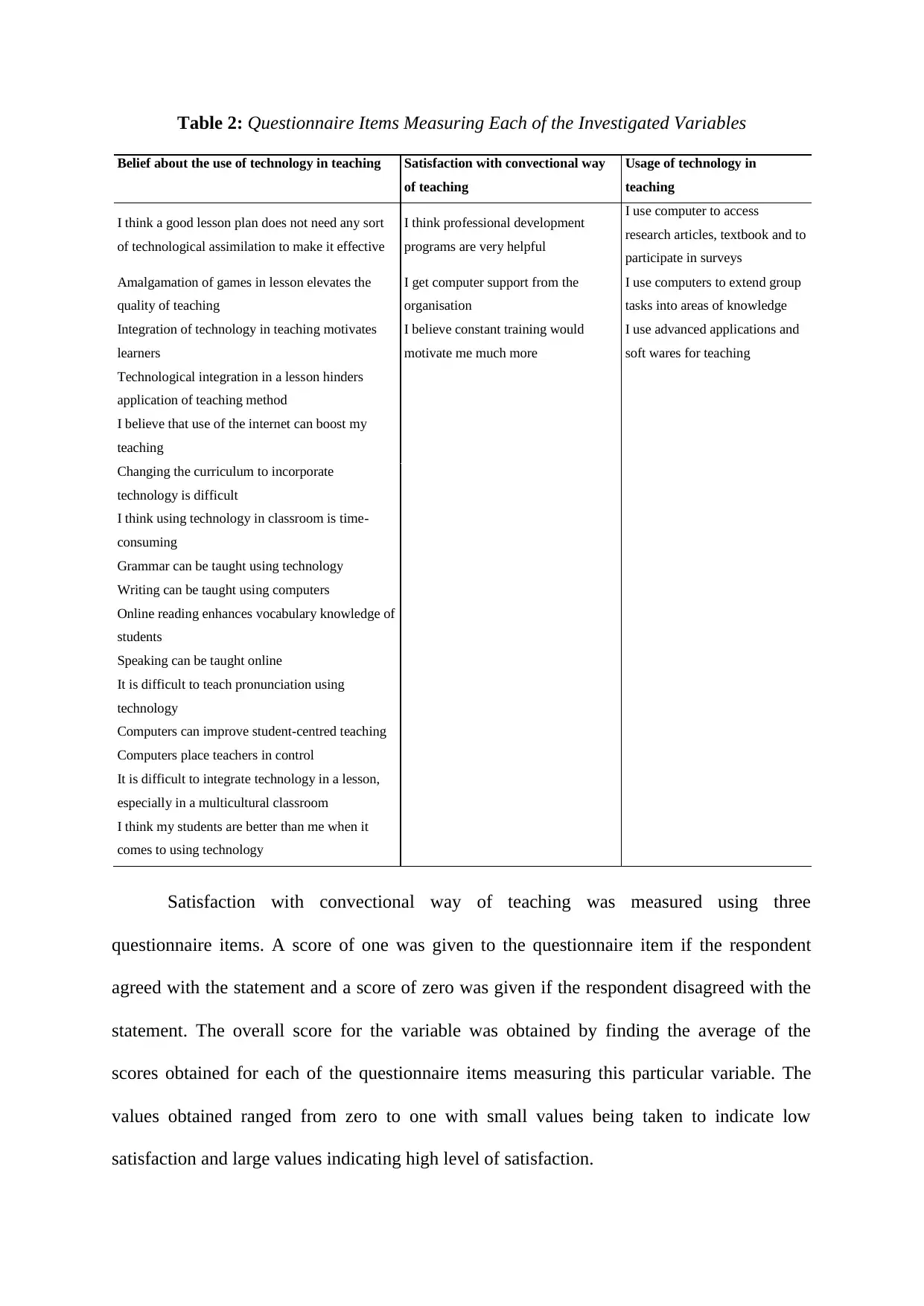
Table 2: Questionnaire Items Measuring Each of the Investigated Variables
Belief about the use of technology in teaching Satisfaction with convectional way
of teaching
Usage of technology in
teaching
I think a good lesson plan does not need any sort
of technological assimilation to make it effective
I think professional development
programs are very helpful
I use computer to access
research articles, textbook and to
participate in surveys
Amalgamation of games in lesson elevates the
quality of teaching
I get computer support from the
organisation
I use computers to extend group
tasks into areas of knowledge
Integration of technology in teaching motivates
learners
I believe constant training would
motivate me much more
I use advanced applications and
soft wares for teaching
Technological integration in a lesson hinders
application of teaching method
I believe that use of the internet can boost my
teaching
Changing the curriculum to incorporate
technology is difficult
I think using technology in classroom is time-
consuming
Grammar can be taught using technology
Writing can be taught using computers
Online reading enhances vocabulary knowledge of
students
Speaking can be taught online
It is difficult to teach pronunciation using
technology
Computers can improve student-centred teaching
Computers place teachers in control
It is difficult to integrate technology in a lesson,
especially in a multicultural classroom
I think my students are better than me when it
comes to using technology
Satisfaction with convectional way of teaching was measured using three
questionnaire items. A score of one was given to the questionnaire item if the respondent
agreed with the statement and a score of zero was given if the respondent disagreed with the
statement. The overall score for the variable was obtained by finding the average of the
scores obtained for each of the questionnaire items measuring this particular variable. The
values obtained ranged from zero to one with small values being taken to indicate low
satisfaction and large values indicating high level of satisfaction.
Belief about the use of technology in teaching Satisfaction with convectional way
of teaching
Usage of technology in
teaching
I think a good lesson plan does not need any sort
of technological assimilation to make it effective
I think professional development
programs are very helpful
I use computer to access
research articles, textbook and to
participate in surveys
Amalgamation of games in lesson elevates the
quality of teaching
I get computer support from the
organisation
I use computers to extend group
tasks into areas of knowledge
Integration of technology in teaching motivates
learners
I believe constant training would
motivate me much more
I use advanced applications and
soft wares for teaching
Technological integration in a lesson hinders
application of teaching method
I believe that use of the internet can boost my
teaching
Changing the curriculum to incorporate
technology is difficult
I think using technology in classroom is time-
consuming
Grammar can be taught using technology
Writing can be taught using computers
Online reading enhances vocabulary knowledge of
students
Speaking can be taught online
It is difficult to teach pronunciation using
technology
Computers can improve student-centred teaching
Computers place teachers in control
It is difficult to integrate technology in a lesson,
especially in a multicultural classroom
I think my students are better than me when it
comes to using technology
Satisfaction with convectional way of teaching was measured using three
questionnaire items. A score of one was given to the questionnaire item if the respondent
agreed with the statement and a score of zero was given if the respondent disagreed with the
statement. The overall score for the variable was obtained by finding the average of the
scores obtained for each of the questionnaire items measuring this particular variable. The
values obtained ranged from zero to one with small values being taken to indicate low
satisfaction and large values indicating high level of satisfaction.
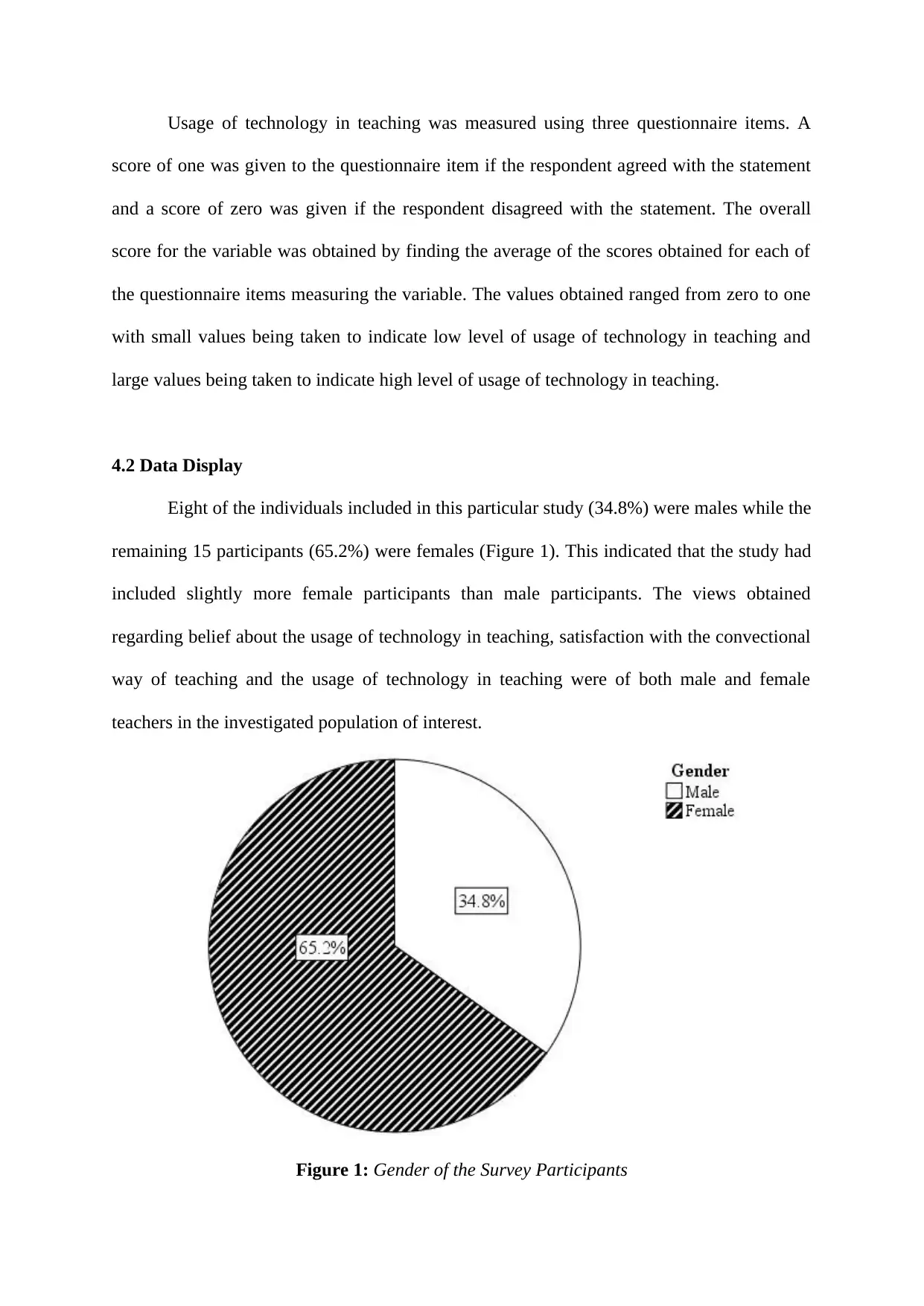
Usage of technology in teaching was measured using three questionnaire items. A
score of one was given to the questionnaire item if the respondent agreed with the statement
and a score of zero was given if the respondent disagreed with the statement. The overall
score for the variable was obtained by finding the average of the scores obtained for each of
the questionnaire items measuring the variable. The values obtained ranged from zero to one
with small values being taken to indicate low level of usage of technology in teaching and
large values being taken to indicate high level of usage of technology in teaching.
4.2 Data Display
Eight of the individuals included in this particular study (34.8%) were males while the
remaining 15 participants (65.2%) were females (Figure 1). This indicated that the study had
included slightly more female participants than male participants. The views obtained
regarding belief about the usage of technology in teaching, satisfaction with the convectional
way of teaching and the usage of technology in teaching were of both male and female
teachers in the investigated population of interest.
Figure 1: Gender of the Survey Participants
score of one was given to the questionnaire item if the respondent agreed with the statement
and a score of zero was given if the respondent disagreed with the statement. The overall
score for the variable was obtained by finding the average of the scores obtained for each of
the questionnaire items measuring the variable. The values obtained ranged from zero to one
with small values being taken to indicate low level of usage of technology in teaching and
large values being taken to indicate high level of usage of technology in teaching.
4.2 Data Display
Eight of the individuals included in this particular study (34.8%) were males while the
remaining 15 participants (65.2%) were females (Figure 1). This indicated that the study had
included slightly more female participants than male participants. The views obtained
regarding belief about the usage of technology in teaching, satisfaction with the convectional
way of teaching and the usage of technology in teaching were of both male and female
teachers in the investigated population of interest.
Figure 1: Gender of the Survey Participants
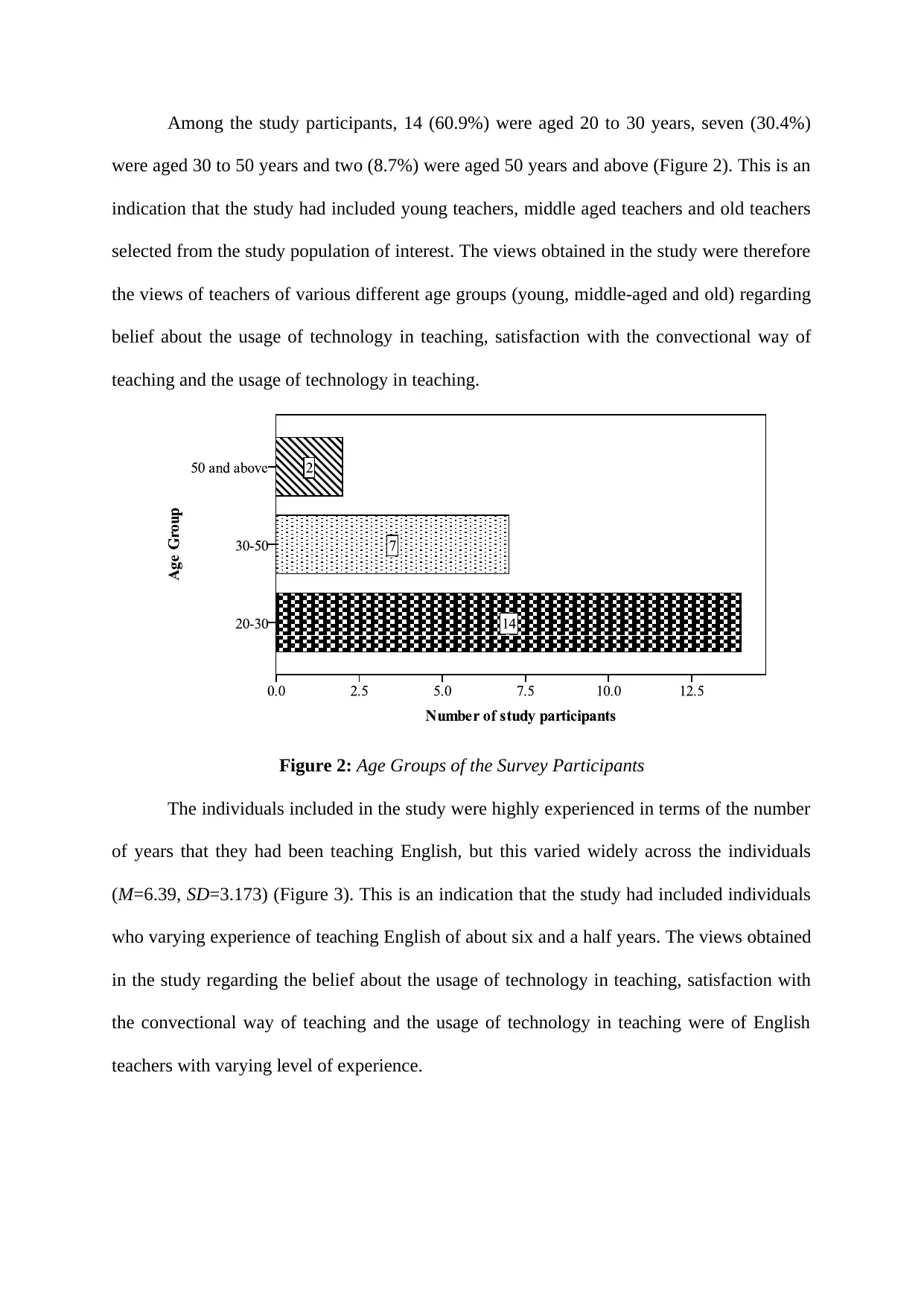
Among the study participants, 14 (60.9%) were aged 20 to 30 years, seven (30.4%)
were aged 30 to 50 years and two (8.7%) were aged 50 years and above (Figure 2). This is an
indication that the study had included young teachers, middle aged teachers and old teachers
selected from the study population of interest. The views obtained in the study were therefore
the views of teachers of various different age groups (young, middle-aged and old) regarding
belief about the usage of technology in teaching, satisfaction with the convectional way of
teaching and the usage of technology in teaching.
Figure 2: Age Groups of the Survey Participants
The individuals included in the study were highly experienced in terms of the number
of years that they had been teaching English, but this varied widely across the individuals
(M=6.39, SD=3.173) (Figure 3). This is an indication that the study had included individuals
who varying experience of teaching English of about six and a half years. The views obtained
in the study regarding the belief about the usage of technology in teaching, satisfaction with
the convectional way of teaching and the usage of technology in teaching were of English
teachers with varying level of experience.
were aged 30 to 50 years and two (8.7%) were aged 50 years and above (Figure 2). This is an
indication that the study had included young teachers, middle aged teachers and old teachers
selected from the study population of interest. The views obtained in the study were therefore
the views of teachers of various different age groups (young, middle-aged and old) regarding
belief about the usage of technology in teaching, satisfaction with the convectional way of
teaching and the usage of technology in teaching.
Figure 2: Age Groups of the Survey Participants
The individuals included in the study were highly experienced in terms of the number
of years that they had been teaching English, but this varied widely across the individuals
(M=6.39, SD=3.173) (Figure 3). This is an indication that the study had included individuals
who varying experience of teaching English of about six and a half years. The views obtained
in the study regarding the belief about the usage of technology in teaching, satisfaction with
the convectional way of teaching and the usage of technology in teaching were of English
teachers with varying level of experience.
Secure Best Marks with AI Grader
Need help grading? Try our AI Grader for instant feedback on your assignments.
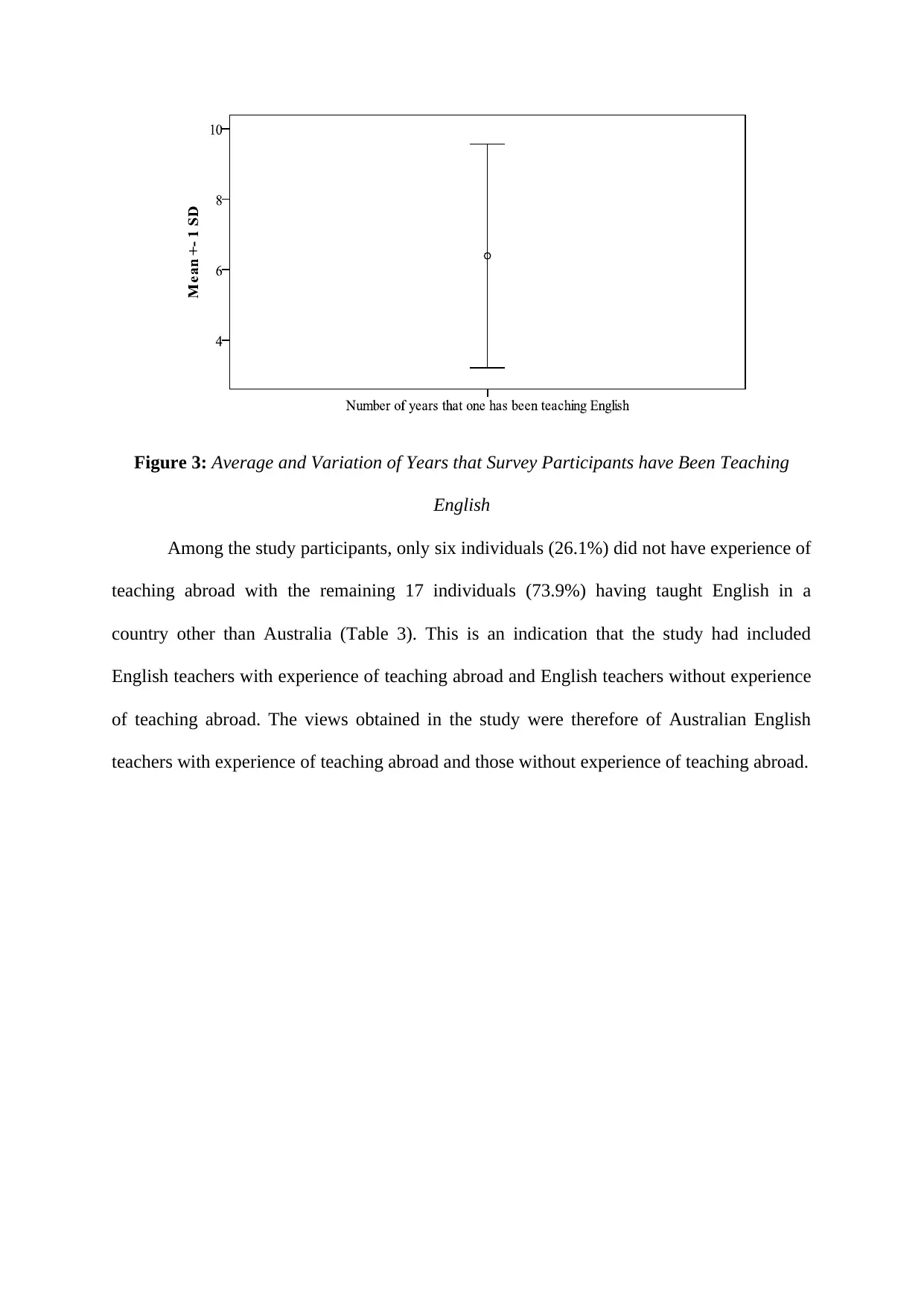
Figure 3: Average and Variation of Years that Survey Participants have Been Teaching
English
Among the study participants, only six individuals (26.1%) did not have experience of
teaching abroad with the remaining 17 individuals (73.9%) having taught English in a
country other than Australia (Table 3). This is an indication that the study had included
English teachers with experience of teaching abroad and English teachers without experience
of teaching abroad. The views obtained in the study were therefore of Australian English
teachers with experience of teaching abroad and those without experience of teaching abroad.
English
Among the study participants, only six individuals (26.1%) did not have experience of
teaching abroad with the remaining 17 individuals (73.9%) having taught English in a
country other than Australia (Table 3). This is an indication that the study had included
English teachers with experience of teaching abroad and English teachers without experience
of teaching abroad. The views obtained in the study were therefore of Australian English
teachers with experience of teaching abroad and those without experience of teaching abroad.

Table 3: Experience of Teaching English in Countries Different from One's Country of
Origin
Frequency
(n)
Percentage
(%)
Cumulative
Percentage
Japan; China 1 4.3 4.3
Japan; Europe 1 4.3 8.7
Japan; Korea 1 4.3 13.0
Japan; Korea; Australia; Dominican Republic 1 4.3 17.4
Mongolia 1 4.3 21.7
Pakistan 1 4.3 26.1
Russia and Australia 1 4.3 30.4
China 2 8.7 39.1
Nepal 2 8.7 47.8
Korea 3 13.0 60.9
Philippines 3 13.0 73.9
No 6 26.1 100.0
Total 23 100.0
Among the study participants, 9 (39.1%) had been teaching only adults, four (17.4%)
had been teaching only children and another four (17.4%) had been teaching only teenagers
with the remaining six participants (26.1%) having taught children, teenagers and adults or
adults and children or teenagers (Table 4). This is an indication that the study had included
English teachers with experience of teaching children, teachers with experience of teaching
teenagers and teachers with experience of teaching adults. The views obtained in the study
regarding the belief on the use of technology in teaching, satisfaction with the convectional
way of teaching and the actual usage of technology in teaching are therefore of teachers who
have taught people in various different age groups.
Origin
Frequency
(n)
Percentage
(%)
Cumulative
Percentage
Japan; China 1 4.3 4.3
Japan; Europe 1 4.3 8.7
Japan; Korea 1 4.3 13.0
Japan; Korea; Australia; Dominican Republic 1 4.3 17.4
Mongolia 1 4.3 21.7
Pakistan 1 4.3 26.1
Russia and Australia 1 4.3 30.4
China 2 8.7 39.1
Nepal 2 8.7 47.8
Korea 3 13.0 60.9
Philippines 3 13.0 73.9
No 6 26.1 100.0
Total 23 100.0
Among the study participants, 9 (39.1%) had been teaching only adults, four (17.4%)
had been teaching only children and another four (17.4%) had been teaching only teenagers
with the remaining six participants (26.1%) having taught children, teenagers and adults or
adults and children or teenagers (Table 4). This is an indication that the study had included
English teachers with experience of teaching children, teachers with experience of teaching
teenagers and teachers with experience of teaching adults. The views obtained in the study
regarding the belief on the use of technology in teaching, satisfaction with the convectional
way of teaching and the actual usage of technology in teaching are therefore of teachers who
have taught people in various different age groups.

Table 4: Age Groups of Individuals that the Teachers has Been Teaching English
Frequency
(n)
Percentage
(%)
Cumulative
Percentage
children; adults 1 4.3% 4.3
teenagers; adults 1 4.3% 8.7
children; teenagers; adults 4 17.4% 26.1
children 4 17.4% 43.5
teenagers 4 17.4% 60.9
adults 9 39.1% 100.0
Total 23 100.0%
Slightly more than a half of the individuals included in the study (52.2%) use
technology almost on daily basis with the remaining 11 individuals (47.8%) use technology
only when needed (Figure 4). This is an indication that the study had included teachers who
use technology extensively in their day-to-day activities and teachers who rarely use
technology in their day-to-day activities. The current study had therefore captured the views
of these two groups of teachers regarding belief on the use of technology in teaching,
satisfaction with the convectional way of teaching and the actual usage of technology in
teaching.
Frequency
(n)
Percentage
(%)
Cumulative
Percentage
children; adults 1 4.3% 4.3
teenagers; adults 1 4.3% 8.7
children; teenagers; adults 4 17.4% 26.1
children 4 17.4% 43.5
teenagers 4 17.4% 60.9
adults 9 39.1% 100.0
Total 23 100.0%
Slightly more than a half of the individuals included in the study (52.2%) use
technology almost on daily basis with the remaining 11 individuals (47.8%) use technology
only when needed (Figure 4). This is an indication that the study had included teachers who
use technology extensively in their day-to-day activities and teachers who rarely use
technology in their day-to-day activities. The current study had therefore captured the views
of these two groups of teachers regarding belief on the use of technology in teaching,
satisfaction with the convectional way of teaching and the actual usage of technology in
teaching.
Paraphrase This Document
Need a fresh take? Get an instant paraphrase of this document with our AI Paraphraser

Figure 4: How the Survey Participants Have Been Using Technology
On a daily basis, three of the individuals included in the study (13.0%) spent 1 to 3
hours using technology, five (21.7%) spent 2 to 4 hours using technology, seven (30.4%)
spent 4 to 7 hours using technology and eight (34.8%) spent more than 7 hours using
technology (Table 5). This is an indication that the study had included teachers who use
technology for different number of hours daily. However the individuals included in the study
used technology for at least one hour daily. The current study had therefore captured the
views of English teachers that use technology for at least one hour daily regarding belief on
the use of technology in teaching, satisfaction with the convectional way of teaching and the
actual usage of technology in teaching.
On a daily basis, three of the individuals included in the study (13.0%) spent 1 to 3
hours using technology, five (21.7%) spent 2 to 4 hours using technology, seven (30.4%)
spent 4 to 7 hours using technology and eight (34.8%) spent more than 7 hours using
technology (Table 5). This is an indication that the study had included teachers who use
technology for different number of hours daily. However the individuals included in the study
used technology for at least one hour daily. The current study had therefore captured the
views of English teachers that use technology for at least one hour daily regarding belief on
the use of technology in teaching, satisfaction with the convectional way of teaching and the
actual usage of technology in teaching.
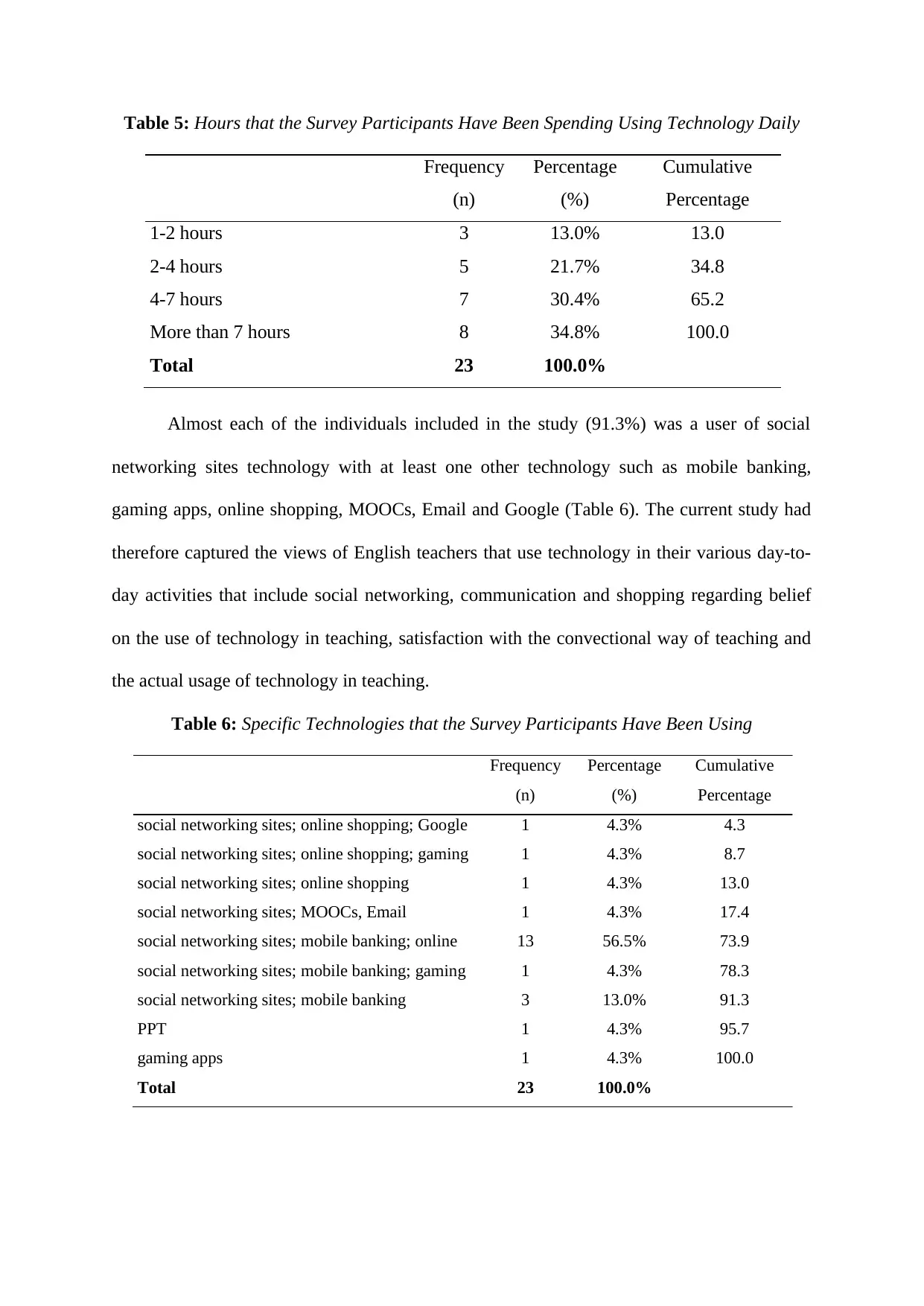
Table 5: Hours that the Survey Participants Have Been Spending Using Technology Daily
Frequency
(n)
Percentage
(%)
Cumulative
Percentage
1-2 hours 3 13.0% 13.0
2-4 hours 5 21.7% 34.8
4-7 hours 7 30.4% 65.2
More than 7 hours 8 34.8% 100.0
Total 23 100.0%
Almost each of the individuals included in the study (91.3%) was a user of social
networking sites technology with at least one other technology such as mobile banking,
gaming apps, online shopping, MOOCs, Email and Google (Table 6). The current study had
therefore captured the views of English teachers that use technology in their various day-to-
day activities that include social networking, communication and shopping regarding belief
on the use of technology in teaching, satisfaction with the convectional way of teaching and
the actual usage of technology in teaching.
Table 6: Specific Technologies that the Survey Participants Have Been Using
Frequency
(n)
Percentage
(%)
Cumulative
Percentage
social networking sites; online shopping; Google 1 4.3% 4.3
social networking sites; online shopping; gaming 1 4.3% 8.7
social networking sites; online shopping 1 4.3% 13.0
social networking sites; MOOCs, Email 1 4.3% 17.4
social networking sites; mobile banking; online 13 56.5% 73.9
social networking sites; mobile banking; gaming 1 4.3% 78.3
social networking sites; mobile banking 3 13.0% 91.3
PPT 1 4.3% 95.7
gaming apps 1 4.3% 100.0
Total 23 100.0%
Frequency
(n)
Percentage
(%)
Cumulative
Percentage
1-2 hours 3 13.0% 13.0
2-4 hours 5 21.7% 34.8
4-7 hours 7 30.4% 65.2
More than 7 hours 8 34.8% 100.0
Total 23 100.0%
Almost each of the individuals included in the study (91.3%) was a user of social
networking sites technology with at least one other technology such as mobile banking,
gaming apps, online shopping, MOOCs, Email and Google (Table 6). The current study had
therefore captured the views of English teachers that use technology in their various day-to-
day activities that include social networking, communication and shopping regarding belief
on the use of technology in teaching, satisfaction with the convectional way of teaching and
the actual usage of technology in teaching.
Table 6: Specific Technologies that the Survey Participants Have Been Using
Frequency
(n)
Percentage
(%)
Cumulative
Percentage
social networking sites; online shopping; Google 1 4.3% 4.3
social networking sites; online shopping; gaming 1 4.3% 8.7
social networking sites; online shopping 1 4.3% 13.0
social networking sites; MOOCs, Email 1 4.3% 17.4
social networking sites; mobile banking; online 13 56.5% 73.9
social networking sites; mobile banking; gaming 1 4.3% 78.3
social networking sites; mobile banking 3 13.0% 91.3
PPT 1 4.3% 95.7
gaming apps 1 4.3% 100.0
Total 23 100.0%

Among the English teachers included in the study, 12 (52.2%) were standard users of
technology, eight (34.8%) were average users of technology and three (13.0%) were expert
users of technology (Figure 8). This is an indication that the study had included standard,
average and expert users of technology among English teachers in the investigated population
of interest. The views obtained in the study regarding belief on the use of technology in
teaching, satisfaction with the convectional way of teaching and the actual usage of
technology in teaching were of English teacher with various different levels of usage of
technology.
Figure 5: Level of Technology User of the Survey Participants
The scores obtained for belief on the use of technology in teaching, satisfaction with
the convectional way of teaching and the actual usage of technology in teaching varied
widely across the study participants with the average obtained being greater than 0.5 for
belief on the use of technology in teaching (M=.77, SD=.114), satisfaction with the
convectional way of teaching (M=.85, SD=.224) and the actual usage of technology in
teaching (M=.90, SD=.212) (Figure 6). This is an indication that the study participants had a
highly positive belief about the use of technology in teaching, high satisfaction with their
current convectional way of teaching and a high actual usage of technology in teaching.
technology, eight (34.8%) were average users of technology and three (13.0%) were expert
users of technology (Figure 8). This is an indication that the study had included standard,
average and expert users of technology among English teachers in the investigated population
of interest. The views obtained in the study regarding belief on the use of technology in
teaching, satisfaction with the convectional way of teaching and the actual usage of
technology in teaching were of English teacher with various different levels of usage of
technology.
Figure 5: Level of Technology User of the Survey Participants
The scores obtained for belief on the use of technology in teaching, satisfaction with
the convectional way of teaching and the actual usage of technology in teaching varied
widely across the study participants with the average obtained being greater than 0.5 for
belief on the use of technology in teaching (M=.77, SD=.114), satisfaction with the
convectional way of teaching (M=.85, SD=.224) and the actual usage of technology in
teaching (M=.90, SD=.212) (Figure 6). This is an indication that the study participants had a
highly positive belief about the use of technology in teaching, high satisfaction with their
current convectional way of teaching and a high actual usage of technology in teaching.
Secure Best Marks with AI Grader
Need help grading? Try our AI Grader for instant feedback on your assignments.
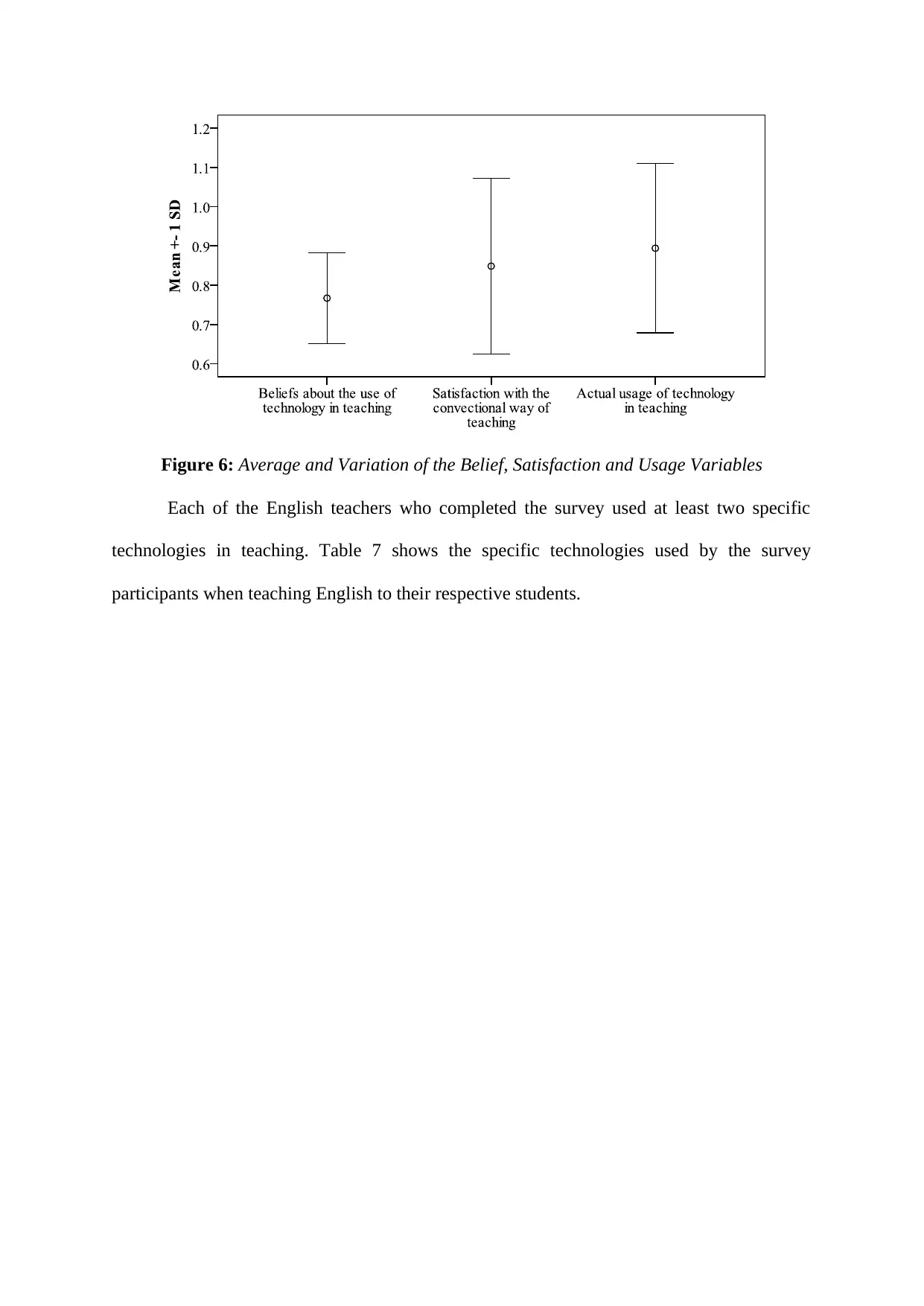
Figure 6: Average and Variation of the Belief, Satisfaction and Usage Variables
Each of the English teachers who completed the survey used at least two specific
technologies in teaching. Table 7 shows the specific technologies used by the survey
participants when teaching English to their respective students.
Each of the English teachers who completed the survey used at least two specific
technologies in teaching. Table 7 shows the specific technologies used by the survey
participants when teaching English to their respective students.
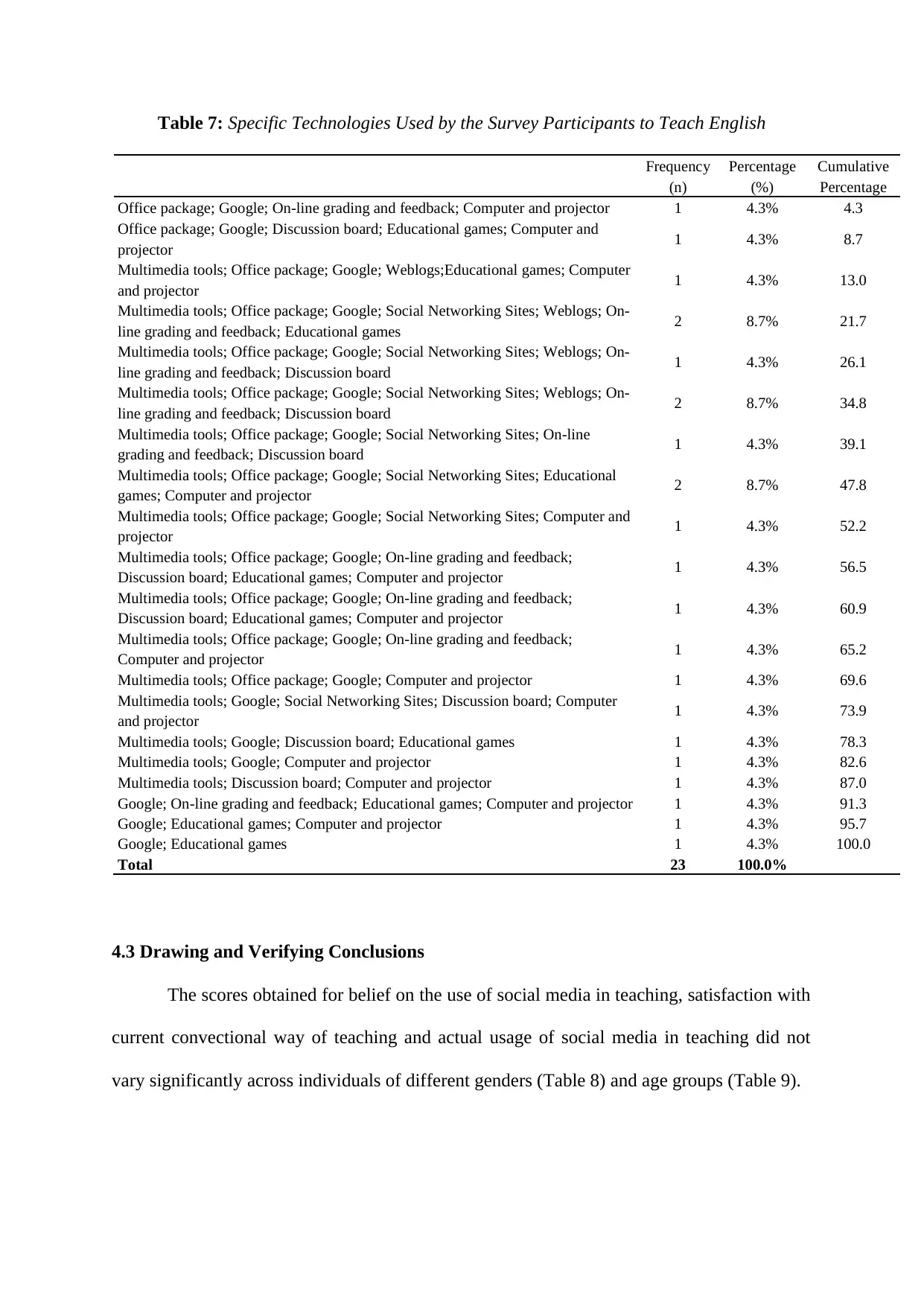
Table 7: Specific Technologies Used by the Survey Participants to Teach English
Frequency
(n)
Percentage
(%)
Cumulative
Percentage
Office package; Google; On-line grading and feedback; Computer and projector 1 4.3% 4.3
Office package; Google; Discussion board; Educational games; Computer and
projector 1 4.3% 8.7
Multimedia tools; Office package; Google; Weblogs;Educational games; Computer
and projector 1 4.3% 13.0
Multimedia tools; Office package; Google; Social Networking Sites; Weblogs; On-
line grading and feedback; Educational games 2 8.7% 21.7
Multimedia tools; Office package; Google; Social Networking Sites; Weblogs; On-
line grading and feedback; Discussion board 1 4.3% 26.1
Multimedia tools; Office package; Google; Social Networking Sites; Weblogs; On-
line grading and feedback; Discussion board 2 8.7% 34.8
Multimedia tools; Office package; Google; Social Networking Sites; On-line
grading and feedback; Discussion board 1 4.3% 39.1
Multimedia tools; Office package; Google; Social Networking Sites; Educational
games; Computer and projector 2 8.7% 47.8
Multimedia tools; Office package; Google; Social Networking Sites; Computer and
projector 1 4.3% 52.2
Multimedia tools; Office package; Google; On-line grading and feedback;
Discussion board; Educational games; Computer and projector 1 4.3% 56.5
Multimedia tools; Office package; Google; On-line grading and feedback;
Discussion board; Educational games; Computer and projector 1 4.3% 60.9
Multimedia tools; Office package; Google; On-line grading and feedback;
Computer and projector 1 4.3% 65.2
Multimedia tools; Office package; Google; Computer and projector 1 4.3% 69.6
Multimedia tools; Google; Social Networking Sites; Discussion board; Computer
and projector 1 4.3% 73.9
Multimedia tools; Google; Discussion board; Educational games 1 4.3% 78.3
Multimedia tools; Google; Computer and projector 1 4.3% 82.6
Multimedia tools; Discussion board; Computer and projector 1 4.3% 87.0
Google; On-line grading and feedback; Educational games; Computer and projector 1 4.3% 91.3
Google; Educational games; Computer and projector 1 4.3% 95.7
Google; Educational games 1 4.3% 100.0
Total 23 100.0%
4.3 Drawing and Verifying Conclusions
The scores obtained for belief on the use of social media in teaching, satisfaction with
current convectional way of teaching and actual usage of social media in teaching did not
vary significantly across individuals of different genders (Table 8) and age groups (Table 9).
Frequency
(n)
Percentage
(%)
Cumulative
Percentage
Office package; Google; On-line grading and feedback; Computer and projector 1 4.3% 4.3
Office package; Google; Discussion board; Educational games; Computer and
projector 1 4.3% 8.7
Multimedia tools; Office package; Google; Weblogs;Educational games; Computer
and projector 1 4.3% 13.0
Multimedia tools; Office package; Google; Social Networking Sites; Weblogs; On-
line grading and feedback; Educational games 2 8.7% 21.7
Multimedia tools; Office package; Google; Social Networking Sites; Weblogs; On-
line grading and feedback; Discussion board 1 4.3% 26.1
Multimedia tools; Office package; Google; Social Networking Sites; Weblogs; On-
line grading and feedback; Discussion board 2 8.7% 34.8
Multimedia tools; Office package; Google; Social Networking Sites; On-line
grading and feedback; Discussion board 1 4.3% 39.1
Multimedia tools; Office package; Google; Social Networking Sites; Educational
games; Computer and projector 2 8.7% 47.8
Multimedia tools; Office package; Google; Social Networking Sites; Computer and
projector 1 4.3% 52.2
Multimedia tools; Office package; Google; On-line grading and feedback;
Discussion board; Educational games; Computer and projector 1 4.3% 56.5
Multimedia tools; Office package; Google; On-line grading and feedback;
Discussion board; Educational games; Computer and projector 1 4.3% 60.9
Multimedia tools; Office package; Google; On-line grading and feedback;
Computer and projector 1 4.3% 65.2
Multimedia tools; Office package; Google; Computer and projector 1 4.3% 69.6
Multimedia tools; Google; Social Networking Sites; Discussion board; Computer
and projector 1 4.3% 73.9
Multimedia tools; Google; Discussion board; Educational games 1 4.3% 78.3
Multimedia tools; Google; Computer and projector 1 4.3% 82.6
Multimedia tools; Discussion board; Computer and projector 1 4.3% 87.0
Google; On-line grading and feedback; Educational games; Computer and projector 1 4.3% 91.3
Google; Educational games; Computer and projector 1 4.3% 95.7
Google; Educational games 1 4.3% 100.0
Total 23 100.0%
4.3 Drawing and Verifying Conclusions
The scores obtained for belief on the use of social media in teaching, satisfaction with
current convectional way of teaching and actual usage of social media in teaching did not
vary significantly across individuals of different genders (Table 8) and age groups (Table 9).
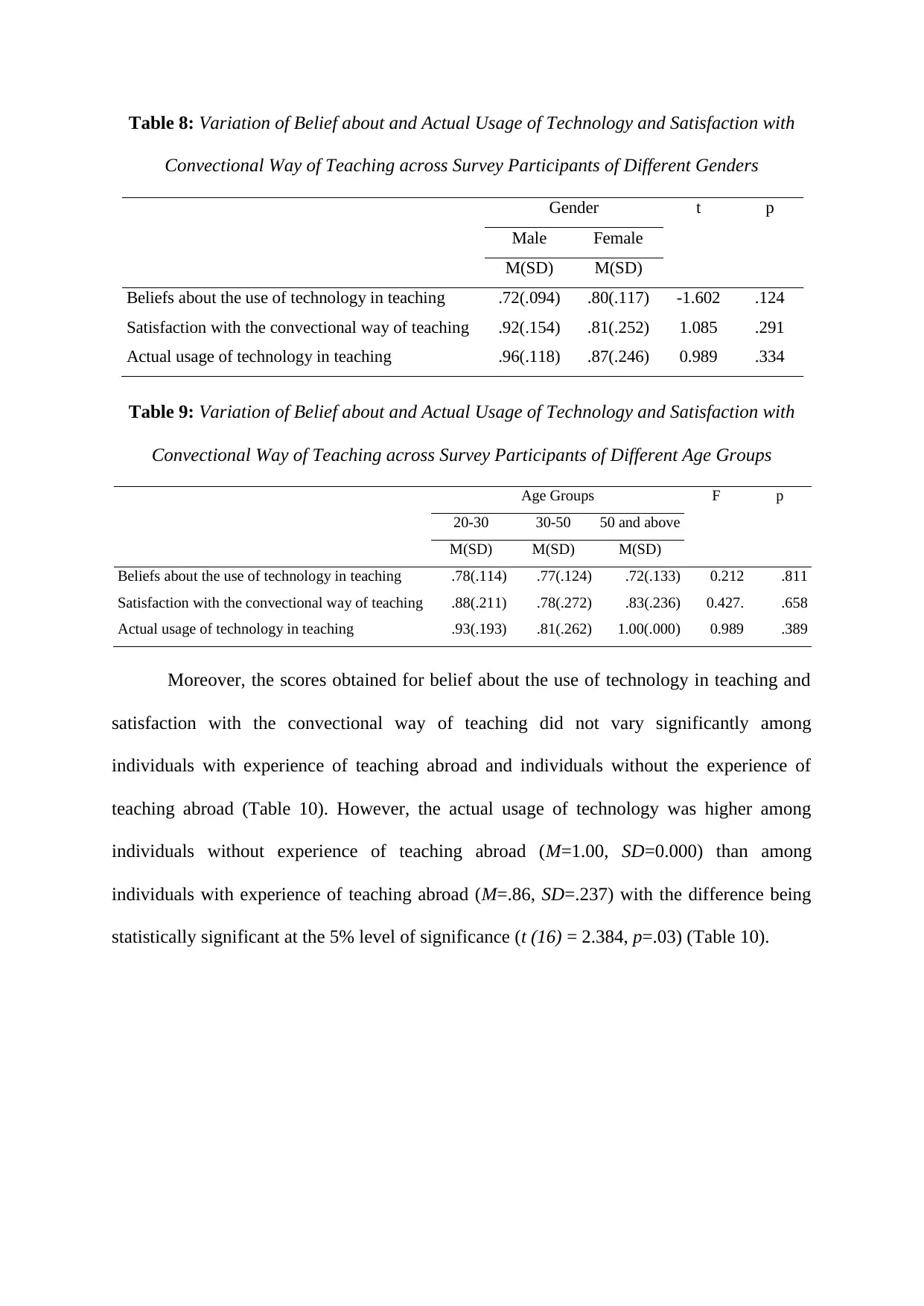
Table 8: Variation of Belief about and Actual Usage of Technology and Satisfaction with
Convectional Way of Teaching across Survey Participants of Different Genders
Gender t p
Male Female
M(SD) M(SD)
Beliefs about the use of technology in teaching .72(.094) .80(.117) -1.602 .124
Satisfaction with the convectional way of teaching .92(.154) .81(.252) 1.085 .291
Actual usage of technology in teaching .96(.118) .87(.246) 0.989 .334
Table 9: Variation of Belief about and Actual Usage of Technology and Satisfaction with
Convectional Way of Teaching across Survey Participants of Different Age Groups
Age Groups F p
20-30 30-50 50 and above
M(SD) M(SD) M(SD)
Beliefs about the use of technology in teaching .78(.114) .77(.124) .72(.133) 0.212 .811
Satisfaction with the convectional way of teaching .88(.211) .78(.272) .83(.236) 0.427. .658
Actual usage of technology in teaching .93(.193) .81(.262) 1.00(.000) 0.989 .389
Moreover, the scores obtained for belief about the use of technology in teaching and
satisfaction with the convectional way of teaching did not vary significantly among
individuals with experience of teaching abroad and individuals without the experience of
teaching abroad (Table 10). However, the actual usage of technology was higher among
individuals without experience of teaching abroad (M=1.00, SD=0.000) than among
individuals with experience of teaching abroad (M=.86, SD=.237) with the difference being
statistically significant at the 5% level of significance (t (16) = 2.384, p=.03) (Table 10).
Convectional Way of Teaching across Survey Participants of Different Genders
Gender t p
Male Female
M(SD) M(SD)
Beliefs about the use of technology in teaching .72(.094) .80(.117) -1.602 .124
Satisfaction with the convectional way of teaching .92(.154) .81(.252) 1.085 .291
Actual usage of technology in teaching .96(.118) .87(.246) 0.989 .334
Table 9: Variation of Belief about and Actual Usage of Technology and Satisfaction with
Convectional Way of Teaching across Survey Participants of Different Age Groups
Age Groups F p
20-30 30-50 50 and above
M(SD) M(SD) M(SD)
Beliefs about the use of technology in teaching .78(.114) .77(.124) .72(.133) 0.212 .811
Satisfaction with the convectional way of teaching .88(.211) .78(.272) .83(.236) 0.427. .658
Actual usage of technology in teaching .93(.193) .81(.262) 1.00(.000) 0.989 .389
Moreover, the scores obtained for belief about the use of technology in teaching and
satisfaction with the convectional way of teaching did not vary significantly among
individuals with experience of teaching abroad and individuals without the experience of
teaching abroad (Table 10). However, the actual usage of technology was higher among
individuals without experience of teaching abroad (M=1.00, SD=0.000) than among
individuals with experience of teaching abroad (M=.86, SD=.237) with the difference being
statistically significant at the 5% level of significance (t (16) = 2.384, p=.03) (Table 10).
Paraphrase This Document
Need a fresh take? Get an instant paraphrase of this document with our AI Paraphraser

Table 10: Belief about and Usage of Technology and Satisfaction with Convectional Way of
Teaching across Survey Participants with and without Experience of Teaching Abroad
Whether one has experience
of teaching abroad
t p
No Yes
M(SD) M(SD)
Beliefs about the use of technology in teaching .80(.092) .76(.121) 0.822 .420
Satisfaction with the convectional way of teaching .80(.298) .86(.206) -0.542 .594
Actual usage of technology in teaching 1.00(.000) .86(.237) 2.384 .030
The scores did not also differ significantly across individuals who cannot go for a day
without using technology and individuals who used technology only when needed (Table 11).
Table 11: Belief about and Usage of Technology and Satisfaction with Convectional Way of
Teaching across Survey Participants with Difference Experience with Technology
Experience with technology t p
I can't imagine a
day without it.
I use it only
when needed.
M(SD) M(SD)
Beliefs about the use of technology in teaching .78(.111) .76(.121) 0.303 .765
Satisfaction with the convectional way of teaching .76(.262) .94(.135) -2.046 .059
Actual usage of technology in teaching .89(.217) .91(.216) -0.224 .825
Moreover, the scores obtained for belief on the use of social media in teaching,
satisfaction with current convectional way of teaching and actual usage of social media in
teaching did not vary significantly among standard, average and expert users of technology
(Table 12).
Teaching across Survey Participants with and without Experience of Teaching Abroad
Whether one has experience
of teaching abroad
t p
No Yes
M(SD) M(SD)
Beliefs about the use of technology in teaching .80(.092) .76(.121) 0.822 .420
Satisfaction with the convectional way of teaching .80(.298) .86(.206) -0.542 .594
Actual usage of technology in teaching 1.00(.000) .86(.237) 2.384 .030
The scores did not also differ significantly across individuals who cannot go for a day
without using technology and individuals who used technology only when needed (Table 11).
Table 11: Belief about and Usage of Technology and Satisfaction with Convectional Way of
Teaching across Survey Participants with Difference Experience with Technology
Experience with technology t p
I can't imagine a
day without it.
I use it only
when needed.
M(SD) M(SD)
Beliefs about the use of technology in teaching .78(.111) .76(.121) 0.303 .765
Satisfaction with the convectional way of teaching .76(.262) .94(.135) -2.046 .059
Actual usage of technology in teaching .89(.217) .91(.216) -0.224 .825
Moreover, the scores obtained for belief on the use of social media in teaching,
satisfaction with current convectional way of teaching and actual usage of social media in
teaching did not vary significantly among standard, average and expert users of technology
(Table 12).
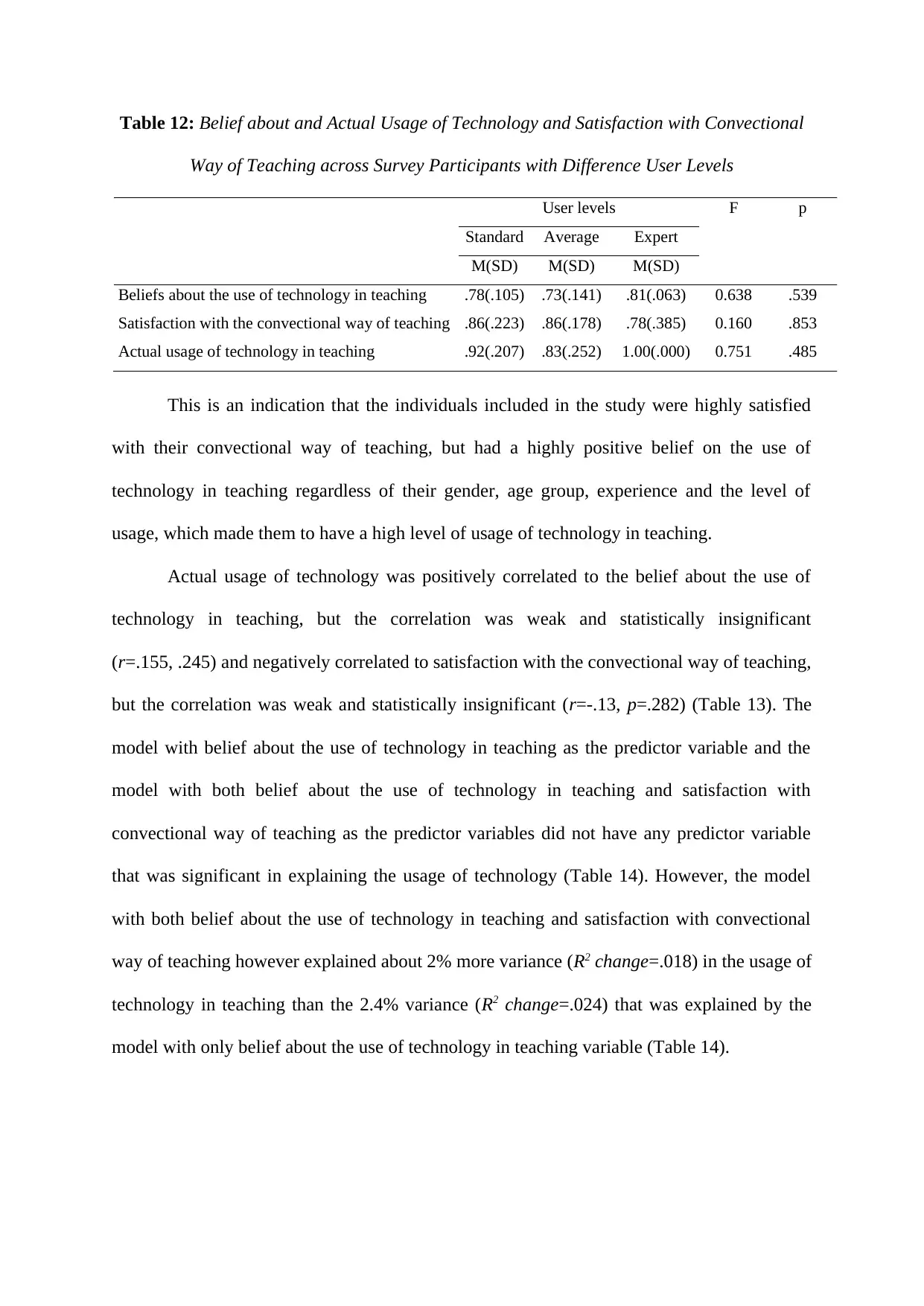
Table 12: Belief about and Actual Usage of Technology and Satisfaction with Convectional
Way of Teaching across Survey Participants with Difference User Levels
User levels F p
Standard Average Expert
M(SD) M(SD) M(SD)
Beliefs about the use of technology in teaching .78(.105) .73(.141) .81(.063) 0.638 .539
Satisfaction with the convectional way of teaching .86(.223) .86(.178) .78(.385) 0.160 .853
Actual usage of technology in teaching .92(.207) .83(.252) 1.00(.000) 0.751 .485
This is an indication that the individuals included in the study were highly satisfied
with their convectional way of teaching, but had a highly positive belief on the use of
technology in teaching regardless of their gender, age group, experience and the level of
usage, which made them to have a high level of usage of technology in teaching.
Actual usage of technology was positively correlated to the belief about the use of
technology in teaching, but the correlation was weak and statistically insignificant
(r=.155, .245) and negatively correlated to satisfaction with the convectional way of teaching,
but the correlation was weak and statistically insignificant (r=-.13, p=.282) (Table 13). The
model with belief about the use of technology in teaching as the predictor variable and the
model with both belief about the use of technology in teaching and satisfaction with
convectional way of teaching as the predictor variables did not have any predictor variable
that was significant in explaining the usage of technology (Table 14). However, the model
with both belief about the use of technology in teaching and satisfaction with convectional
way of teaching however explained about 2% more variance (R2 change=.018) in the usage of
technology in teaching than the 2.4% variance (R2 change=.024) that was explained by the
model with only belief about the use of technology in teaching variable (Table 14).
Way of Teaching across Survey Participants with Difference User Levels
User levels F p
Standard Average Expert
M(SD) M(SD) M(SD)
Beliefs about the use of technology in teaching .78(.105) .73(.141) .81(.063) 0.638 .539
Satisfaction with the convectional way of teaching .86(.223) .86(.178) .78(.385) 0.160 .853
Actual usage of technology in teaching .92(.207) .83(.252) 1.00(.000) 0.751 .485
This is an indication that the individuals included in the study were highly satisfied
with their convectional way of teaching, but had a highly positive belief on the use of
technology in teaching regardless of their gender, age group, experience and the level of
usage, which made them to have a high level of usage of technology in teaching.
Actual usage of technology was positively correlated to the belief about the use of
technology in teaching, but the correlation was weak and statistically insignificant
(r=.155, .245) and negatively correlated to satisfaction with the convectional way of teaching,
but the correlation was weak and statistically insignificant (r=-.13, p=.282) (Table 13). The
model with belief about the use of technology in teaching as the predictor variable and the
model with both belief about the use of technology in teaching and satisfaction with
convectional way of teaching as the predictor variables did not have any predictor variable
that was significant in explaining the usage of technology (Table 14). However, the model
with both belief about the use of technology in teaching and satisfaction with convectional
way of teaching however explained about 2% more variance (R2 change=.018) in the usage of
technology in teaching than the 2.4% variance (R2 change=.024) that was explained by the
model with only belief about the use of technology in teaching variable (Table 14).
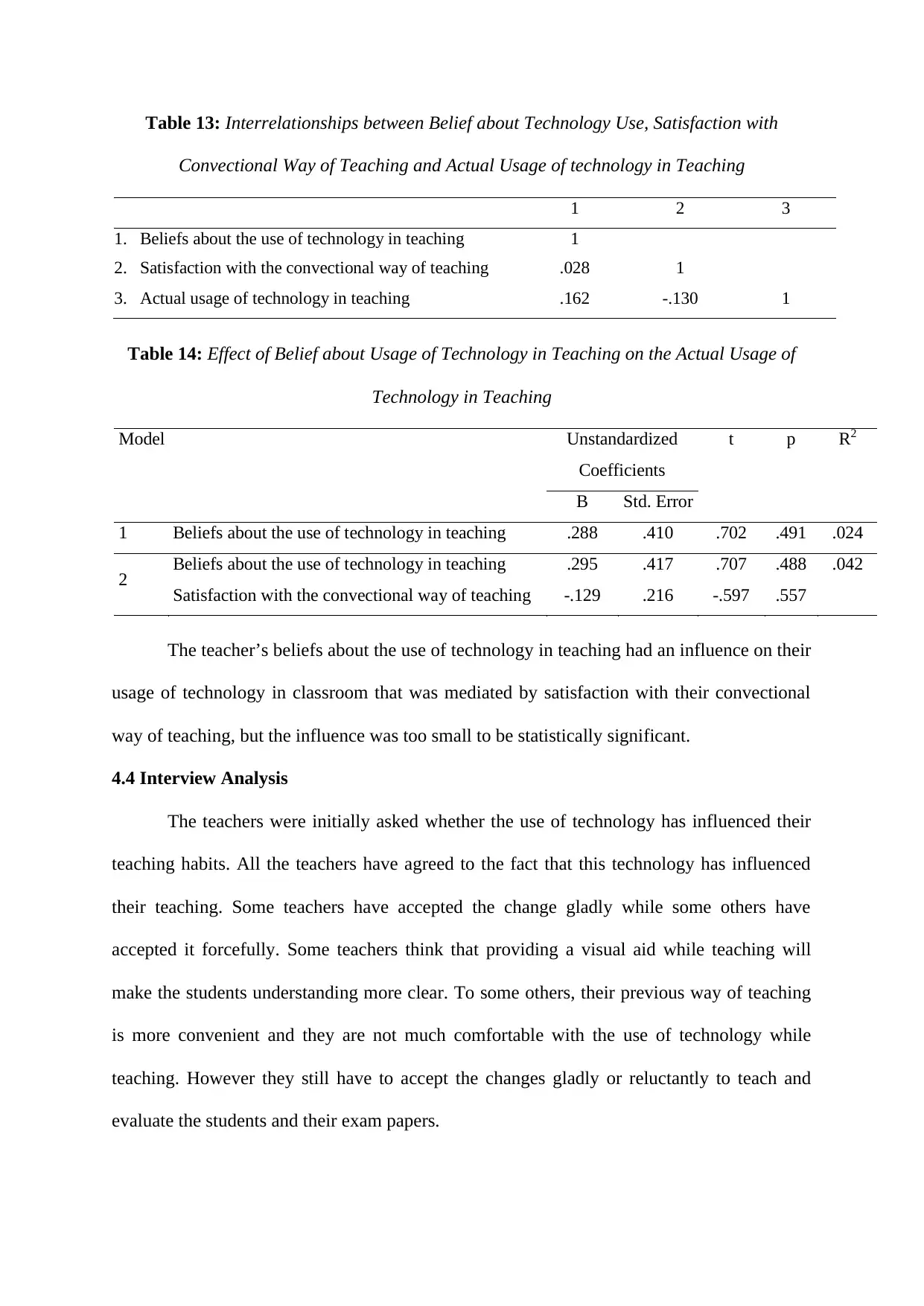
Table 13: Interrelationships between Belief about Technology Use, Satisfaction with
Convectional Way of Teaching and Actual Usage of technology in Teaching
1 2 3
1. Beliefs about the use of technology in teaching 1
2. Satisfaction with the convectional way of teaching .028 1
3. Actual usage of technology in teaching .162 -.130 1
Table 14: Effect of Belief about Usage of Technology in Teaching on the Actual Usage of
Technology in Teaching
Model Unstandardized
Coefficients
t p R 2
B Std. Error
1 Beliefs about the use of technology in teaching .288 .410 .702 .491 .024
2 Beliefs about the use of technology in teaching .295 .417 .707 .488 .042
Satisfaction with the convectional way of teaching -.129 .216 -.597 .557
The teacher’s beliefs about the use of technology in teaching had an influence on their
usage of technology in classroom that was mediated by satisfaction with their convectional
way of teaching, but the influence was too small to be statistically significant.
4.4 Interview Analysis
The teachers were initially asked whether the use of technology has influenced their
teaching habits. All the teachers have agreed to the fact that this technology has influenced
their teaching. Some teachers have accepted the change gladly while some others have
accepted it forcefully. Some teachers think that providing a visual aid while teaching will
make the students understanding more clear. To some others, their previous way of teaching
is more convenient and they are not much comfortable with the use of technology while
teaching. However they still have to accept the changes gladly or reluctantly to teach and
evaluate the students and their exam papers.
Convectional Way of Teaching and Actual Usage of technology in Teaching
1 2 3
1. Beliefs about the use of technology in teaching 1
2. Satisfaction with the convectional way of teaching .028 1
3. Actual usage of technology in teaching .162 -.130 1
Table 14: Effect of Belief about Usage of Technology in Teaching on the Actual Usage of
Technology in Teaching
Model Unstandardized
Coefficients
t p R 2
B Std. Error
1 Beliefs about the use of technology in teaching .288 .410 .702 .491 .024
2 Beliefs about the use of technology in teaching .295 .417 .707 .488 .042
Satisfaction with the convectional way of teaching -.129 .216 -.597 .557
The teacher’s beliefs about the use of technology in teaching had an influence on their
usage of technology in classroom that was mediated by satisfaction with their convectional
way of teaching, but the influence was too small to be statistically significant.
4.4 Interview Analysis
The teachers were initially asked whether the use of technology has influenced their
teaching habits. All the teachers have agreed to the fact that this technology has influenced
their teaching. Some teachers have accepted the change gladly while some others have
accepted it forcefully. Some teachers think that providing a visual aid while teaching will
make the students understanding more clear. To some others, their previous way of teaching
is more convenient and they are not much comfortable with the use of technology while
teaching. However they still have to accept the changes gladly or reluctantly to teach and
evaluate the students and their exam papers.
Secure Best Marks with AI Grader
Need help grading? Try our AI Grader for instant feedback on your assignments.
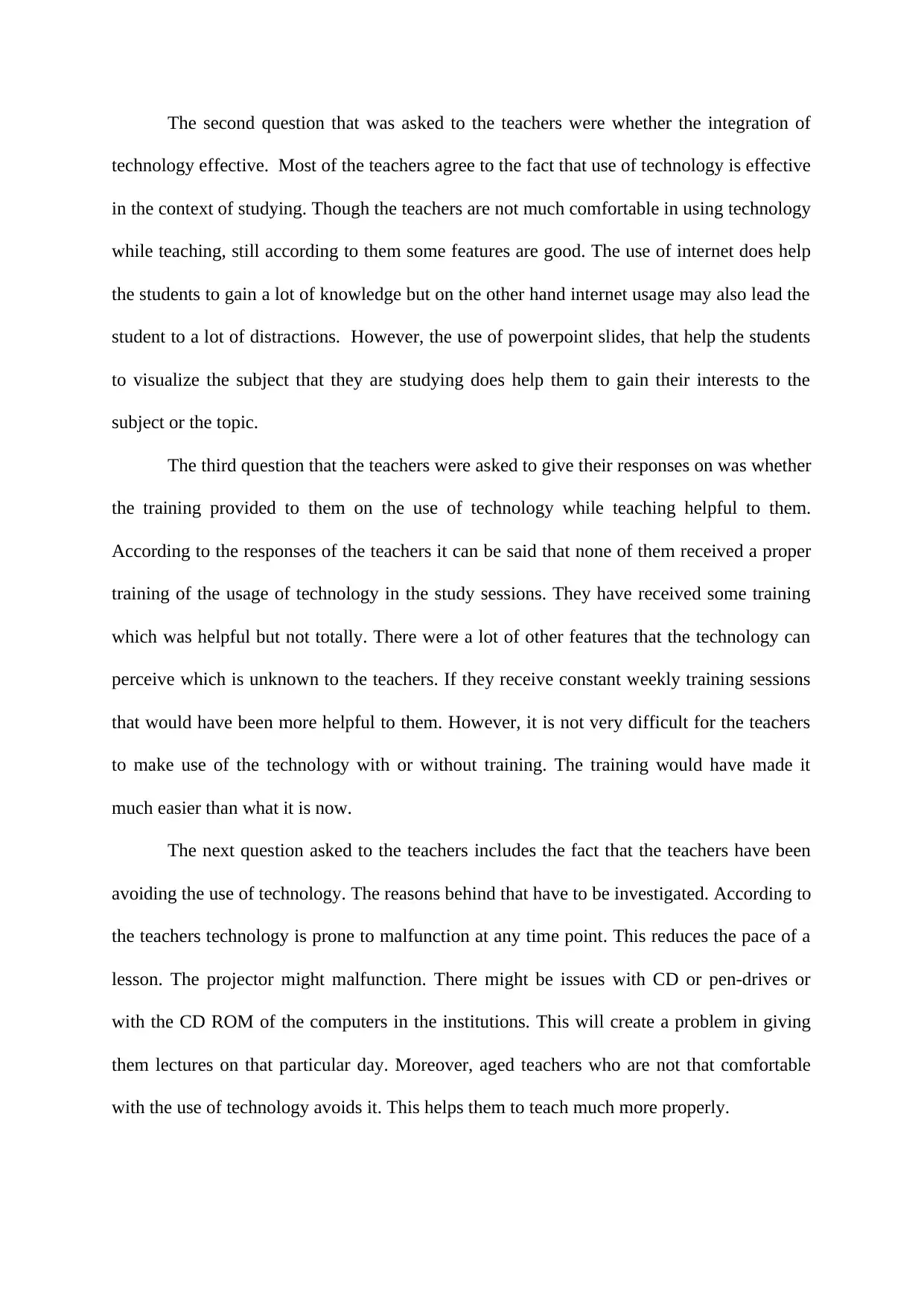
The second question that was asked to the teachers were whether the integration of
technology effective. Most of the teachers agree to the fact that use of technology is effective
in the context of studying. Though the teachers are not much comfortable in using technology
while teaching, still according to them some features are good. The use of internet does help
the students to gain a lot of knowledge but on the other hand internet usage may also lead the
student to a lot of distractions. However, the use of powerpoint slides, that help the students
to visualize the subject that they are studying does help them to gain their interests to the
subject or the topic.
The third question that the teachers were asked to give their responses on was whether
the training provided to them on the use of technology while teaching helpful to them.
According to the responses of the teachers it can be said that none of them received a proper
training of the usage of technology in the study sessions. They have received some training
which was helpful but not totally. There were a lot of other features that the technology can
perceive which is unknown to the teachers. If they receive constant weekly training sessions
that would have been more helpful to them. However, it is not very difficult for the teachers
to make use of the technology with or without training. The training would have made it
much easier than what it is now.
The next question asked to the teachers includes the fact that the teachers have been
avoiding the use of technology. The reasons behind that have to be investigated. According to
the teachers technology is prone to malfunction at any time point. This reduces the pace of a
lesson. The projector might malfunction. There might be issues with CD or pen-drives or
with the CD ROM of the computers in the institutions. This will create a problem in giving
them lectures on that particular day. Moreover, aged teachers who are not that comfortable
with the use of technology avoids it. This helps them to teach much more properly.
technology effective. Most of the teachers agree to the fact that use of technology is effective
in the context of studying. Though the teachers are not much comfortable in using technology
while teaching, still according to them some features are good. The use of internet does help
the students to gain a lot of knowledge but on the other hand internet usage may also lead the
student to a lot of distractions. However, the use of powerpoint slides, that help the students
to visualize the subject that they are studying does help them to gain their interests to the
subject or the topic.
The third question that the teachers were asked to give their responses on was whether
the training provided to them on the use of technology while teaching helpful to them.
According to the responses of the teachers it can be said that none of them received a proper
training of the usage of technology in the study sessions. They have received some training
which was helpful but not totally. There were a lot of other features that the technology can
perceive which is unknown to the teachers. If they receive constant weekly training sessions
that would have been more helpful to them. However, it is not very difficult for the teachers
to make use of the technology with or without training. The training would have made it
much easier than what it is now.
The next question asked to the teachers includes the fact that the teachers have been
avoiding the use of technology. The reasons behind that have to be investigated. According to
the teachers technology is prone to malfunction at any time point. This reduces the pace of a
lesson. The projector might malfunction. There might be issues with CD or pen-drives or
with the CD ROM of the computers in the institutions. This will create a problem in giving
them lectures on that particular day. Moreover, aged teachers who are not that comfortable
with the use of technology avoids it. This helps them to teach much more properly.
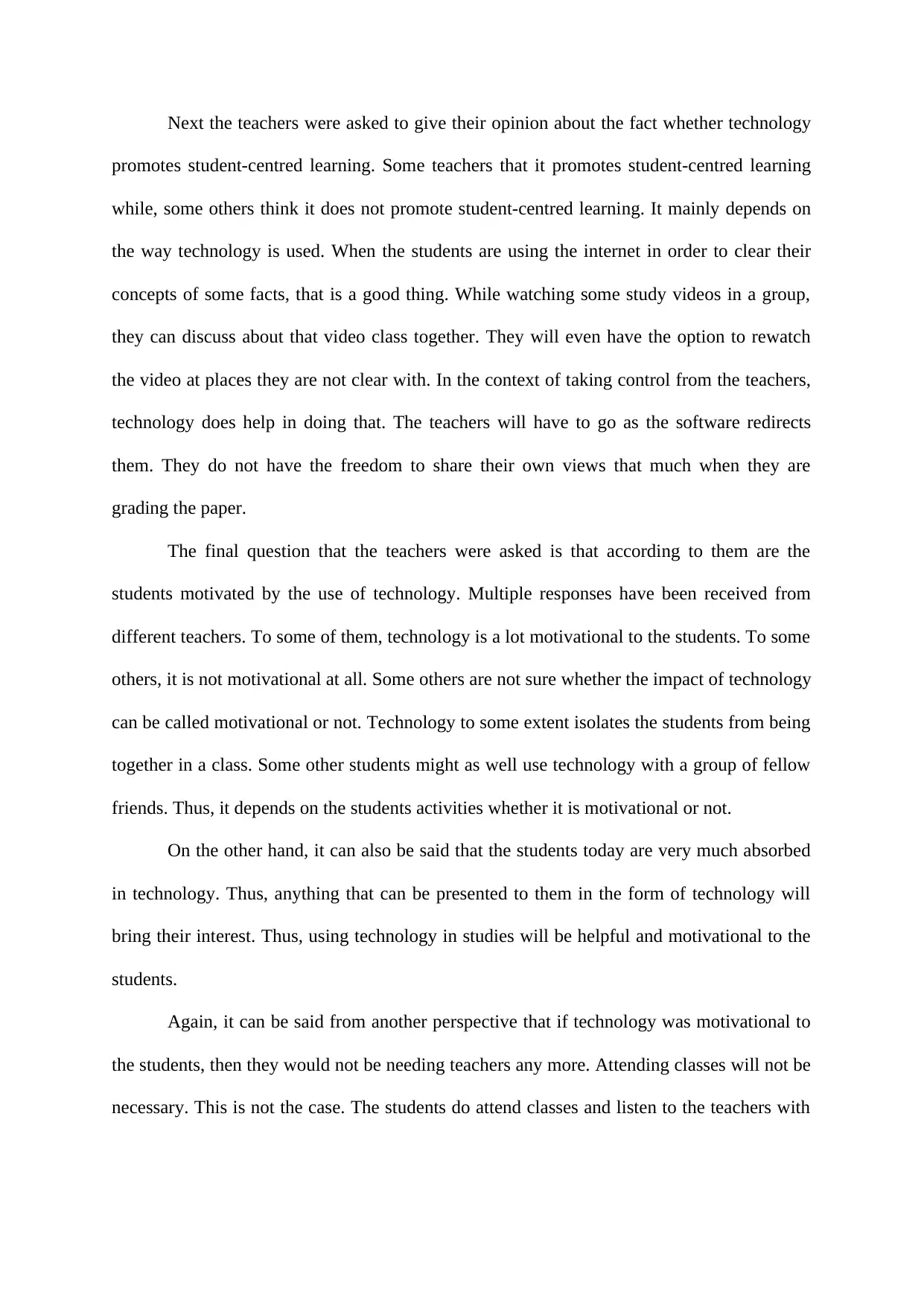
Next the teachers were asked to give their opinion about the fact whether technology
promotes student-centred learning. Some teachers that it promotes student-centred learning
while, some others think it does not promote student-centred learning. It mainly depends on
the way technology is used. When the students are using the internet in order to clear their
concepts of some facts, that is a good thing. While watching some study videos in a group,
they can discuss about that video class together. They will even have the option to rewatch
the video at places they are not clear with. In the context of taking control from the teachers,
technology does help in doing that. The teachers will have to go as the software redirects
them. They do not have the freedom to share their own views that much when they are
grading the paper.
The final question that the teachers were asked is that according to them are the
students motivated by the use of technology. Multiple responses have been received from
different teachers. To some of them, technology is a lot motivational to the students. To some
others, it is not motivational at all. Some others are not sure whether the impact of technology
can be called motivational or not. Technology to some extent isolates the students from being
together in a class. Some other students might as well use technology with a group of fellow
friends. Thus, it depends on the students activities whether it is motivational or not.
On the other hand, it can also be said that the students today are very much absorbed
in technology. Thus, anything that can be presented to them in the form of technology will
bring their interest. Thus, using technology in studies will be helpful and motivational to the
students.
Again, it can be said from another perspective that if technology was motivational to
the students, then they would not be needing teachers any more. Attending classes will not be
necessary. This is not the case. The students do attend classes and listen to the teachers with
promotes student-centred learning. Some teachers that it promotes student-centred learning
while, some others think it does not promote student-centred learning. It mainly depends on
the way technology is used. When the students are using the internet in order to clear their
concepts of some facts, that is a good thing. While watching some study videos in a group,
they can discuss about that video class together. They will even have the option to rewatch
the video at places they are not clear with. In the context of taking control from the teachers,
technology does help in doing that. The teachers will have to go as the software redirects
them. They do not have the freedom to share their own views that much when they are
grading the paper.
The final question that the teachers were asked is that according to them are the
students motivated by the use of technology. Multiple responses have been received from
different teachers. To some of them, technology is a lot motivational to the students. To some
others, it is not motivational at all. Some others are not sure whether the impact of technology
can be called motivational or not. Technology to some extent isolates the students from being
together in a class. Some other students might as well use technology with a group of fellow
friends. Thus, it depends on the students activities whether it is motivational or not.
On the other hand, it can also be said that the students today are very much absorbed
in technology. Thus, anything that can be presented to them in the form of technology will
bring their interest. Thus, using technology in studies will be helpful and motivational to the
students.
Again, it can be said from another perspective that if technology was motivational to
the students, then they would not be needing teachers any more. Attending classes will not be
necessary. This is not the case. The students do attend classes and listen to the teachers with
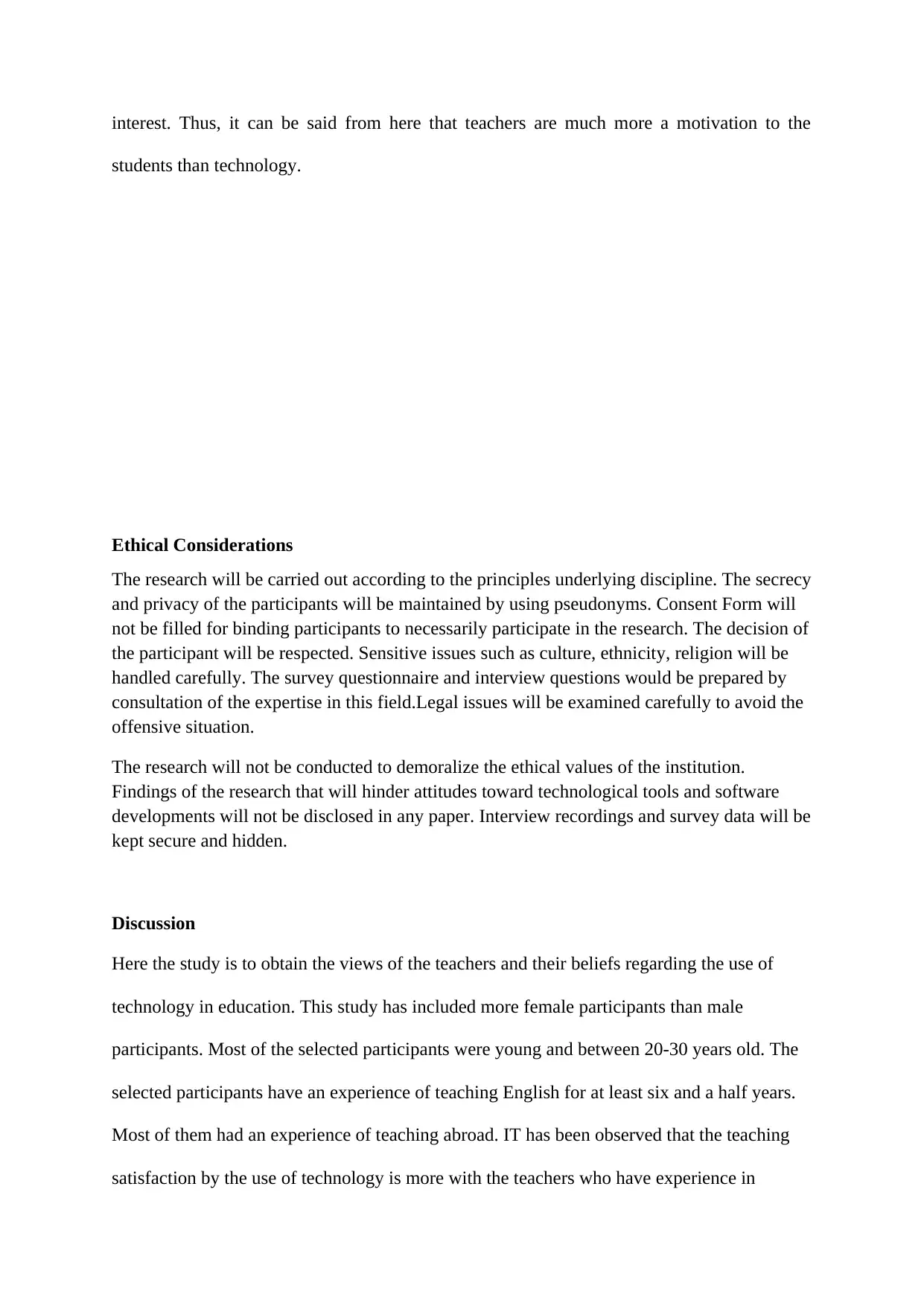
interest. Thus, it can be said from here that teachers are much more a motivation to the
students than technology.
Ethical Considerations
The research will be carried out according to the principles underlying discipline. The secrecy
and privacy of the participants will be maintained by using pseudonyms. Consent Form will
not be filled for binding participants to necessarily participate in the research. The decision of
the participant will be respected. Sensitive issues such as culture, ethnicity, religion will be
handled carefully. The survey questionnaire and interview questions would be prepared by
consultation of the expertise in this field.Legal issues will be examined carefully to avoid the
offensive situation.
The research will not be conducted to demoralize the ethical values of the institution.
Findings of the research that will hinder attitudes toward technological tools and software
developments will not be disclosed in any paper. Interview recordings and survey data will be
kept secure and hidden.
Discussion
Here the study is to obtain the views of the teachers and their beliefs regarding the use of
technology in education. This study has included more female participants than male
participants. Most of the selected participants were young and between 20-30 years old. The
selected participants have an experience of teaching English for at least six and a half years.
Most of them had an experience of teaching abroad. IT has been observed that the teaching
satisfaction by the use of technology is more with the teachers who have experience in
students than technology.
Ethical Considerations
The research will be carried out according to the principles underlying discipline. The secrecy
and privacy of the participants will be maintained by using pseudonyms. Consent Form will
not be filled for binding participants to necessarily participate in the research. The decision of
the participant will be respected. Sensitive issues such as culture, ethnicity, religion will be
handled carefully. The survey questionnaire and interview questions would be prepared by
consultation of the expertise in this field.Legal issues will be examined carefully to avoid the
offensive situation.
The research will not be conducted to demoralize the ethical values of the institution.
Findings of the research that will hinder attitudes toward technological tools and software
developments will not be disclosed in any paper. Interview recordings and survey data will be
kept secure and hidden.
Discussion
Here the study is to obtain the views of the teachers and their beliefs regarding the use of
technology in education. This study has included more female participants than male
participants. Most of the selected participants were young and between 20-30 years old. The
selected participants have an experience of teaching English for at least six and a half years.
Most of them had an experience of teaching abroad. IT has been observed that the teaching
satisfaction by the use of technology is more with the teachers who have experience in
Paraphrase This Document
Need a fresh take? Get an instant paraphrase of this document with our AI Paraphraser
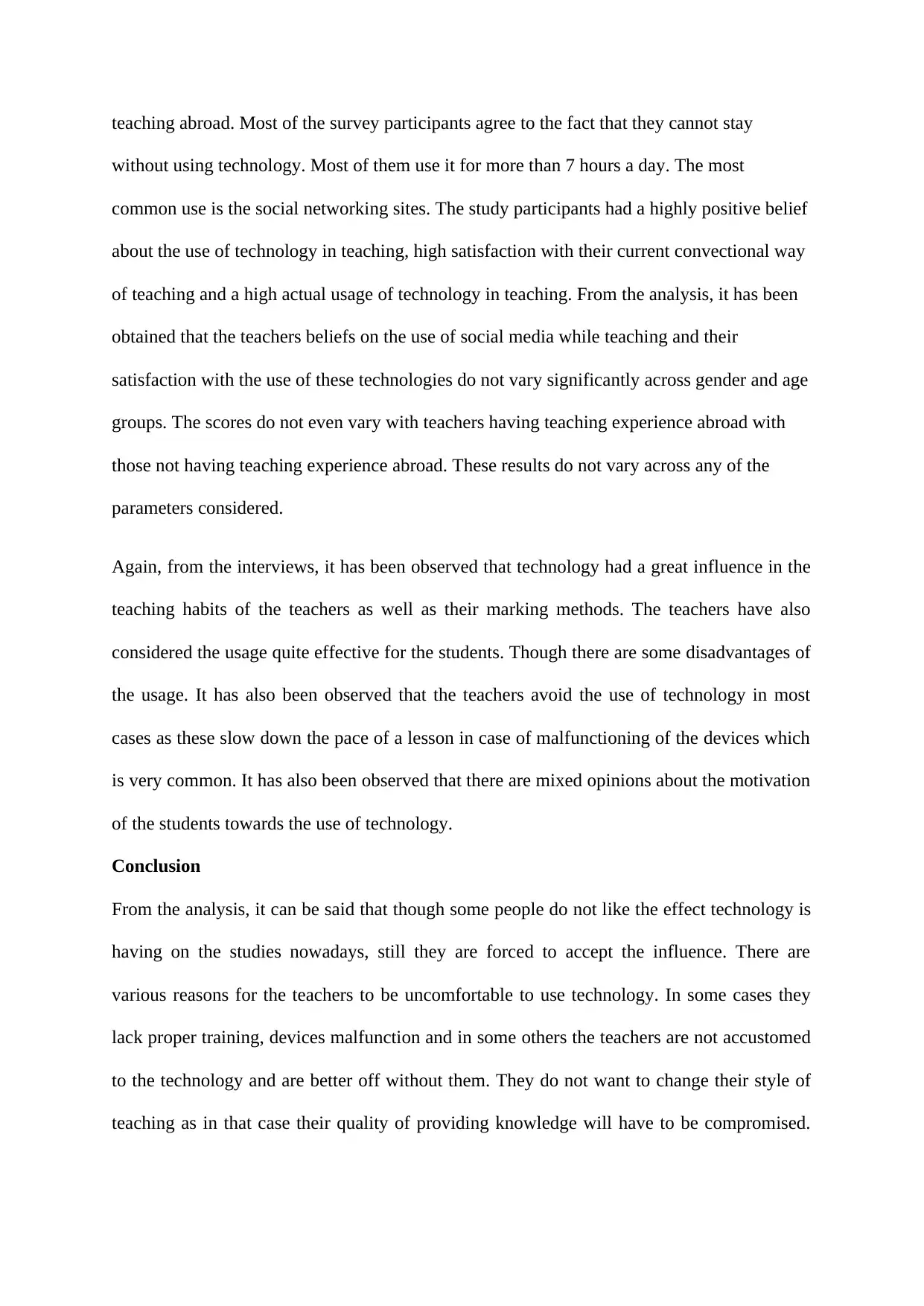
teaching abroad. Most of the survey participants agree to the fact that they cannot stay
without using technology. Most of them use it for more than 7 hours a day. The most
common use is the social networking sites. The study participants had a highly positive belief
about the use of technology in teaching, high satisfaction with their current convectional way
of teaching and a high actual usage of technology in teaching. From the analysis, it has been
obtained that the teachers beliefs on the use of social media while teaching and their
satisfaction with the use of these technologies do not vary significantly across gender and age
groups. The scores do not even vary with teachers having teaching experience abroad with
those not having teaching experience abroad. These results do not vary across any of the
parameters considered.
Again, from the interviews, it has been observed that technology had a great influence in the
teaching habits of the teachers as well as their marking methods. The teachers have also
considered the usage quite effective for the students. Though there are some disadvantages of
the usage. It has also been observed that the teachers avoid the use of technology in most
cases as these slow down the pace of a lesson in case of malfunctioning of the devices which
is very common. It has also been observed that there are mixed opinions about the motivation
of the students towards the use of technology.
Conclusion
From the analysis, it can be said that though some people do not like the effect technology is
having on the studies nowadays, still they are forced to accept the influence. There are
various reasons for the teachers to be uncomfortable to use technology. In some cases they
lack proper training, devices malfunction and in some others the teachers are not accustomed
to the technology and are better off without them. They do not want to change their style of
teaching as in that case their quality of providing knowledge will have to be compromised.
without using technology. Most of them use it for more than 7 hours a day. The most
common use is the social networking sites. The study participants had a highly positive belief
about the use of technology in teaching, high satisfaction with their current convectional way
of teaching and a high actual usage of technology in teaching. From the analysis, it has been
obtained that the teachers beliefs on the use of social media while teaching and their
satisfaction with the use of these technologies do not vary significantly across gender and age
groups. The scores do not even vary with teachers having teaching experience abroad with
those not having teaching experience abroad. These results do not vary across any of the
parameters considered.
Again, from the interviews, it has been observed that technology had a great influence in the
teaching habits of the teachers as well as their marking methods. The teachers have also
considered the usage quite effective for the students. Though there are some disadvantages of
the usage. It has also been observed that the teachers avoid the use of technology in most
cases as these slow down the pace of a lesson in case of malfunctioning of the devices which
is very common. It has also been observed that there are mixed opinions about the motivation
of the students towards the use of technology.
Conclusion
From the analysis, it can be said that though some people do not like the effect technology is
having on the studies nowadays, still they are forced to accept the influence. There are
various reasons for the teachers to be uncomfortable to use technology. In some cases they
lack proper training, devices malfunction and in some others the teachers are not accustomed
to the technology and are better off without them. They do not want to change their style of
teaching as in that case their quality of providing knowledge will have to be compromised.
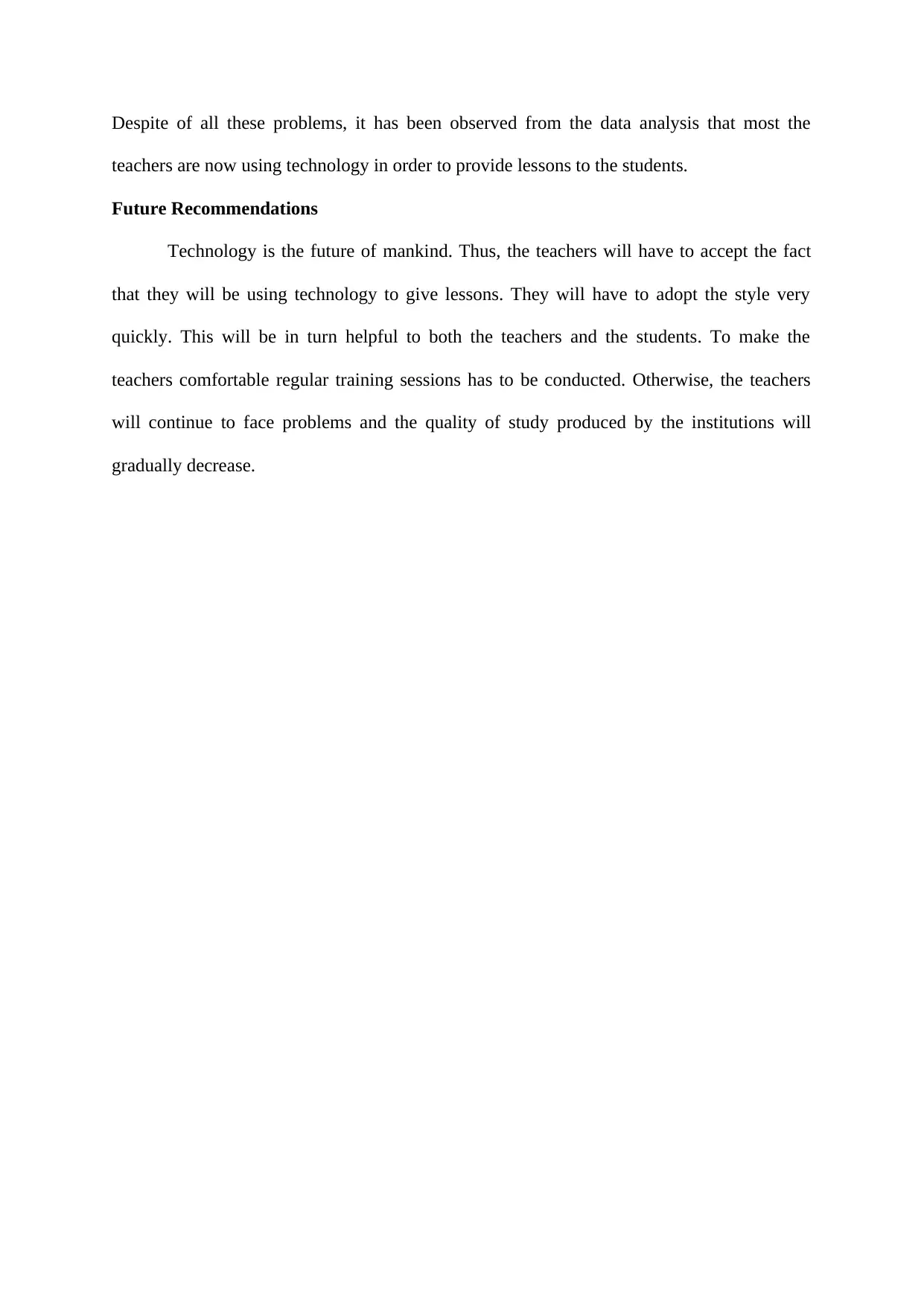
Despite of all these problems, it has been observed from the data analysis that most the
teachers are now using technology in order to provide lessons to the students.
Future Recommendations
Technology is the future of mankind. Thus, the teachers will have to accept the fact
that they will be using technology to give lessons. They will have to adopt the style very
quickly. This will be in turn helpful to both the teachers and the students. To make the
teachers comfortable regular training sessions has to be conducted. Otherwise, the teachers
will continue to face problems and the quality of study produced by the institutions will
gradually decrease.
teachers are now using technology in order to provide lessons to the students.
Future Recommendations
Technology is the future of mankind. Thus, the teachers will have to accept the fact
that they will be using technology to give lessons. They will have to adopt the style very
quickly. This will be in turn helpful to both the teachers and the students. To make the
teachers comfortable regular training sessions has to be conducted. Otherwise, the teachers
will continue to face problems and the quality of study produced by the institutions will
gradually decrease.
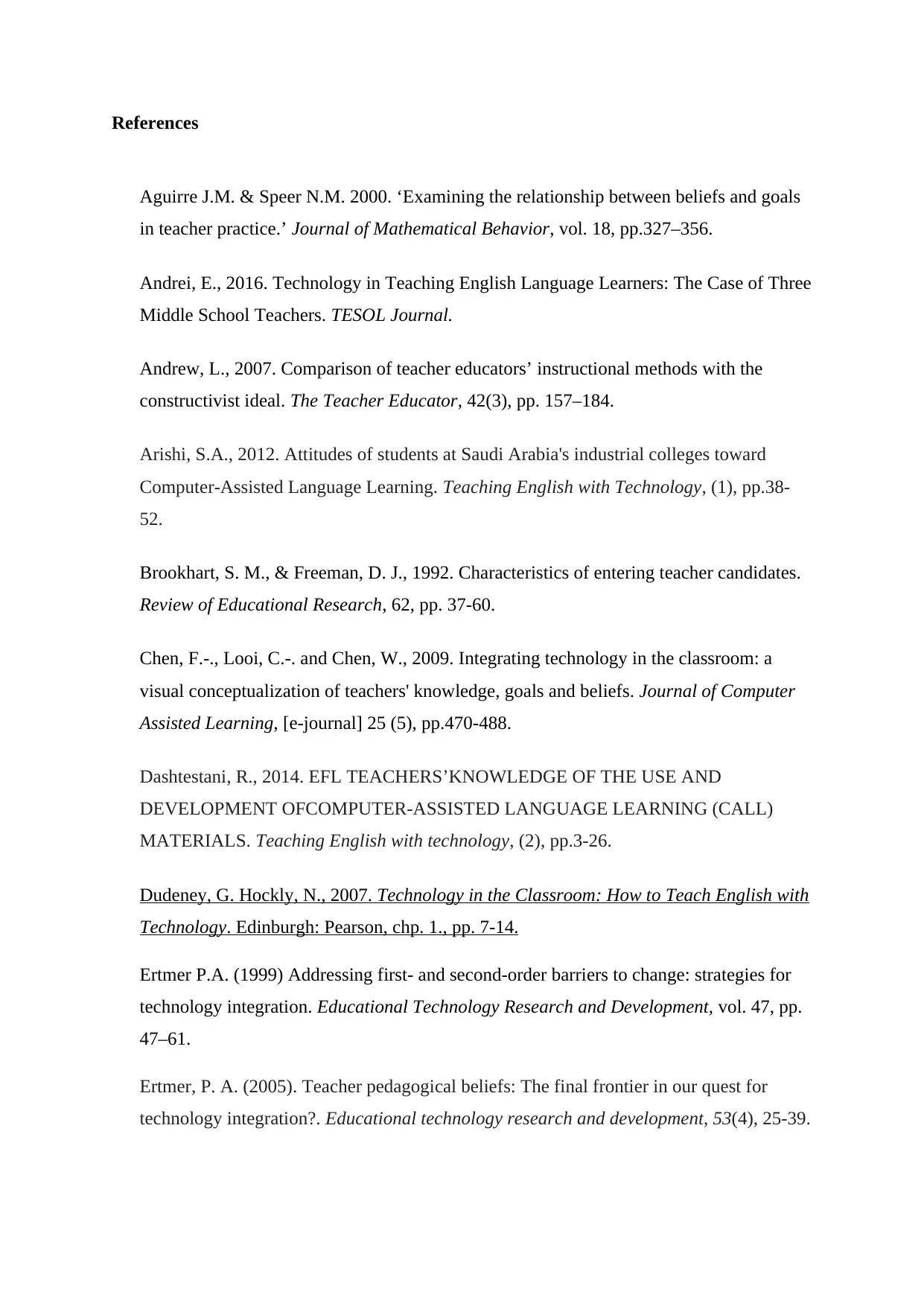
References
Aguirre J.M. & Speer N.M. 2000. ‘Examining the relationship between beliefs and goals
in teacher practice.’ Journal of Mathematical Behavior, vol. 18, pp.327–356.
Andrei, E., 2016. Technology in Teaching English Language Learners: The Case of Three
Middle School Teachers. TESOL Journal.
Andrew, L., 2007. Comparison of teacher educators’ instructional methods with the
constructivist ideal. The Teacher Educator, 42(3), pp. 157–184.
Arishi, S.A., 2012. Attitudes of students at Saudi Arabia's industrial colleges toward
Computer-Assisted Language Learning. Teaching English with Technology, (1), pp.38-
52.
Brookhart, S. M., & Freeman, D. J., 1992. Characteristics of entering teacher candidates.
Review of Educational Research, 62, pp. 37-60.
Chen, F.-., Looi, C.-. and Chen, W., 2009. Integrating technology in the classroom: a
visual conceptualization of teachers' knowledge, goals and beliefs. Journal of Computer
Assisted Learning, [e-journal] 25 (5), pp.470-488.
Dashtestani, R., 2014. EFL TEACHERS’KNOWLEDGE OF THE USE AND
DEVELOPMENT OFCOMPUTER-ASSISTED LANGUAGE LEARNING (CALL)
MATERIALS. Teaching English with technology, (2), pp.3-26.
Dudeney, G. Hockly, N., 2007. Technology in the Classroom: How to Teach English with
Technology. Edinburgh: Pearson, chp. 1., pp. 7-14.
Ertmer P.A. (1999) Addressing first- and second-order barriers to change: strategies for
technology integration. Educational Technology Research and Development, vol. 47, pp.
47–61.
Ertmer, P. A. (2005). Teacher pedagogical beliefs: The final frontier in our quest for
technology integration?. Educational technology research and development, 53(4), 25-39.
Aguirre J.M. & Speer N.M. 2000. ‘Examining the relationship between beliefs and goals
in teacher practice.’ Journal of Mathematical Behavior, vol. 18, pp.327–356.
Andrei, E., 2016. Technology in Teaching English Language Learners: The Case of Three
Middle School Teachers. TESOL Journal.
Andrew, L., 2007. Comparison of teacher educators’ instructional methods with the
constructivist ideal. The Teacher Educator, 42(3), pp. 157–184.
Arishi, S.A., 2012. Attitudes of students at Saudi Arabia's industrial colleges toward
Computer-Assisted Language Learning. Teaching English with Technology, (1), pp.38-
52.
Brookhart, S. M., & Freeman, D. J., 1992. Characteristics of entering teacher candidates.
Review of Educational Research, 62, pp. 37-60.
Chen, F.-., Looi, C.-. and Chen, W., 2009. Integrating technology in the classroom: a
visual conceptualization of teachers' knowledge, goals and beliefs. Journal of Computer
Assisted Learning, [e-journal] 25 (5), pp.470-488.
Dashtestani, R., 2014. EFL TEACHERS’KNOWLEDGE OF THE USE AND
DEVELOPMENT OFCOMPUTER-ASSISTED LANGUAGE LEARNING (CALL)
MATERIALS. Teaching English with technology, (2), pp.3-26.
Dudeney, G. Hockly, N., 2007. Technology in the Classroom: How to Teach English with
Technology. Edinburgh: Pearson, chp. 1., pp. 7-14.
Ertmer P.A. (1999) Addressing first- and second-order barriers to change: strategies for
technology integration. Educational Technology Research and Development, vol. 47, pp.
47–61.
Ertmer, P. A. (2005). Teacher pedagogical beliefs: The final frontier in our quest for
technology integration?. Educational technology research and development, 53(4), 25-39.
Secure Best Marks with AI Grader
Need help grading? Try our AI Grader for instant feedback on your assignments.
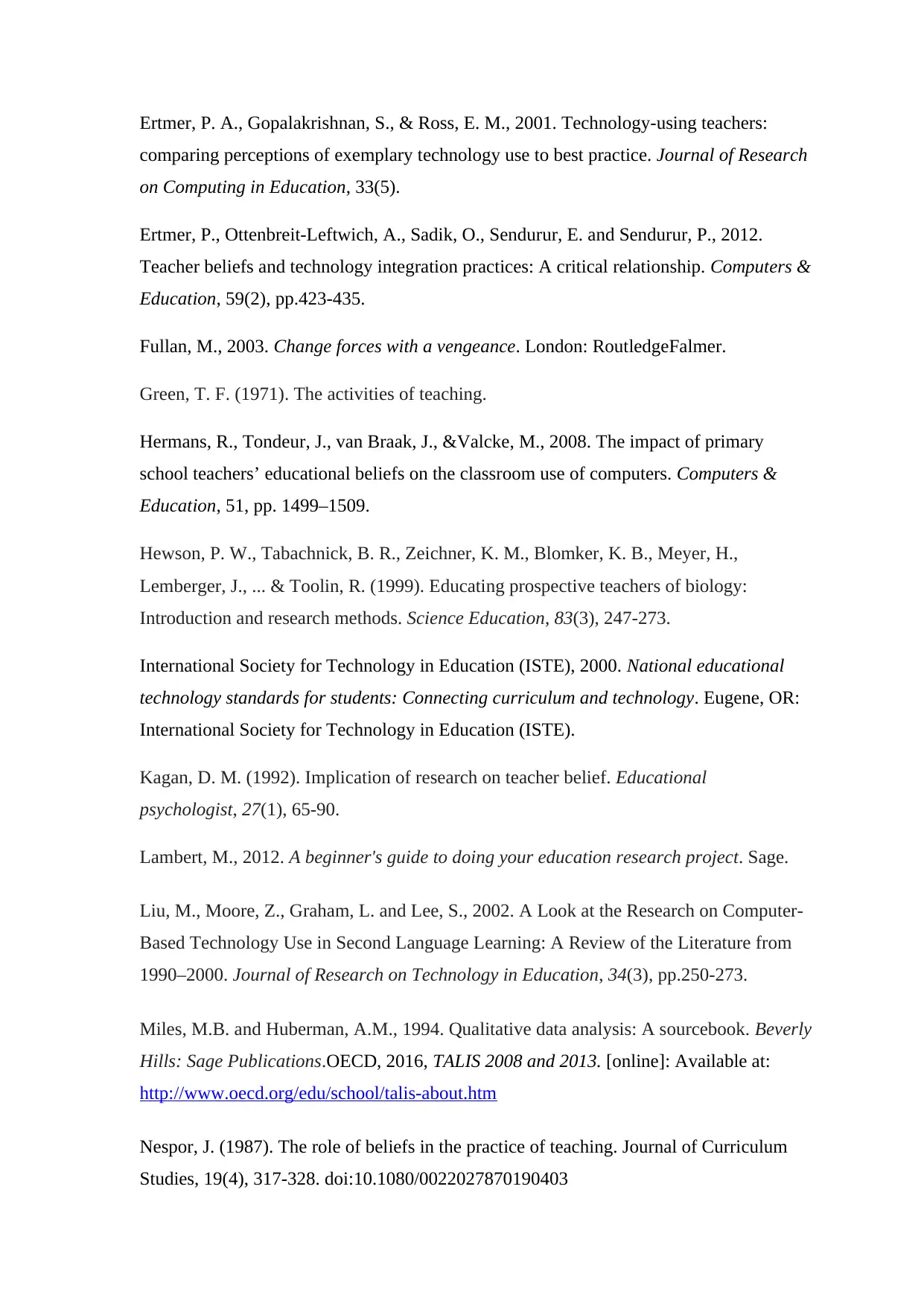
Ertmer, P. A., Gopalakrishnan, S., & Ross, E. M., 2001. Technology-using teachers:
comparing perceptions of exemplary technology use to best practice. Journal of Research
on Computing in Education, 33(5).
Ertmer, P., Ottenbreit-Leftwich, A., Sadik, O., Sendurur, E. and Sendurur, P., 2012.
Teacher beliefs and technology integration practices: A critical relationship. Computers &
Education, 59(2), pp.423-435.
Fullan, M., 2003. Change forces with a vengeance. London: RoutledgeFalmer.
Green, T. F. (1971). The activities of teaching.
Hermans, R., Tondeur, J., van Braak, J., &Valcke, M., 2008. The impact of primary
school teachers’ educational beliefs on the classroom use of computers. Computers &
Education, 51, pp. 1499–1509.
Hewson, P. W., Tabachnick, B. R., Zeichner, K. M., Blomker, K. B., Meyer, H.,
Lemberger, J., ... & Toolin, R. (1999). Educating prospective teachers of biology:
Introduction and research methods. Science Education, 83(3), 247-273.
International Society for Technology in Education (ISTE), 2000. National educational
technology standards for students: Connecting curriculum and technology. Eugene, OR:
International Society for Technology in Education (ISTE).
Kagan, D. M. (1992). Implication of research on teacher belief. Educational
psychologist, 27(1), 65-90.
Lambert, M., 2012. A beginner's guide to doing your education research project. Sage.
Liu, M., Moore, Z., Graham, L. and Lee, S., 2002. A Look at the Research on Computer-
Based Technology Use in Second Language Learning: A Review of the Literature from
1990–2000. Journal of Research on Technology in Education, 34(3), pp.250-273.
Miles, M.B. and Huberman, A.M., 1994. Qualitative data analysis: A sourcebook. Beverly
Hills: Sage Publications.OECD, 2016, TALIS 2008 and 2013. [online]: Available at:
http://www.oecd.org/edu/school/talis-about.htm
Nespor, J. (1987). The role of beliefs in the practice of teaching. Journal of Curriculum
Studies, 19(4), 317-328. doi:10.1080/0022027870190403
comparing perceptions of exemplary technology use to best practice. Journal of Research
on Computing in Education, 33(5).
Ertmer, P., Ottenbreit-Leftwich, A., Sadik, O., Sendurur, E. and Sendurur, P., 2012.
Teacher beliefs and technology integration practices: A critical relationship. Computers &
Education, 59(2), pp.423-435.
Fullan, M., 2003. Change forces with a vengeance. London: RoutledgeFalmer.
Green, T. F. (1971). The activities of teaching.
Hermans, R., Tondeur, J., van Braak, J., &Valcke, M., 2008. The impact of primary
school teachers’ educational beliefs on the classroom use of computers. Computers &
Education, 51, pp. 1499–1509.
Hewson, P. W., Tabachnick, B. R., Zeichner, K. M., Blomker, K. B., Meyer, H.,
Lemberger, J., ... & Toolin, R. (1999). Educating prospective teachers of biology:
Introduction and research methods. Science Education, 83(3), 247-273.
International Society for Technology in Education (ISTE), 2000. National educational
technology standards for students: Connecting curriculum and technology. Eugene, OR:
International Society for Technology in Education (ISTE).
Kagan, D. M. (1992). Implication of research on teacher belief. Educational
psychologist, 27(1), 65-90.
Lambert, M., 2012. A beginner's guide to doing your education research project. Sage.
Liu, M., Moore, Z., Graham, L. and Lee, S., 2002. A Look at the Research on Computer-
Based Technology Use in Second Language Learning: A Review of the Literature from
1990–2000. Journal of Research on Technology in Education, 34(3), pp.250-273.
Miles, M.B. and Huberman, A.M., 1994. Qualitative data analysis: A sourcebook. Beverly
Hills: Sage Publications.OECD, 2016, TALIS 2008 and 2013. [online]: Available at:
http://www.oecd.org/edu/school/talis-about.htm
Nespor, J. (1987). The role of beliefs in the practice of teaching. Journal of Curriculum
Studies, 19(4), 317-328. doi:10.1080/0022027870190403
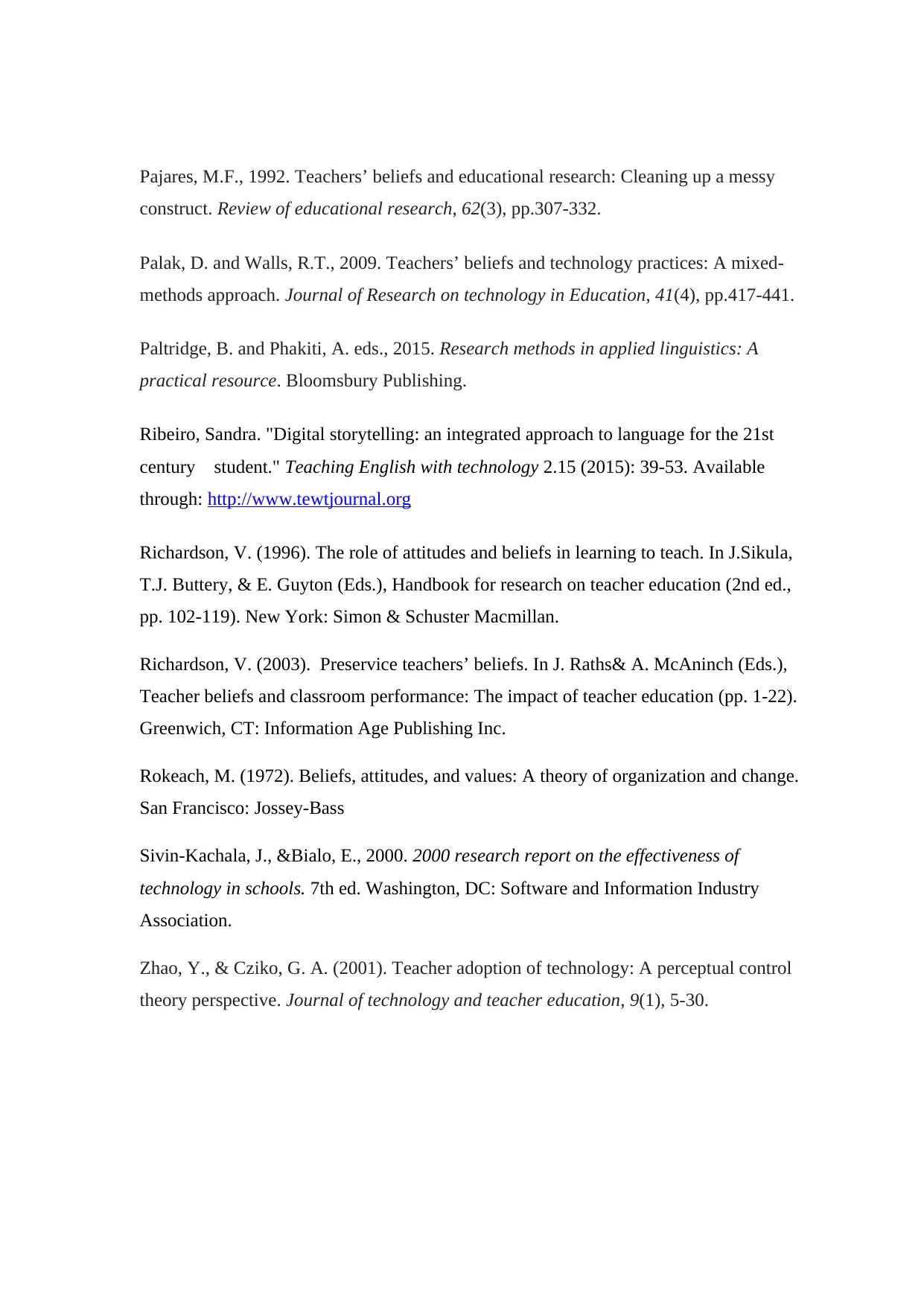
Pajares, M.F., 1992. Teachers’ beliefs and educational research: Cleaning up a messy
construct. Review of educational research, 62(3), pp.307-332.
Palak, D. and Walls, R.T., 2009. Teachers’ beliefs and technology practices: A mixed-
methods approach. Journal of Research on technology in Education, 41(4), pp.417-441.
Paltridge, B. and Phakiti, A. eds., 2015. Research methods in applied linguistics: A
practical resource. Bloomsbury Publishing.
Ribeiro, Sandra. "Digital storytelling: an integrated approach to language for the 21st
century student." Teaching English with technology 2.15 (2015): 39-53. Available
through: http://www.tewtjournal.org
Richardson, V. (1996). The role of attitudes and beliefs in learning to teach. In J.Sikula,
T.J. Buttery, & E. Guyton (Eds.), Handbook for research on teacher education (2nd ed.,
pp. 102-119). New York: Simon & Schuster Macmillan.
Richardson, V. (2003). Preservice teachers’ beliefs. In J. Raths& A. McAninch (Eds.),
Teacher beliefs and classroom performance: The impact of teacher education (pp. 1-22).
Greenwich, CT: Information Age Publishing Inc.
Rokeach, M. (1972). Beliefs, attitudes, and values: A theory of organization and change.
San Francisco: Jossey-Bass
Sivin-Kachala, J., &Bialo, E., 2000. 2000 research report on the effectiveness of
technology in schools. 7th ed. Washington, DC: Software and Information Industry
Association.
Zhao, Y., & Cziko, G. A. (2001). Teacher adoption of technology: A perceptual control
theory perspective. Journal of technology and teacher education, 9(1), 5-30.
construct. Review of educational research, 62(3), pp.307-332.
Palak, D. and Walls, R.T., 2009. Teachers’ beliefs and technology practices: A mixed-
methods approach. Journal of Research on technology in Education, 41(4), pp.417-441.
Paltridge, B. and Phakiti, A. eds., 2015. Research methods in applied linguistics: A
practical resource. Bloomsbury Publishing.
Ribeiro, Sandra. "Digital storytelling: an integrated approach to language for the 21st
century student." Teaching English with technology 2.15 (2015): 39-53. Available
through: http://www.tewtjournal.org
Richardson, V. (1996). The role of attitudes and beliefs in learning to teach. In J.Sikula,
T.J. Buttery, & E. Guyton (Eds.), Handbook for research on teacher education (2nd ed.,
pp. 102-119). New York: Simon & Schuster Macmillan.
Richardson, V. (2003). Preservice teachers’ beliefs. In J. Raths& A. McAninch (Eds.),
Teacher beliefs and classroom performance: The impact of teacher education (pp. 1-22).
Greenwich, CT: Information Age Publishing Inc.
Rokeach, M. (1972). Beliefs, attitudes, and values: A theory of organization and change.
San Francisco: Jossey-Bass
Sivin-Kachala, J., &Bialo, E., 2000. 2000 research report on the effectiveness of
technology in schools. 7th ed. Washington, DC: Software and Information Industry
Association.
Zhao, Y., & Cziko, G. A. (2001). Teacher adoption of technology: A perceptual control
theory perspective. Journal of technology and teacher education, 9(1), 5-30.

Appendix
Yes Sometimes No
n(%) n(%) n(%)
I think a good lesson plan does not need any sort of
technological assimilation to make it effective 13(56.5%) 0(0.0%) 10(43.5%)
Technological integration in a lesson hinders
application of teaching method 21(91.3%) 0(0.0%) 2(8.7%)
Changing the curriculum to incorporate technology
is difficult 11(47.8%) 0(0.0%) 12(52.2%)
It is difficult to teach pronunciation using technology 4(17.4%) 0(0.0%) 19(82.6%)
I think using technology in classroom is time-
consuming 1(4.3%) 11(47.8%) 11(47.8%)
Agree Partially agree Disagree
n(%) n(%) n(%)
It is difficult to integrate technology in a lesson,
especially in a multicultural classroom 0(0.0%) 9(39.1%) 14(60.9%)
It is difficult to integrate technology in a lesson,
especially in a multicultural classroom 1(4.4%) 11(47.8%) 11(47.8%)
I think my students are better than me when it comes
to using technology 6(26.1%) 10(43.5%) 7(30.4%)
Yes Sometimes No
n(%) n(%) n(%)
I think a good lesson plan does not need any sort of
technological assimilation to make it effective 13(56.5%) 0(0.0%) 10(43.5%)
Technological integration in a lesson hinders
application of teaching method 21(91.3%) 0(0.0%) 2(8.7%)
Changing the curriculum to incorporate technology
is difficult 11(47.8%) 0(0.0%) 12(52.2%)
It is difficult to teach pronunciation using technology 4(17.4%) 0(0.0%) 19(82.6%)
I think using technology in classroom is time-
consuming 1(4.3%) 11(47.8%) 11(47.8%)
Agree Partially agree Disagree
n(%) n(%) n(%)
It is difficult to integrate technology in a lesson,
especially in a multicultural classroom 0(0.0%) 9(39.1%) 14(60.9%)
It is difficult to integrate technology in a lesson,
especially in a multicultural classroom 1(4.4%) 11(47.8%) 11(47.8%)
I think my students are better than me when it comes
to using technology 6(26.1%) 10(43.5%) 7(30.4%)
Paraphrase This Document
Need a fresh take? Get an instant paraphrase of this document with our AI Paraphraser
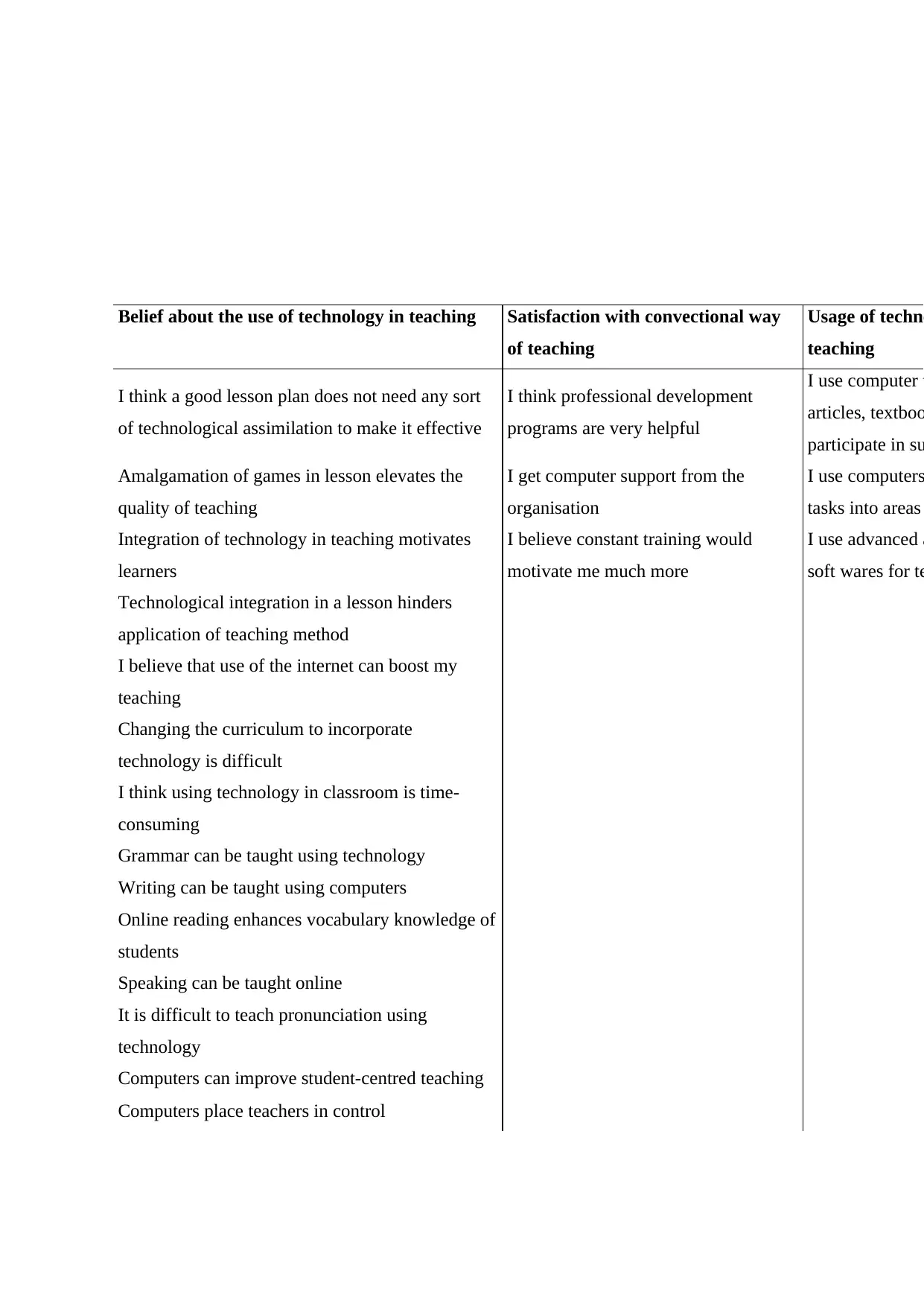
Belief about the use of technology in teaching Satisfaction with convectional way
of teaching
Usage of techno
teaching
I think a good lesson plan does not need any sort
of technological assimilation to make it effective
I think professional development
programs are very helpful
I use computer t
articles, textboo
participate in su
Amalgamation of games in lesson elevates the
quality of teaching
I get computer support from the
organisation
I use computers
tasks into areas
Integration of technology in teaching motivates
learners
I believe constant training would
motivate me much more
I use advanced a
soft wares for te
Technological integration in a lesson hinders
application of teaching method
I believe that use of the internet can boost my
teaching
Changing the curriculum to incorporate
technology is difficult
I think using technology in classroom is time-
consuming
Grammar can be taught using technology
Writing can be taught using computers
Online reading enhances vocabulary knowledge of
students
Speaking can be taught online
It is difficult to teach pronunciation using
technology
Computers can improve student-centred teaching
Computers place teachers in control
of teaching
Usage of techno
teaching
I think a good lesson plan does not need any sort
of technological assimilation to make it effective
I think professional development
programs are very helpful
I use computer t
articles, textboo
participate in su
Amalgamation of games in lesson elevates the
quality of teaching
I get computer support from the
organisation
I use computers
tasks into areas
Integration of technology in teaching motivates
learners
I believe constant training would
motivate me much more
I use advanced a
soft wares for te
Technological integration in a lesson hinders
application of teaching method
I believe that use of the internet can boost my
teaching
Changing the curriculum to incorporate
technology is difficult
I think using technology in classroom is time-
consuming
Grammar can be taught using technology
Writing can be taught using computers
Online reading enhances vocabulary knowledge of
students
Speaking can be taught online
It is difficult to teach pronunciation using
technology
Computers can improve student-centred teaching
Computers place teachers in control

It is difficult to integrate technology in a lesson,
especially in a multicultural classroom
I think my students are better than me when it
comes to using technology
Frequency
(n)
Percentage
(%)
Cumulative
Percentage
Japan; China 1 4.3% 4.3
Japan; Europe 1 4.3% 8.7
Japan; Korea 1 4.3% 13.0
Japan; Korea; Australia; Dominican Republic 1 4.3% 17.4
Mongolia 1 4.3% 21.7
Pakistan 1 4.3% 26.1
Russia and Australia 1 4.3% 30.4
China 2 8.7% 39.1
Nepal 2 8.7% 47.8
Korea 3 13.0% 60.9
Philippines 3 13.0% 73.9
No 6 26.1% 100.0
Total 23 100.0%
Frequency
(n)
Percentage
(%)
Cumulative
Percentage
children;adults 1 4.3% 4.3
teenagers;adults 1 4.3% 8.7
children;teenagers;adults 4 17.4% 26.1
children 4 17.4% 43.5
teenagers 4 17.4% 60.9
Adults 9 39.1% 100.0
Total 23 100.0%
Frequency
(n)
Percentage
(%)
Cumulative
Percentage
1-2 hours 3 13.0% 13.0
2-4 hours 5 21.7% 34.8
4-7 hours 7 30.4% 65.2
More than 7 hours 8 34.8% 100.0
especially in a multicultural classroom
I think my students are better than me when it
comes to using technology
Frequency
(n)
Percentage
(%)
Cumulative
Percentage
Japan; China 1 4.3% 4.3
Japan; Europe 1 4.3% 8.7
Japan; Korea 1 4.3% 13.0
Japan; Korea; Australia; Dominican Republic 1 4.3% 17.4
Mongolia 1 4.3% 21.7
Pakistan 1 4.3% 26.1
Russia and Australia 1 4.3% 30.4
China 2 8.7% 39.1
Nepal 2 8.7% 47.8
Korea 3 13.0% 60.9
Philippines 3 13.0% 73.9
No 6 26.1% 100.0
Total 23 100.0%
Frequency
(n)
Percentage
(%)
Cumulative
Percentage
children;adults 1 4.3% 4.3
teenagers;adults 1 4.3% 8.7
children;teenagers;adults 4 17.4% 26.1
children 4 17.4% 43.5
teenagers 4 17.4% 60.9
Adults 9 39.1% 100.0
Total 23 100.0%
Frequency
(n)
Percentage
(%)
Cumulative
Percentage
1-2 hours 3 13.0% 13.0
2-4 hours 5 21.7% 34.8
4-7 hours 7 30.4% 65.2
More than 7 hours 8 34.8% 100.0
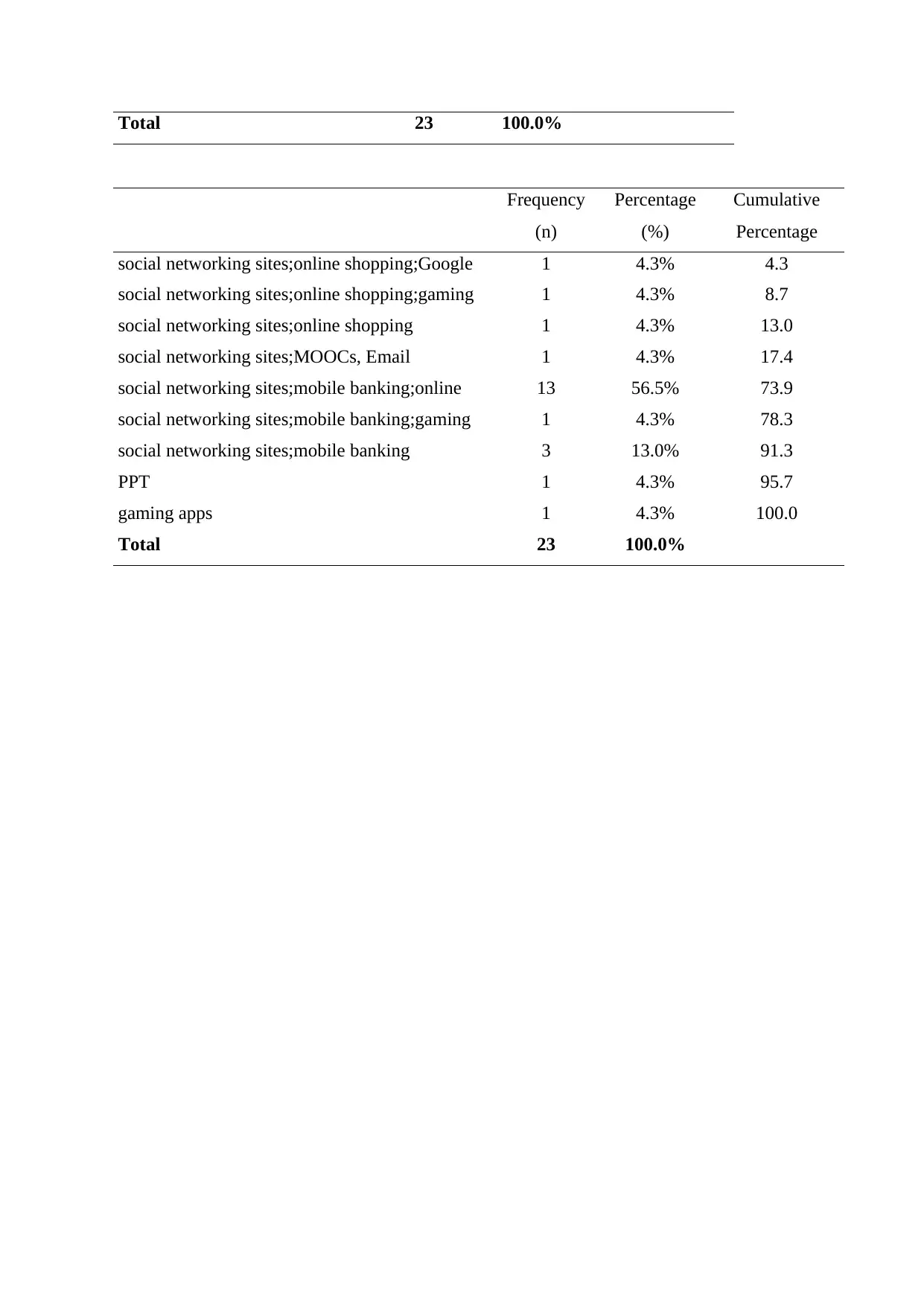
Total 23 100.0%
Frequency
(n)
Percentage
(%)
Cumulative
Percentage
social networking sites;online shopping;Google 1 4.3% 4.3
social networking sites;online shopping;gaming 1 4.3% 8.7
social networking sites;online shopping 1 4.3% 13.0
social networking sites;MOOCs, Email 1 4.3% 17.4
social networking sites;mobile banking;online 13 56.5% 73.9
social networking sites;mobile banking;gaming 1 4.3% 78.3
social networking sites;mobile banking 3 13.0% 91.3
PPT 1 4.3% 95.7
gaming apps 1 4.3% 100.0
Total 23 100.0%
Frequency
(n)
Percentage
(%)
Cumulative
Percentage
social networking sites;online shopping;Google 1 4.3% 4.3
social networking sites;online shopping;gaming 1 4.3% 8.7
social networking sites;online shopping 1 4.3% 13.0
social networking sites;MOOCs, Email 1 4.3% 17.4
social networking sites;mobile banking;online 13 56.5% 73.9
social networking sites;mobile banking;gaming 1 4.3% 78.3
social networking sites;mobile banking 3 13.0% 91.3
PPT 1 4.3% 95.7
gaming apps 1 4.3% 100.0
Total 23 100.0%
Secure Best Marks with AI Grader
Need help grading? Try our AI Grader for instant feedback on your assignments.
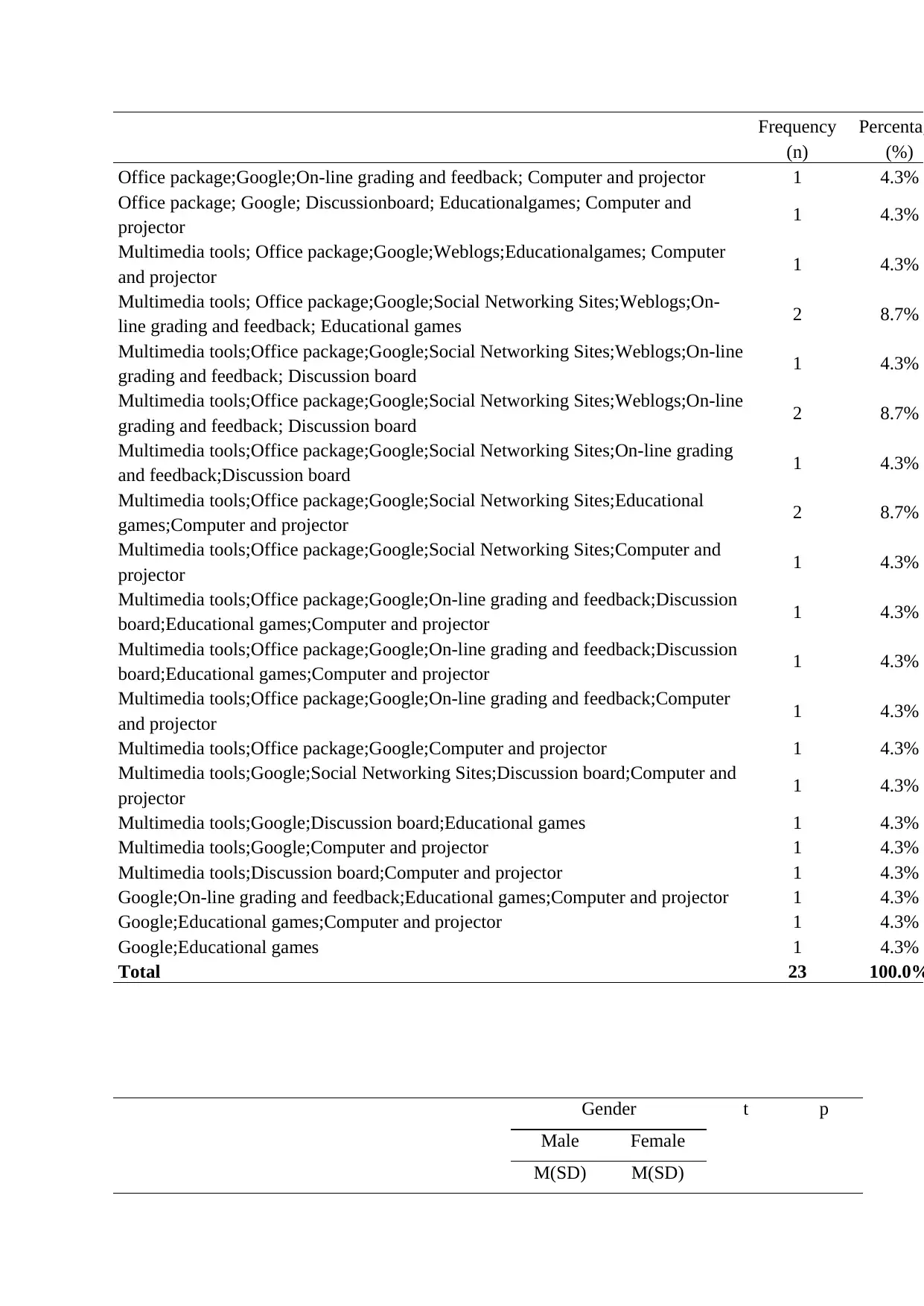
Frequency
(n)
Percentag
(%)
Office package;Google;On-line grading and feedback; Computer and projector 1 4.3%
Office package; Google; Discussionboard; Educationalgames; Computer and
projector 1 4.3%
Multimedia tools; Office package;Google;Weblogs;Educationalgames; Computer
and projector 1 4.3%
Multimedia tools; Office package;Google;Social Networking Sites;Weblogs;On-
line grading and feedback; Educational games 2 8.7%
Multimedia tools;Office package;Google;Social Networking Sites;Weblogs;On-line
grading and feedback; Discussion board 1 4.3%
Multimedia tools;Office package;Google;Social Networking Sites;Weblogs;On-line
grading and feedback; Discussion board 2 8.7%
Multimedia tools;Office package;Google;Social Networking Sites;On-line grading
and feedback;Discussion board 1 4.3%
Multimedia tools;Office package;Google;Social Networking Sites;Educational
games;Computer and projector 2 8.7%
Multimedia tools;Office package;Google;Social Networking Sites;Computer and
projector 1 4.3%
Multimedia tools;Office package;Google;On-line grading and feedback;Discussion
board;Educational games;Computer and projector 1 4.3%
Multimedia tools;Office package;Google;On-line grading and feedback;Discussion
board;Educational games;Computer and projector 1 4.3%
Multimedia tools;Office package;Google;On-line grading and feedback;Computer
and projector 1 4.3%
Multimedia tools;Office package;Google;Computer and projector 1 4.3%
Multimedia tools;Google;Social Networking Sites;Discussion board;Computer and
projector 1 4.3%
Multimedia tools;Google;Discussion board;Educational games 1 4.3%
Multimedia tools;Google;Computer and projector 1 4.3%
Multimedia tools;Discussion board;Computer and projector 1 4.3%
Google;On-line grading and feedback;Educational games;Computer and projector 1 4.3%
Google;Educational games;Computer and projector 1 4.3%
Google;Educational games 1 4.3%
Total 23 100.0%
Gender t p
Male Female
M(SD) M(SD)
(n)
Percentag
(%)
Office package;Google;On-line grading and feedback; Computer and projector 1 4.3%
Office package; Google; Discussionboard; Educationalgames; Computer and
projector 1 4.3%
Multimedia tools; Office package;Google;Weblogs;Educationalgames; Computer
and projector 1 4.3%
Multimedia tools; Office package;Google;Social Networking Sites;Weblogs;On-
line grading and feedback; Educational games 2 8.7%
Multimedia tools;Office package;Google;Social Networking Sites;Weblogs;On-line
grading and feedback; Discussion board 1 4.3%
Multimedia tools;Office package;Google;Social Networking Sites;Weblogs;On-line
grading and feedback; Discussion board 2 8.7%
Multimedia tools;Office package;Google;Social Networking Sites;On-line grading
and feedback;Discussion board 1 4.3%
Multimedia tools;Office package;Google;Social Networking Sites;Educational
games;Computer and projector 2 8.7%
Multimedia tools;Office package;Google;Social Networking Sites;Computer and
projector 1 4.3%
Multimedia tools;Office package;Google;On-line grading and feedback;Discussion
board;Educational games;Computer and projector 1 4.3%
Multimedia tools;Office package;Google;On-line grading and feedback;Discussion
board;Educational games;Computer and projector 1 4.3%
Multimedia tools;Office package;Google;On-line grading and feedback;Computer
and projector 1 4.3%
Multimedia tools;Office package;Google;Computer and projector 1 4.3%
Multimedia tools;Google;Social Networking Sites;Discussion board;Computer and
projector 1 4.3%
Multimedia tools;Google;Discussion board;Educational games 1 4.3%
Multimedia tools;Google;Computer and projector 1 4.3%
Multimedia tools;Discussion board;Computer and projector 1 4.3%
Google;On-line grading and feedback;Educational games;Computer and projector 1 4.3%
Google;Educational games;Computer and projector 1 4.3%
Google;Educational games 1 4.3%
Total 23 100.0%
Gender t p
Male Female
M(SD) M(SD)
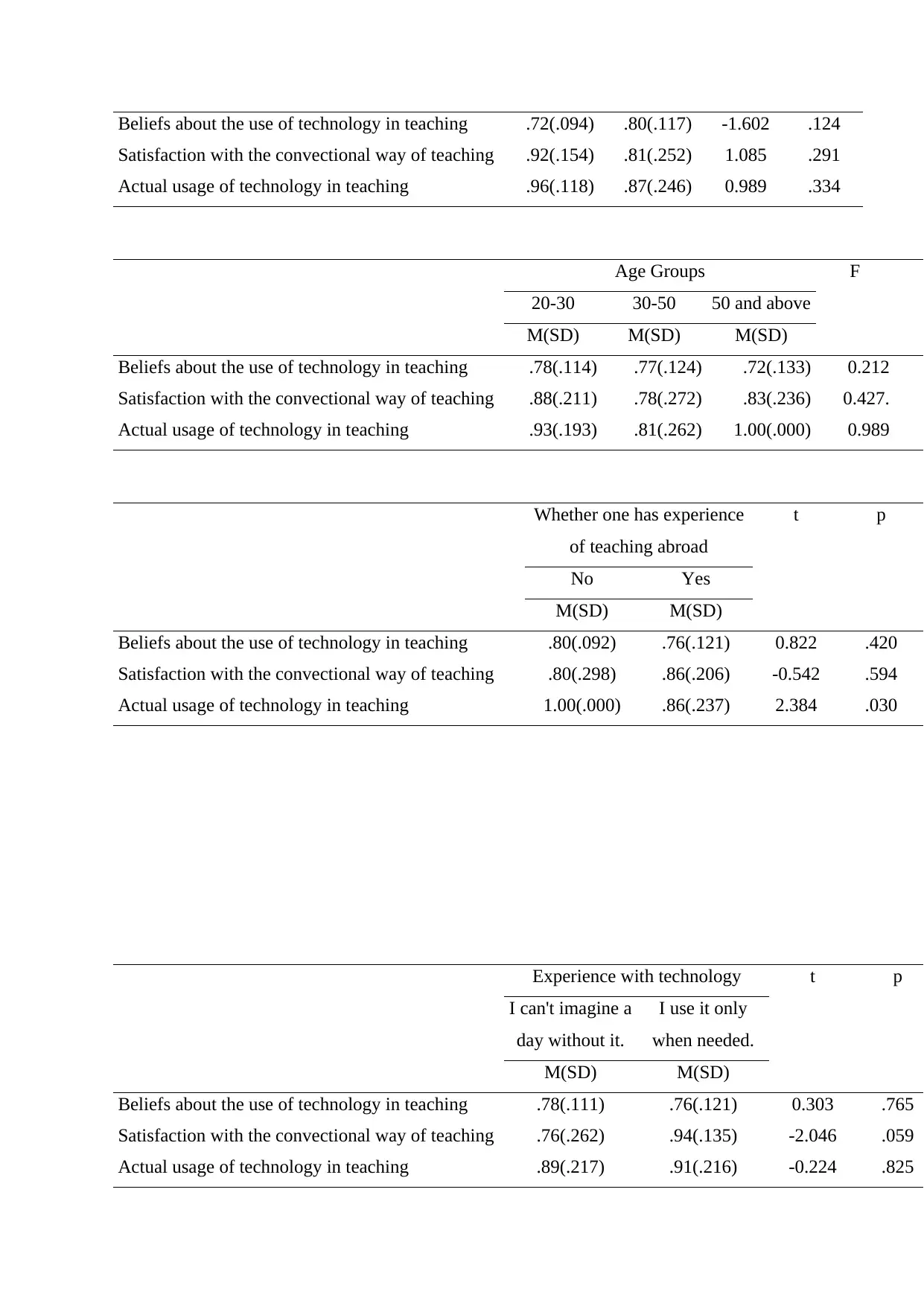
Beliefs about the use of technology in teaching .72(.094) .80(.117) -1.602 .124
Satisfaction with the convectional way of teaching .92(.154) .81(.252) 1.085 .291
Actual usage of technology in teaching .96(.118) .87(.246) 0.989 .334
Age Groups F
20-30 30-50 50 and above
M(SD) M(SD) M(SD)
Beliefs about the use of technology in teaching .78(.114) .77(.124) .72(.133) 0.212
Satisfaction with the convectional way of teaching .88(.211) .78(.272) .83(.236) 0.427.
Actual usage of technology in teaching .93(.193) .81(.262) 1.00(.000) 0.989
Whether one has experience
of teaching abroad
t p
No Yes
M(SD) M(SD)
Beliefs about the use of technology in teaching .80(.092) .76(.121) 0.822 .420
Satisfaction with the convectional way of teaching .80(.298) .86(.206) -0.542 .594
Actual usage of technology in teaching 1.00(.000) .86(.237) 2.384 .030
Experience with technology t p
I can't imagine a
day without it.
I use it only
when needed.
M(SD) M(SD)
Beliefs about the use of technology in teaching .78(.111) .76(.121) 0.303 .765
Satisfaction with the convectional way of teaching .76(.262) .94(.135) -2.046 .059
Actual usage of technology in teaching .89(.217) .91(.216) -0.224 .825
Satisfaction with the convectional way of teaching .92(.154) .81(.252) 1.085 .291
Actual usage of technology in teaching .96(.118) .87(.246) 0.989 .334
Age Groups F
20-30 30-50 50 and above
M(SD) M(SD) M(SD)
Beliefs about the use of technology in teaching .78(.114) .77(.124) .72(.133) 0.212
Satisfaction with the convectional way of teaching .88(.211) .78(.272) .83(.236) 0.427.
Actual usage of technology in teaching .93(.193) .81(.262) 1.00(.000) 0.989
Whether one has experience
of teaching abroad
t p
No Yes
M(SD) M(SD)
Beliefs about the use of technology in teaching .80(.092) .76(.121) 0.822 .420
Satisfaction with the convectional way of teaching .80(.298) .86(.206) -0.542 .594
Actual usage of technology in teaching 1.00(.000) .86(.237) 2.384 .030
Experience with technology t p
I can't imagine a
day without it.
I use it only
when needed.
M(SD) M(SD)
Beliefs about the use of technology in teaching .78(.111) .76(.121) 0.303 .765
Satisfaction with the convectional way of teaching .76(.262) .94(.135) -2.046 .059
Actual usage of technology in teaching .89(.217) .91(.216) -0.224 .825
1 out of 42
Related Documents
Your All-in-One AI-Powered Toolkit for Academic Success.
+13062052269
info@desklib.com
Available 24*7 on WhatsApp / Email
![[object Object]](/_next/static/media/star-bottom.7253800d.svg)
Unlock your academic potential
© 2024 | Zucol Services PVT LTD | All rights reserved.





